




I write this as I begin my third month as the new and second CEO of The Cibolo Center for Conservation. That fact alone is remarkable: In the 36 years of The Cibolo’s existence, there have been only two CEOs, and just barely so! Among Carolyn’s many well-deserved accolades is her exceptional leadership over more than three decades.
More noteworthy than the length of Carolyn’s tenure are the countless achievements in fostering the conservation of land and water resources and teaching and inspiring young and old to love nature and care for our common home. As I, in my first two months, have begun to understand the mission of The Cibolo, along with the many challenges and opportunities along its 36-year journey, three words come to my mind in describing Carolyn’s leadership: resolute, visionary, and community.
As we have begun to work together, I have said to Carolyn more than once that I would never have had the courage and resolve over many years to lead the project she and Brent steadfastly began in 1988 from nothing... actually from less than nothing! As Carolyn wrote, “When my children were young, I would take them to the same creek that my ancestors had enjoyed... But it was littered with garbage of every sort, and children could no longer wade without fear of cut feet or worse.”
Carolyn’s vision began modestly with the desire to make Cibolo Creek and its watershed safe for the Boerne community to enjoy. Her dreams that followed and have become real were anything but modest: the numerous hiking trails at
the Nature Center and Herff Farm; the many educational offerings, including most recently The Nest Nature School; protection of vital water and land resources; weekly farmers market; and preservation of wide-open natural spaces where our cluttered lives can find peace, comfort, and grace.
As those who have supported Carolyn know, she credits The Cibolo’s success to volunteers, donors, and fellow visionaries. But The Cibolo would never have evolved into Boerne’s crown jewel without Carolyn’s care and concern for the Hill Country and those who live here. In particular, her love for the Hill Country’s children and grandchildren opened their eyes, minds, and hearts to the wonders of nature.
With excitement and humility, I am honored to serve this community and to lead The Cibolo as its second CEO. Certainly not for 36 years—I would be well over 100 years old! But enough time to develop a strategic plan approved by The Cibolo’s Board of Directors. Long enough to work with the Board, our talented staff, and volunteers to implement the plan that will continue to grow The Cibolo’s footprint and impact in the community. Long enough also to secure the necessary funding to ensure The Cibolo endures as a center for education, community, the conservation and stewardship of water and land resources, and natural beauty.
I look forward to getting to know you all,
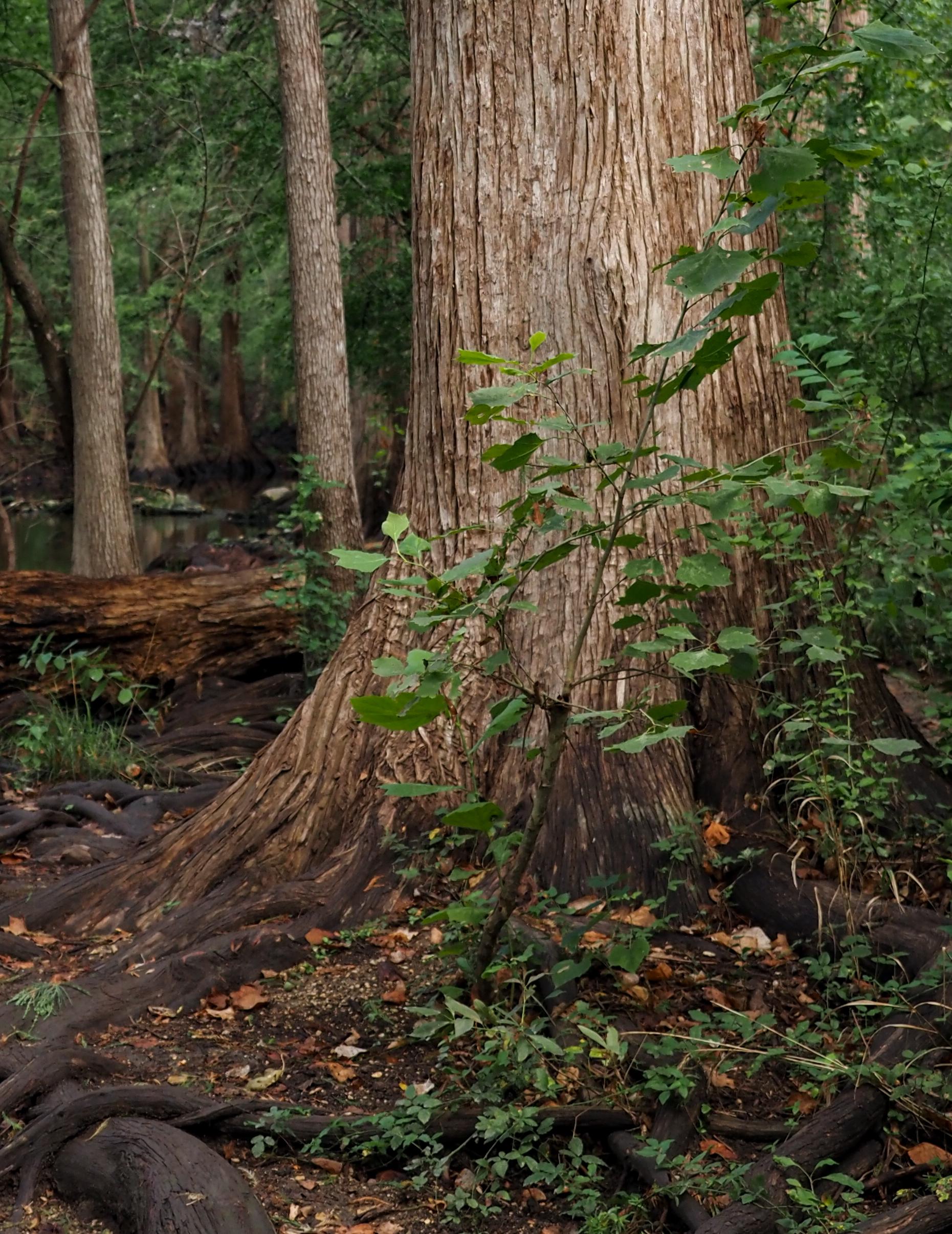
Thomas Mengler Chief Executive Officer
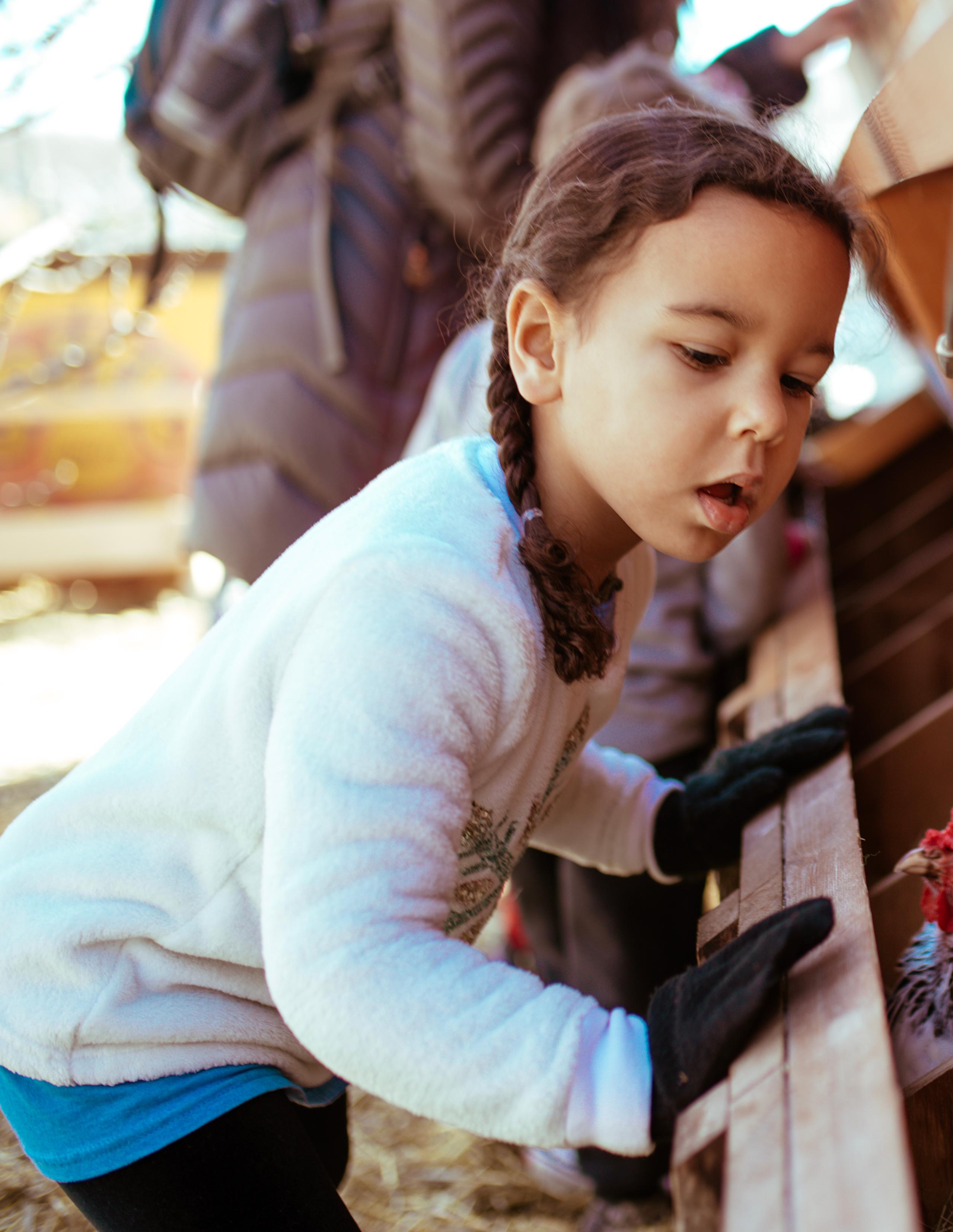
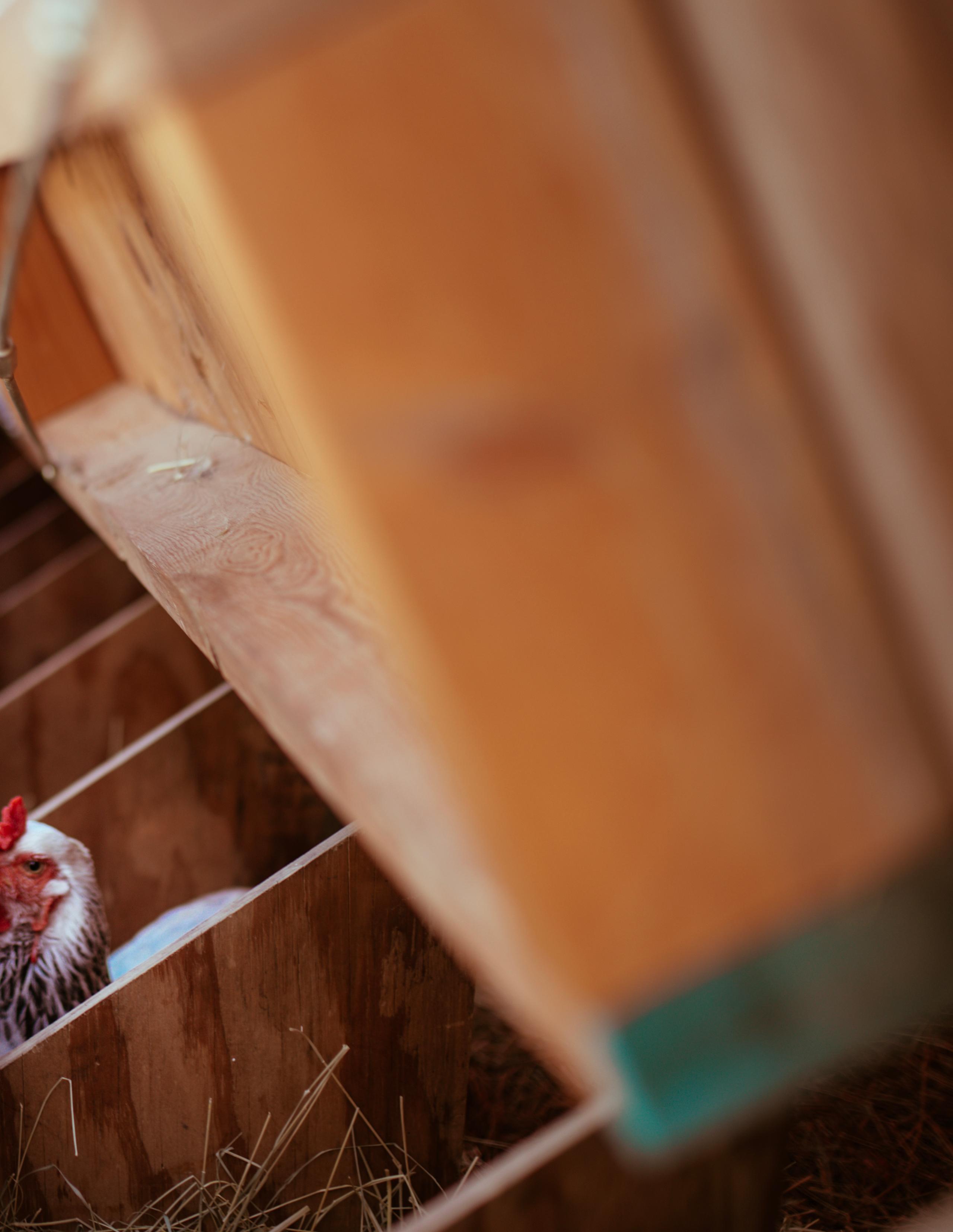
The Cibolo Center for Conservation exists to promote the conservation of natural resources through education and stewardship. If you want to get involved we’d love to have you on board. So, how can we help? Please let us know what we can do for you or how you’d like to contribute to the efforts of The Cibolo. If the list of contacts below doesn’t seem to fit your need please contact nature@cibolo.org and we will be sure someone can point you in the right direction.
Make a Donation
Visit cibolo.org/donate
Volunteering
Jennifer Smith, Volunteer Coordinator jennifers@cibolo.org
Nature Center Programs (Camp, Field Trips)
Noah Lawrence, Nature Education Director nlawrence@cibolo.org
Herff Farm Programs (Farmers Market)
Sarah Berringer, Farm Education Director sarahb@cibolo.org
Citizen Science & Research
Sarah Vergara, Research Scientist sarahv@cibolo.org
Land Stewardship
David Touchon, Land Manager david@cibolo.org
The Nest
Alysa Meeks, The Nest Director alysa@cibolo.org
Legacy & Land Gifts
Carolyn Chipman Evans, Founder carolyn@cibolo.org
Development
Dianna Hopkins, Chief Development Officer dianna@cibolo.org
Grants & Fundraising
Brittany Whalen, Development Director brittany@cibolo.org
Events & Rentals
Michele Guyer, Special Events Coordinator michele@cibolo.org
Park Rangers & Facilities
Lee Garteiser, Buildings & Grounds Manager lee@cibolo.org
Social Media
Sydney Ward, Marketing Coordinator sydney@cibolo.org
PR & Marketing
Brian Davenport, Communications Director coms@cibolo.org
Visitor Center
Cindy Glass, Office Manager cglass@cibolo.org (830) 249-4616
Open Monday - Friday 9am - 4:30pm
Nature Center Trails
Open to the public every day from dawn - dusk
Herff Farm
Open during farmers market Sat. 9am - 1pm
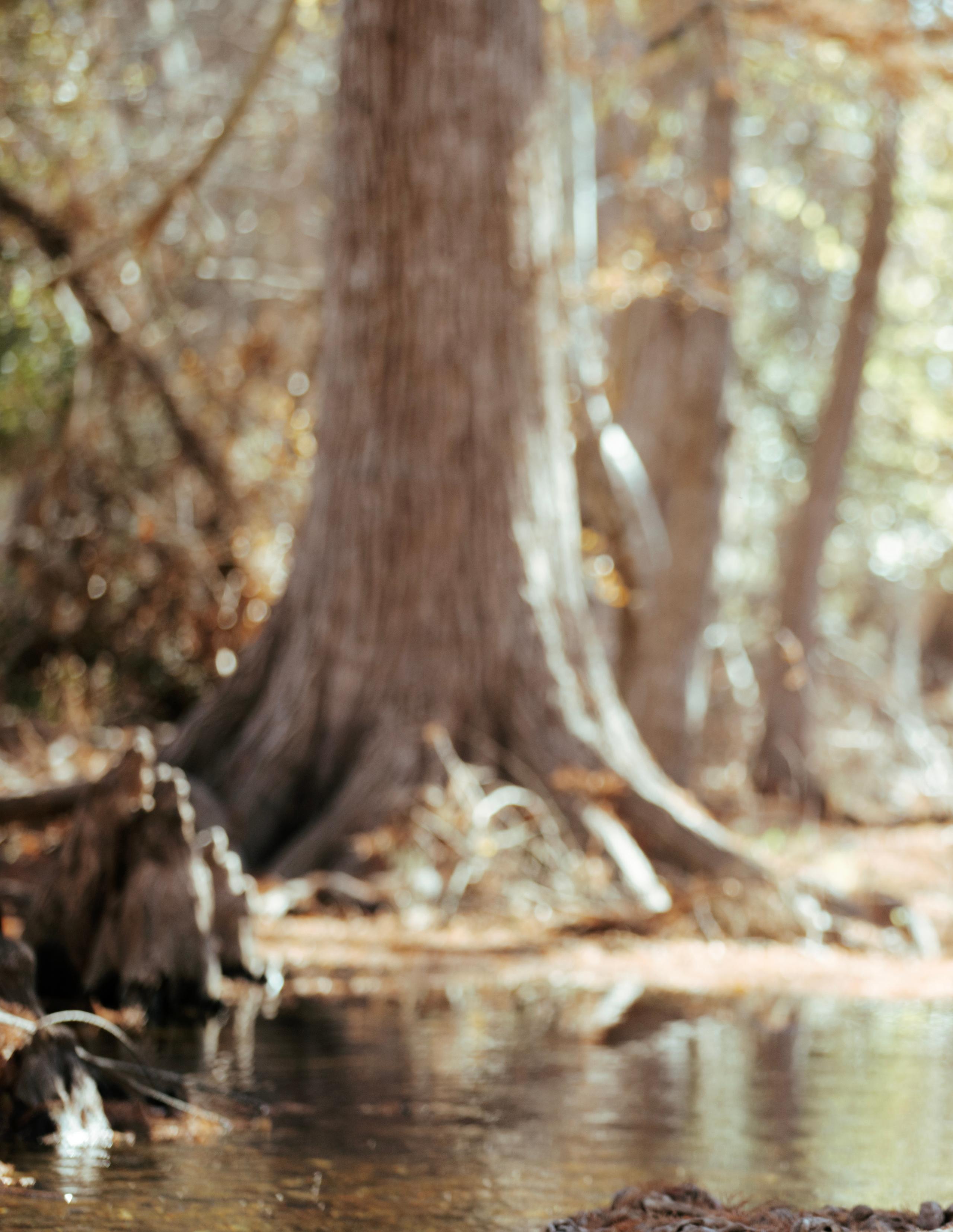
When you step onto the grounds of The Cibolo Center for Conservation, you’re entering a living testament to the power of nature to transform lives and strengthen communities. Since our founding 36 years ago, we’ve been committed to making sure that everyone in our region has access to the beauty, peace, and lessons that nature provides.
But The Cibolo is so much more than a beautiful landscape. It’s a hub of education, conservation, and leadership development, working to ensure that our community thrives—today and into the future. Our mission isn’t just about the land; it’s about people. And the impact we’re making is something you can see, feel, and even measure.
Education is one of the biggest areas where we’ve made an impact. In the past year alone, nearly 15,000 children have visited The Cibolo for hands-on outdoor learning experiences. These aren’t just field trips—they’re opportunities for students to develop a deep connection with the environment while learning vital STEM concepts. Our programs inspire curiosity, foster leadership, and help children develop critical thinking skills. With our expanding outreach to Title 1 schools, we’re ensuring that no child misses out on this invaluable opportunity to learn and grow.
Water is the lifeblood of our region, and The Cibolo takes its responsibility to protect this precious resource seriously. The Cibolo Creek, which flows through our lands, feeds directly into the Trinity and Edwards Aquifers—vital water sources for millions of people in Texas. Our work includes protecting and enhancing the quality of water that reaches these aquifers through sustainable land management, rainwater harvesting systems, and educational workshops on water conservation. We’ve helped households across the region reduce their water usage and adopt sustainable practices. Our efforts go beyond education—we lead by example, demonstrating what it takes to protect our aquifers and live sustainably in Texas.
Dianna Hopkins Chief Development Officer
Our volunteers are the heartbeat of The Cibolo, and their dedication makes everything we do possible. Over 400 volunteers have donated their time, helping with everything from trail maintenance to leading nature tours. We’ve built a community that’s engaged, committed, and proud to give back.
The Cibolo is home to over 160 acres of protected land, a sanctuary for local wildlife, and a place where conservation isn’t just talked about— it’s actively practiced. Through our Protect and Preserve Initiative, we’ve acquired ownership of over 100 acres, ensuring these natural spaces are protected for generations to come. Through the Cibolo Conservation Corridor, we’ve worked with landowners across the region to conserve an additional 850 acres of vital watershed lands, contributing up to six million gallons of water per day to the Trinity and Edwards Aquifers.
As the needs of our community evolve, so does The Cibolo. We are leading the charge to make Boerne a model resilient community with initiatives like our sustainable living workshops, farmers market, and leadership development programs. Through these efforts, we’re equipping individuals and businesses alike with the tools to make better choices for our environment, health, and future.
Everything we do is rooted in our love for nature and our love for this community. When you visit The Cibolo, support our programs, or attend one of our events, you become part of something bigger—a movement to make our region more vibrant, resilient, and connected.
Thank you for being part of this journey with us. Together, we can continue to grow, protect, and inspire the next generation of leaders who will carry our mission forward.
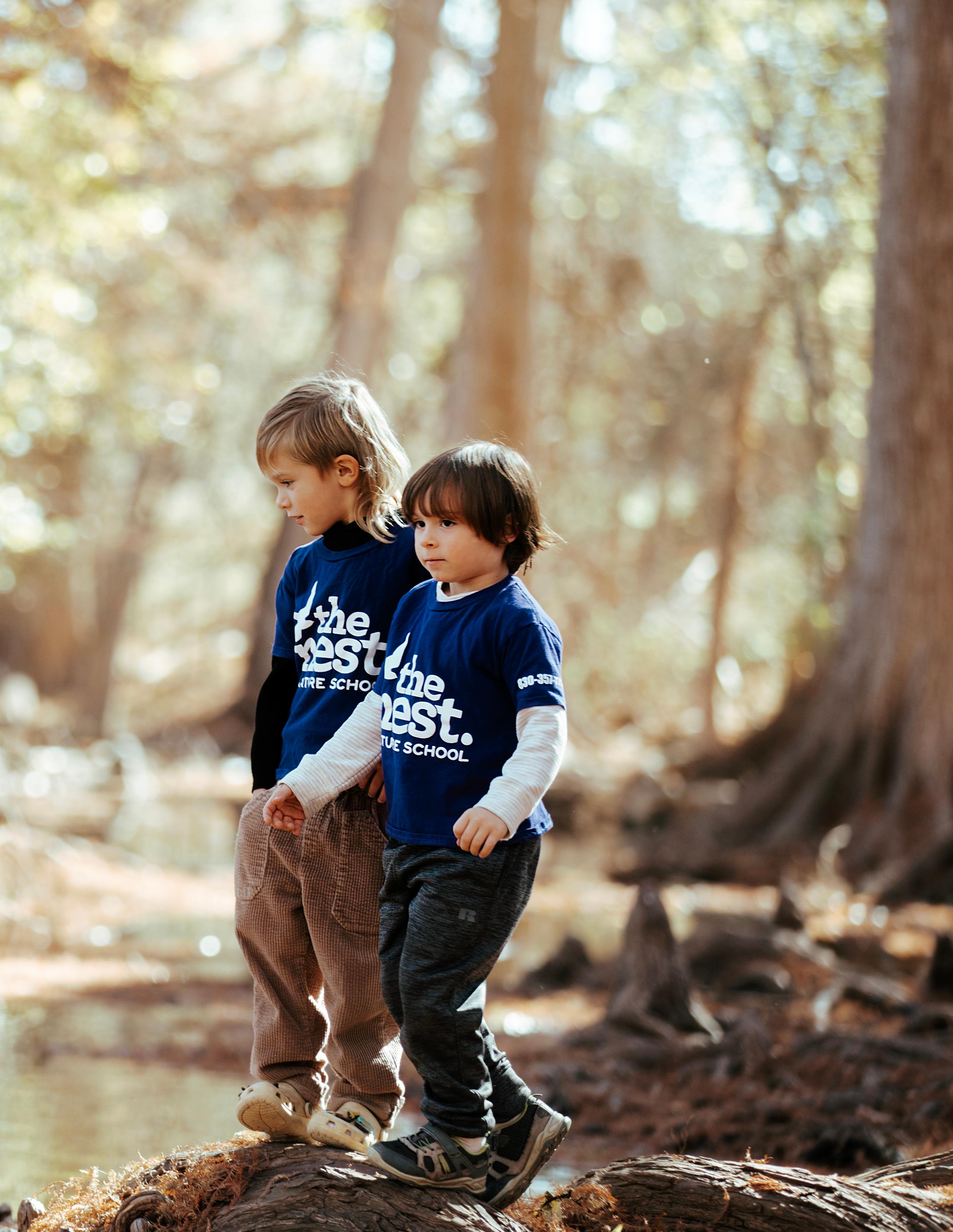
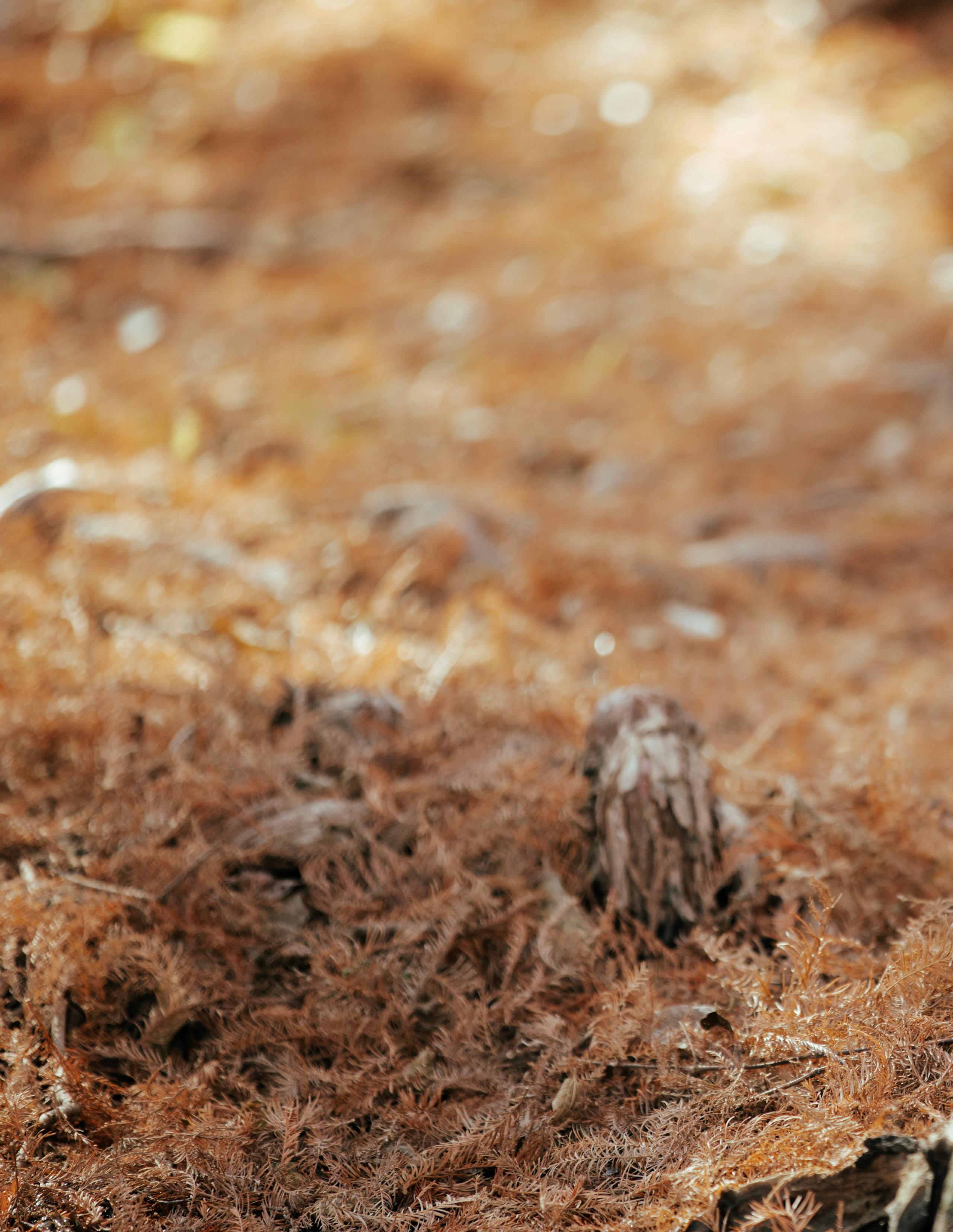
“There’s a little Nature Center… in a little Texas town… some people got together just to save a little ground. Go to Cibolo, Cibolo, Cibolo to volunteer some time. Gonna repair some damage, gonna find some peace of mind.” This line from the song “Going to Cibolo” by Brent Evans perfectly sums up The Cibolo’s purpose from its foundation and what it continues to be today—a community of people joined in their efforts to conserve the natural world, united by the healing, restorative power of nature. In the words that follow, I hope to pay homage to the amazing community that exists at The Cibolo and encourage some who may be learning about us for the first time to come on out and join us.
One example of a thriving community where we see friendships form is our summer camp crew. Whether through invitations to upcoming birthday parties, wanting to stop parents at checkout to inquire about play dates, or wondering if their friends from last week or even last year have returned to camp, the bond that our campers create with each other is special. At camp, we also use nature names to identify campers and counselors, such as “Bumble,” “Leaf,” or “Acorn.” To hear a camper inquire and ask about wanting to return to “Coyote’s” group because they were an important mentor makes me smile. By the end of the summer, campers begin to show ownership of the space by requesting specific camp activities and having a strong sense of their favorite aspects of camp, realizing that this space belongs to them, too.
After our first night hike of the season, which just so happened to fall on the last day of camp, a camper who joined us with his family asked, “Where’s Ms. Kathleen?” (our Assistant Camp Director). I laughed and informed him that she was probably at home with her family, but it was clear that he viewed her as someone important to him who he wanted to continue to see at The Cibolo. As for our counselors, the after-work boba tea runs, secret sandwich recipes, postcamp school friendships, attending Moondance
Noah Lawrence Nature Education Director
Outdoor Concerts, tears on the last day of camp, and a desire to remain with The Cibolo past camp all indicate that a special bond formed here. A job as a counselor is not just a job but rather the joining of individuals into an enduring community, both within the borders of The Cibolo and beyond for years to come.
Every semester, we also offer a weekly homeschool program to provide hands-on outdoor education and student-led learning to teach children ages 5-12 a little bit about nature at The Cibolo while supporting their curriculum. Seeing the homeschooled students celebrate each other’s birthdays, organize play dates outside of the class, and experience a sense of friendship and community is what the class is all about.
Finally, to ensure every child can experience being in nature, we offer field trips in the fall and spring. To have students from all over the region come back for a field trip each year is incredibly special. To reach out to our local community, we are waiving all fees for schools in Boerne this semester so they can visit The Cibolo on a field trip. We want every student in Boerne to know about The Cibolo and realize we are here for them. Whether it’s a place to have a picnic, go fishing, an inspiration for a school project, somewhere to get volunteer hours, or a space to quiet the mind, The Cibolo is here for the students of Boerne.
We have absolutely amazing volunteers who support The Cibolo. Even as I write this article, our volunteer Tigger is here for her weekly Wednesday visit. Every week, this incredibly dedicated volunteer comes in to do whatever she can to help with education. From organizing supplies, contributing her wealth of knowledge to our lessons, or gluing ribbons to pinecones, Tigger is an integral part of our team that always tries to “pay it forward.” If we jump across the creek to Herff Farm, our volunteer Sarah helps in the entire garden with particular attention paid to the care of the chickens. Our chicken mother
provides love, attention to detail, and work ethic towards the chickens so they thrive. We have volunteers who help lead Moondance, repair the trails, participate in all parts of our Wildlife Field Research week, help with programs, lead workshops, assist with special events, and more. In addition to the amazing work they do that allows us to function, our volunteers add to the community we have at The Cibolo. Their funny anecdotes, sharing of recipes, sharing of meals, problem-solving together, and just being a daily part of what we do is an integral part of our community. The Cibolo without volunteers would, in many ways, be missing part of its soul.
Even for those who don’t sign up for a program or volunteer, we still have a special community at The Cibolo. Having a system of trails and diverse ecosystems means that we are lucky enough to interact with people who visit our trails every day becoming a welcome part of the staff’s daily experience. Being able to discuss the weather, quality of the trails, animals spotted, and other
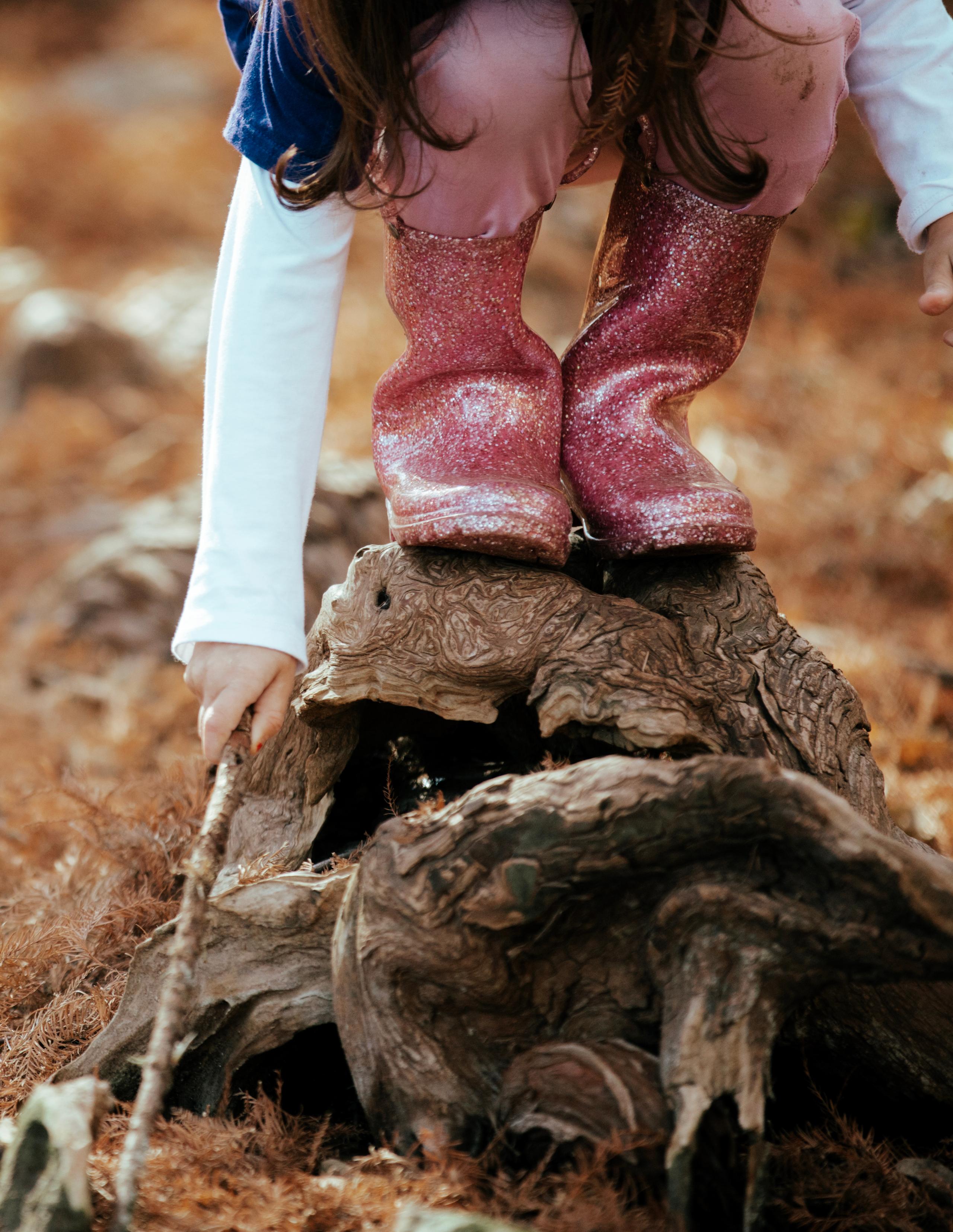
aspects of life with our trail regulars is another often-downplayed part of our Cibolo community.
Finally, I would be neglecting a critically important part of our community if I didn’t mention our partners and donors. It’s truly a gift that these wonderful folks view what we do as important enough to support us with their time and resources. By getting our information out to the community and helping fund outreach and programming, our partners and donors—though often operating behind the scenes—are vital to sustaining our Cibolo community.
Now, that just leaves it to you, dear reader. If you are not currently a part of our community, we invite you to come on out! If you are already involved but want to volunteer or participate more consistently, we would love to have you at The Cibolo. Whether it’s as a hiker on our trails, program participant, or volunteer, we can’t wait to meet you. To make a play off of one of my personal heroes, Mr. Rogers: it’s you we like!
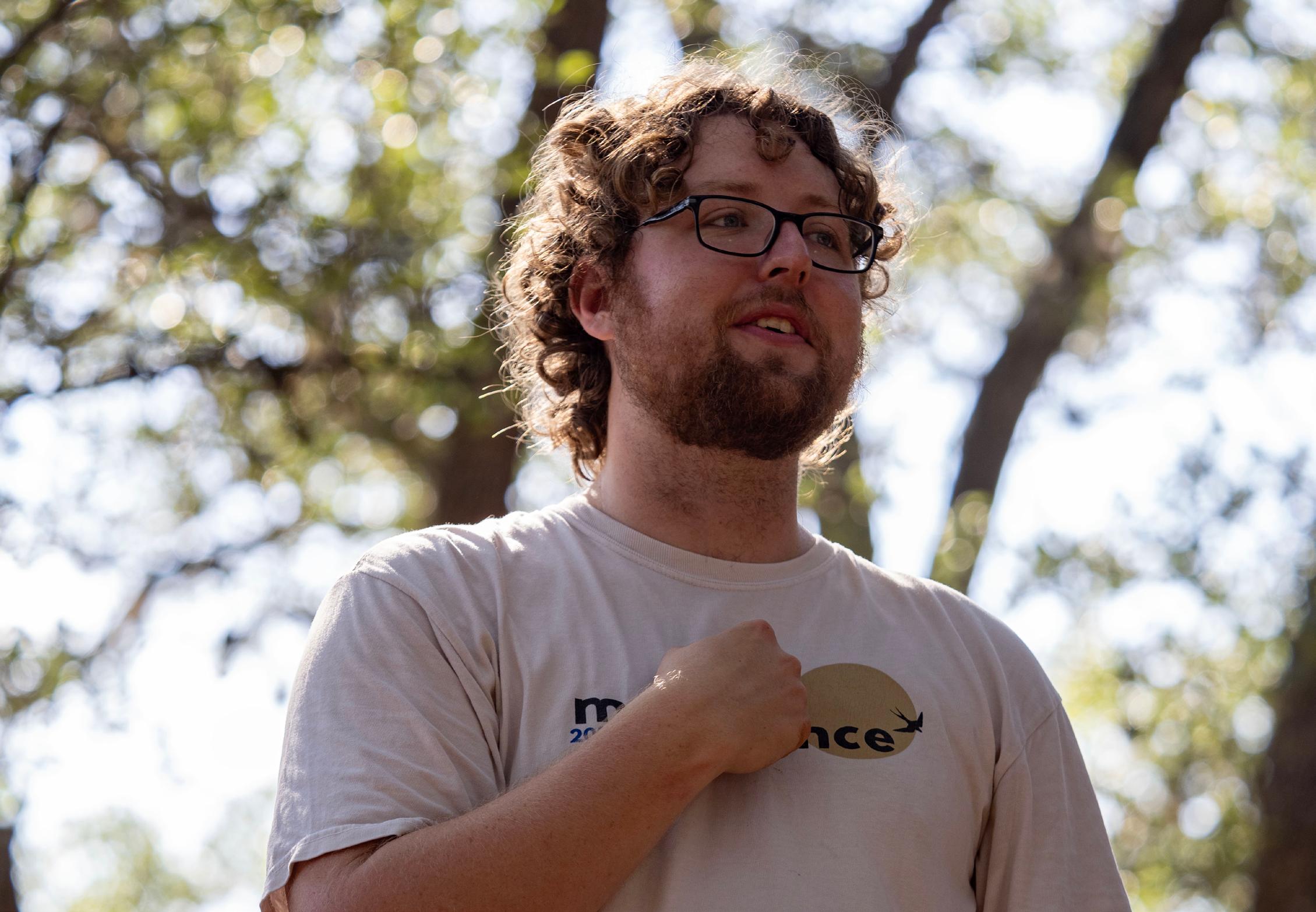
Volunteerism is nothing new at The Cibolo Center for Conservation. The foundation of The Cibolo was set in place by a core of good friends with a glimmer in their eyes and conservation in their hearts that gave life to what is now a well-known and nationally respected example of conservation.
Fast forward thirty-six years, our volunteers are still the heartbeat of this organization offering staggering amounts of hours and resources to maintain trails, grow gardens, teach children, and survey countless species of vegetation and wildlife.
In a world where people are busy raising families and working long hours, it’s a wonder how individuals can integrate time into an over-packed schedule to give to a non-profit organization. Since joining the team at The Cibolo as a Volunteer Coordinator, I have been intrigued by the wide range of knowledge, skills, and passion our volunteers exhibit whether helping at the farmers market, putting together our nature boxes
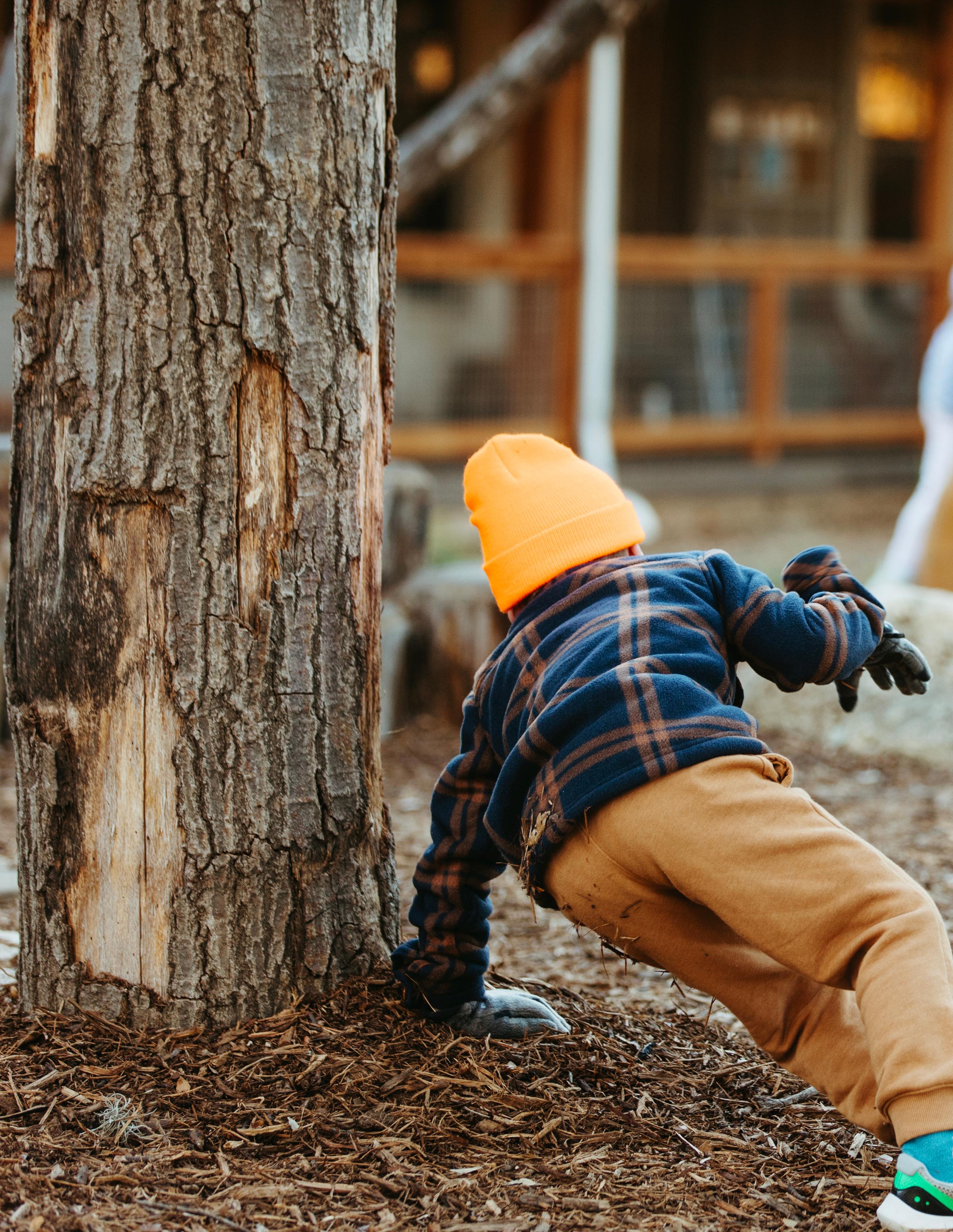
Jennifer Smith Volunteer Coordinator
to take to area schools, or surveying small insects. The energy is palpable and inspiring. It begs the question…what motivates and drives individuals to selflessly give up their time?
A few of our seasoned volunteers help answer this question. Veronica Hawk, a Texas Master Naturalist and NPSOT member shares, “I have really enjoyed volunteering at The Cibolo Center for Conservation because there is so much to do there! I have had the opportunity to do plant surveys during Wildlife Field Research week and learn so many of the grasses and forbs that I have found in my own yard! I am able to attend Native Plant Society chapter meetings and hear well-known experts on native plants and related subjects. By volunteering in the demonstration garden, I help maintain the plants that we use to teach the Native Landscape Certification program. I become familiar with their growth habits, contribution to the ecosystem, and interesting characteristics through the seasons.”
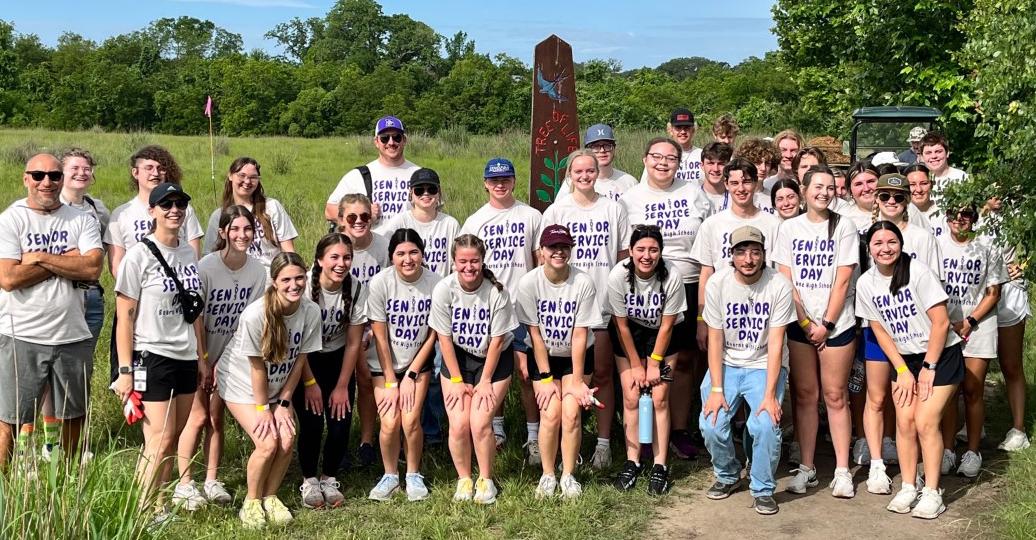
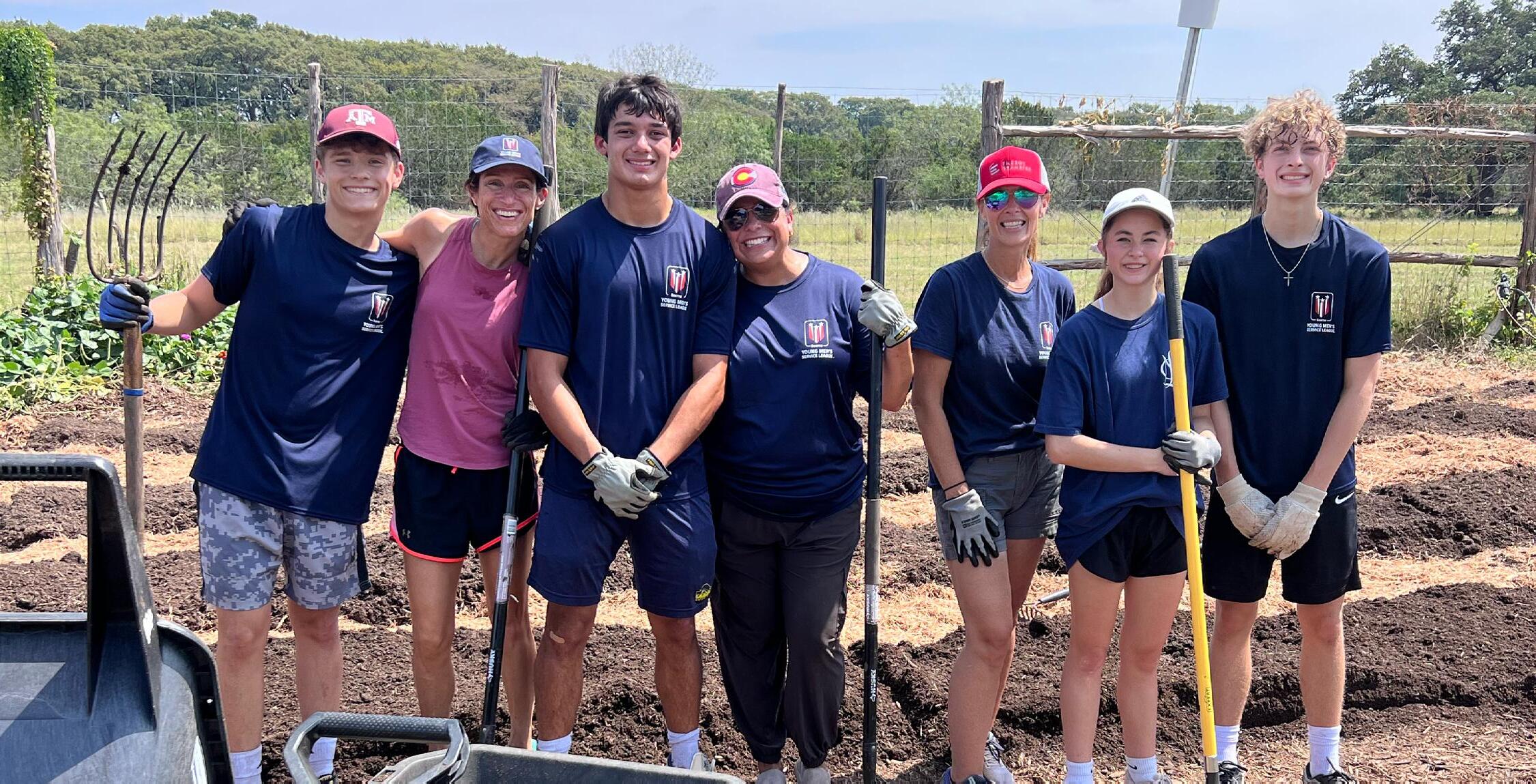
Keith Blaies explains, “I volunteer at The Cibolo because of how much the kids benefit from the Teaching Garden. They learn gardening skills, how to grow vegetables, and how to respect nature. And simply…it’s just a wonderful organization.”
These insights echo the sentiment most of our dedicated volunteers share and are a testament to the dedication, passion, and significant impact they have on The Cibolo, the Boerne community, and beyond. Our volunteers bring
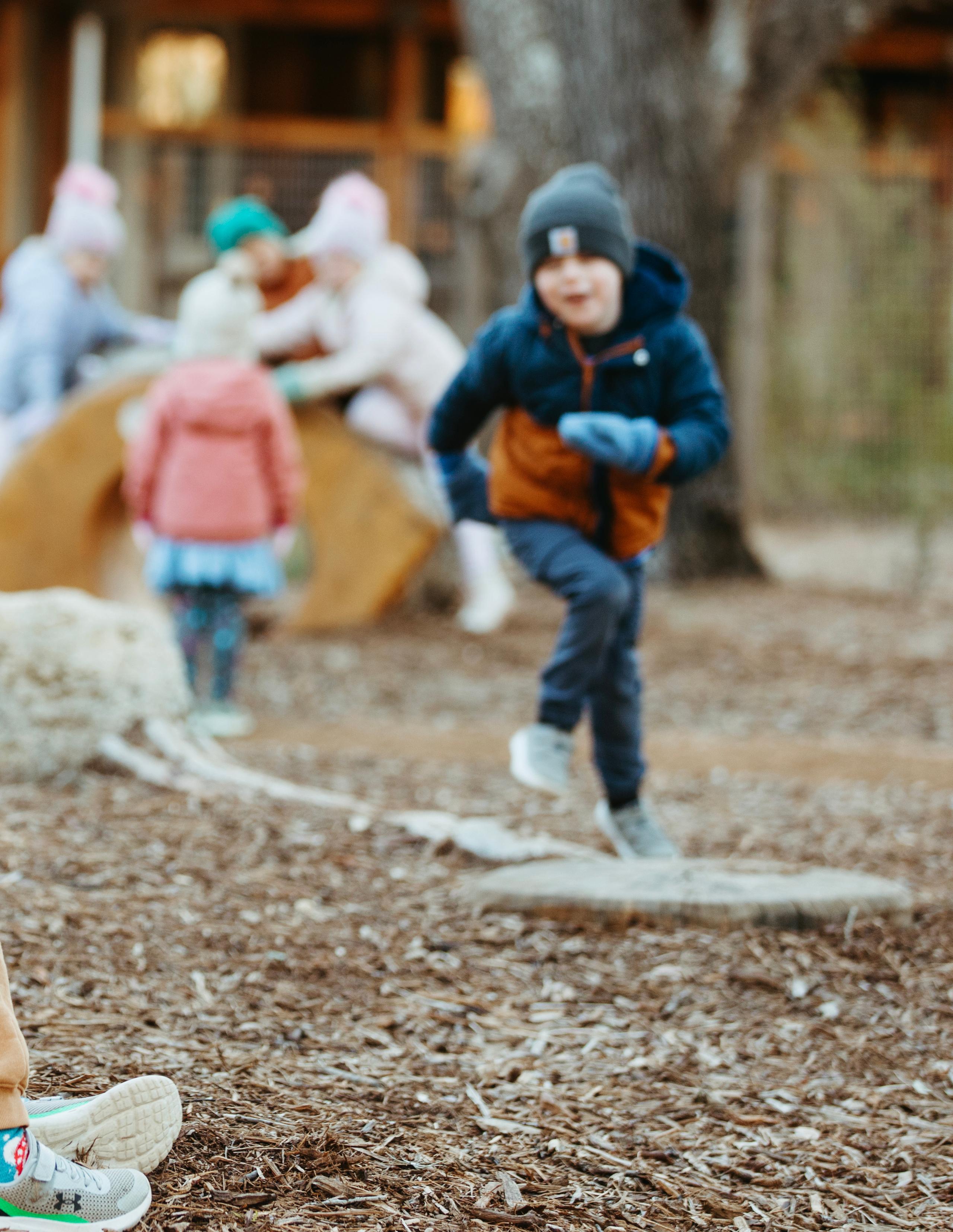
diverse experiences and unique contributions that are integral to the heartbeat of our mission of conservation, education, and community engagement. We are deeply grateful for their support and commitment, which continue to drive our success and inspire others to join us in our efforts.
Learn more about our volunteer opportunities and discover how you can get involved at cibolo.org/volunteer
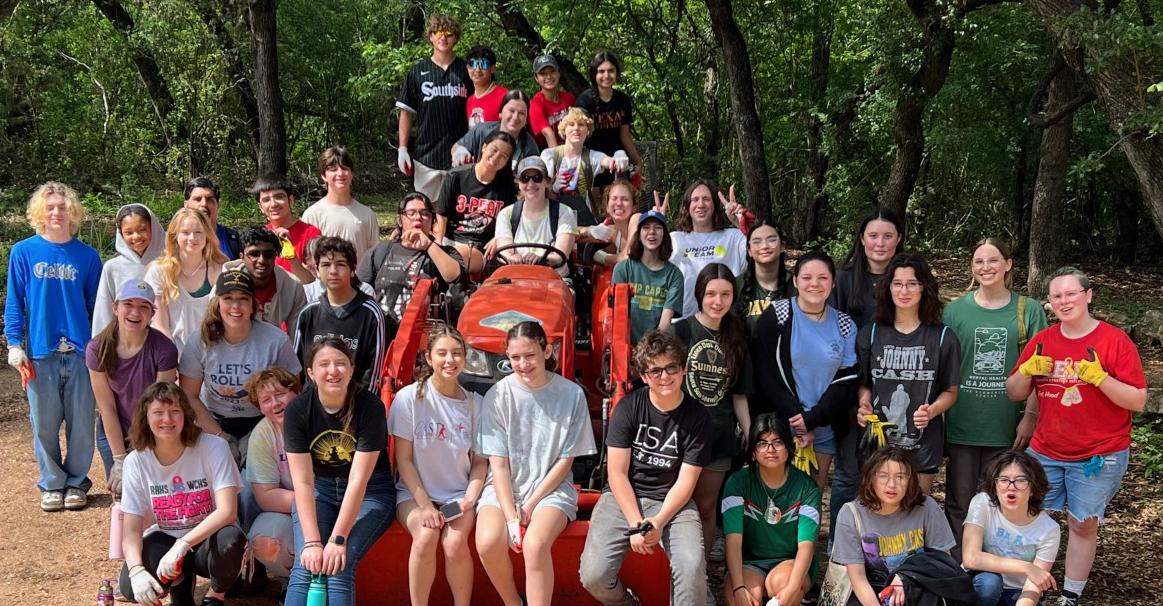
For Tigger, volunteering has always been a way of life. As she reflects on her journey, she recalls the countless ways she has been fortunate, particularly through her family and the opportunities she’s had. Now, in a position to give back, Tigger sees volunteering as a way to pay it forward. Her story begins in Claremont, California, where as a child she participated in community programs made possible by volunteers. “I remember the volunteers gathering all the children from my town, and we’d get on a bus to go listen to children’s concerts that the LA Symphony put on,” she shares. Those early experiences left a mark on Tigger, inspiring her to become what she calls a “professional volunteer” in adulthood.
Tigger’s volunteer past is vast, from serving as a school librarian to leading Cub Scouts and Girl Scouts. When her husband’s military career took them to new places, Tigger continued her passion for helping others wherever they went. “Volunteering was something I could always do, no matter where we moved,” she explains. Despite careers in analytical forensic chemistry and tax preparation, she found true fulfillment in giving her time. “It only seems right and fair to give back.”
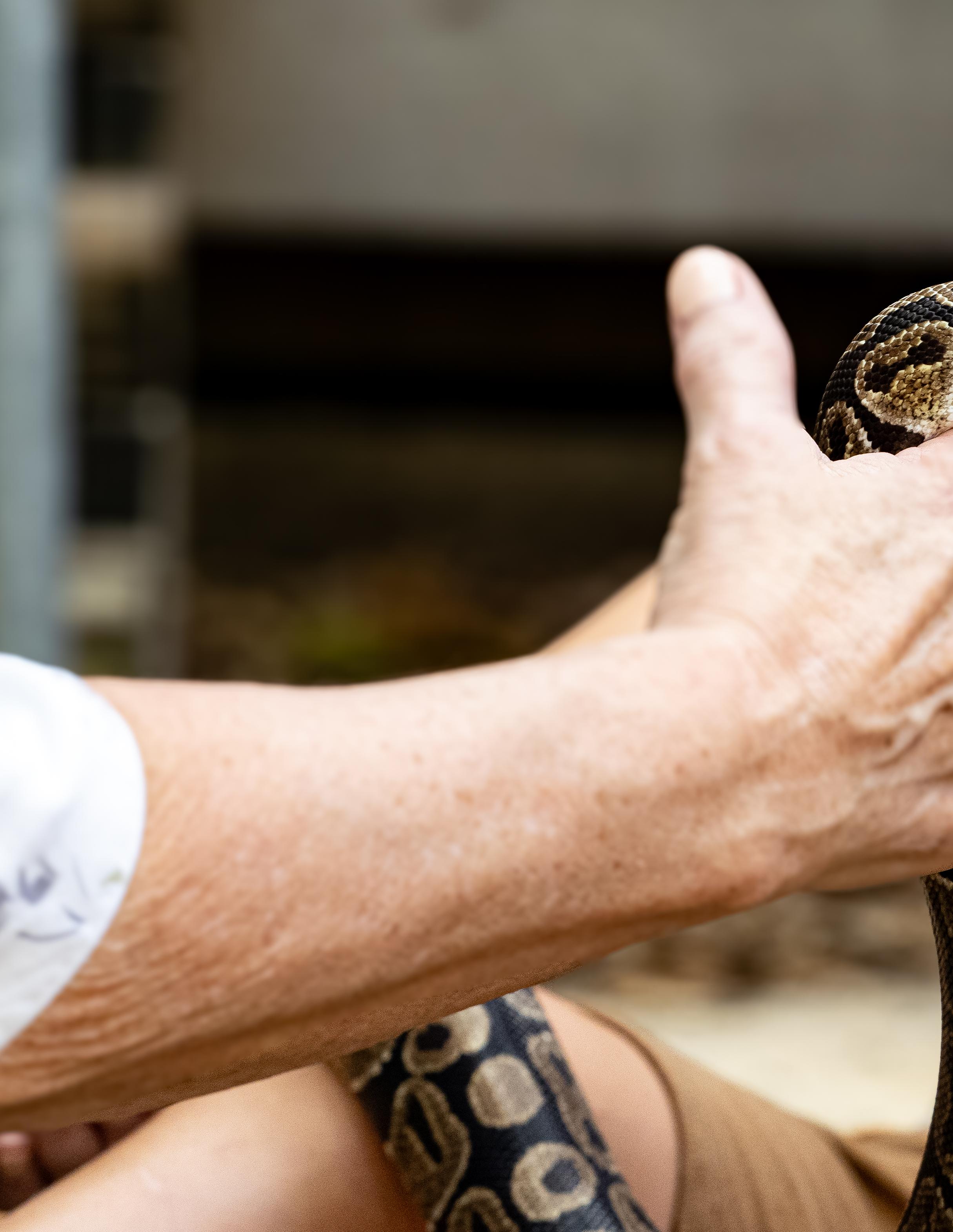
Brian Davenport Communications Director
Tigger’s journey with The Cibolo began somewhat unexpectedly. She was a docent at the San Antonio Zoo, where Laurie Brown was in charge of all the volunteers and docents at the time. When Laurie transitioned to The Cibolo, Tigger followed. “I still volunteer at the zoo on Fridays, but I also started coming here on Wednesdays to help with all of the million and one drudgery things that need to be done, whether it be papers filed or shredded or this or that organized.” Though she initially volunteered alongside Laurie, she promised to come back and help Noah. “There was a rather long delay in keeping that promise,” Tigger admits, “but I made it, and I’m keeping it.”
Her loyalty to The Cibolo is unwavering. Though there was a break between her initial involvement and the present, she now volunteers regularly on Wednesdays. For Tigger, there’s always something new to do: “One Wednesday, I was washing out tie-dye ink bottles, another time I was organizing pencils and crayons.” This variety keeps her coming back. “It’s always an adventure. There’s always something new to learn.”
When asked about The Cibolo’s impact on the community, Tigger speaks of its unique ability to


preserve nature amidst the noise of modern life. “Just having a place where you’re more likely to hear a buzzing of grasshoppers and birds singing than the roar of engines is so important,” she says. The Cibolo offers an escape from the sight of asphalt, a place where children and families can connect with nature, something increasingly hard to find. Tigger values that this quiet, natural space exists in Boerne, providing a sanctuary for people to recharge.
Tigger’s volunteer work isn’t just about giving back—it’s also deeply personal. She shares that her daughter-in-law doesn’t always understand her decision to volunteer instead of pursuing paid work, but Tigger finds fulfillment in serving her community. “Our needs aren’t that great, so I don’t have to work,” she says. “The idea of being able to volunteer and share the blessings I’ve had is something that’s very satisfying for me.”
One of Tigger’s most memorable moments volunteering at The Cibolo involved a donor event where newly hatched chicks were being socialized. “A lot of people had never held a baby chicken before,” she recalls with a smile, “and being able to share that experience with them was so special.” For someone who has always felt a connection to wildlife, this event was particularly meaningful. Tigger recounts the story of her son, who as a child had always wanted a dog. After attending a medical conference with a presentation on snakes, he had a change of heart. “On the way home, we hear this little voice, ‘Mom, Dad, can I have a snake instead of a dog?’ And we said, ‘Yes!’” Tigger laughs. “It’s been reptiles ever since.”
That love for wildlife has carried into her volunteer work, where she’s often called on to help with animals at The Cibolo. Whether sharing her knowledge of reptiles with children or assisting with the animals at the farm, Tigger brings her passion for nature to everything she does. Her sense of curiosity and respect for the natural world is evident in her enthusiasm for sharing it with others.
Volunteers like Tigger play a vital role in supporting The Cibolo’s mission. They help create the unique
experiences that make the center a beloved part of the Boerne community. Tigger believes that The Cibolo is an increasingly rare place in today’s world, offering a safe, educational, and fun environment for people to explore nature. She encourages anyone considering volunteering to take the leap: “There’s always a need for additional help, and you’ll have a marvelous experience while volunteering,” she says. “The grounds are beautiful, and the people are delightful.”
Volunteering at The Cibolo has also given Tigger the chance to build lasting friendships. “I look forward to seeing Noah, Kathleen, and Flo each week,” she says. “When you come in, you’re greeted by friends, and that’s wonderful.”
Looking back, Tigger expresses a bit of regret that she didn’t get involved with The Cibolo sooner. “I was introduced to The Cibolo maybe 20 years ago at a holiday event in Boerne, but I didn’t give it much thought at the time,” she says. Now, she realizes just how special the center is. Her advice to anyone visiting? “Bring good sturdy shoes and an open mind to listen to what Mother Nature has to say.”
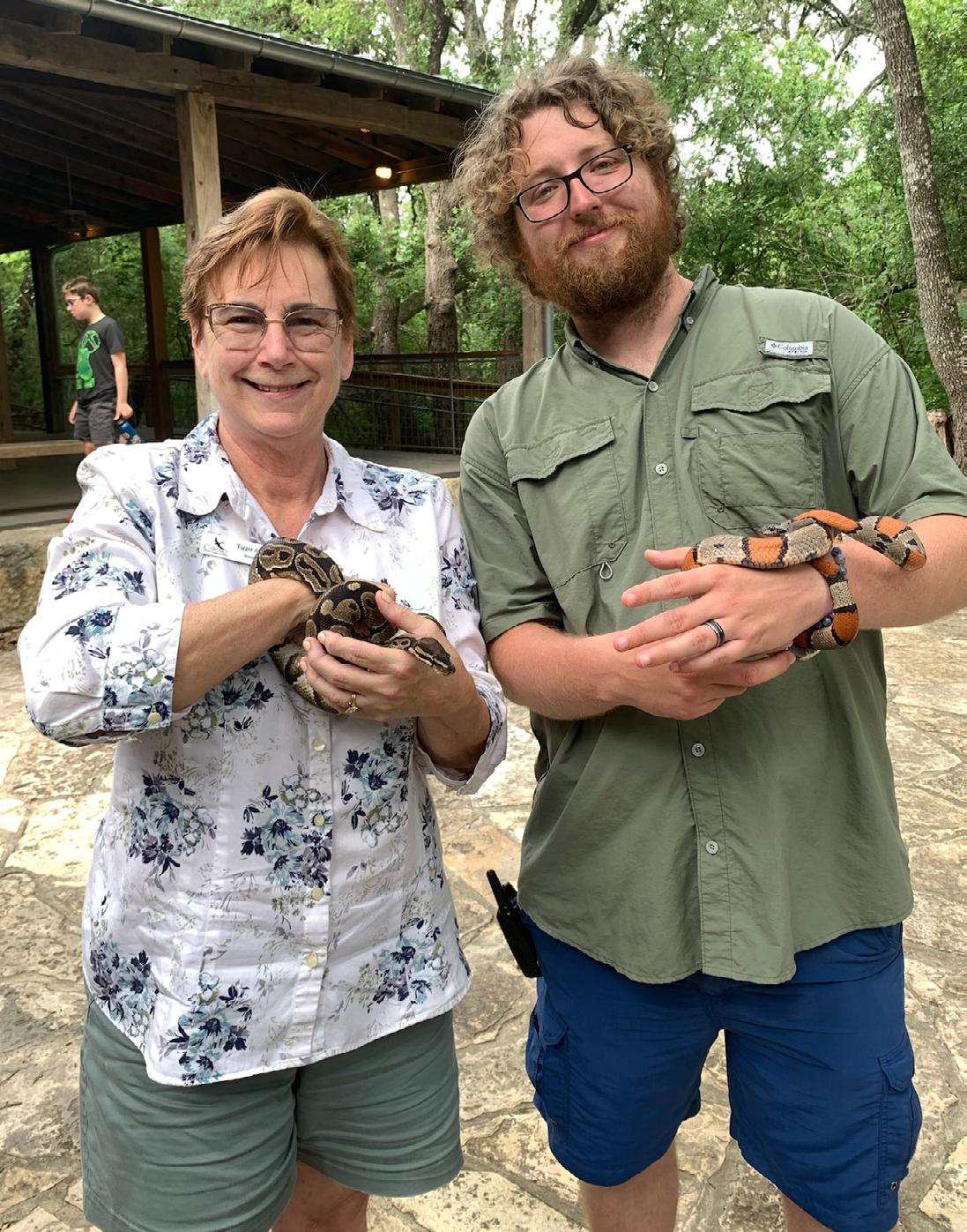
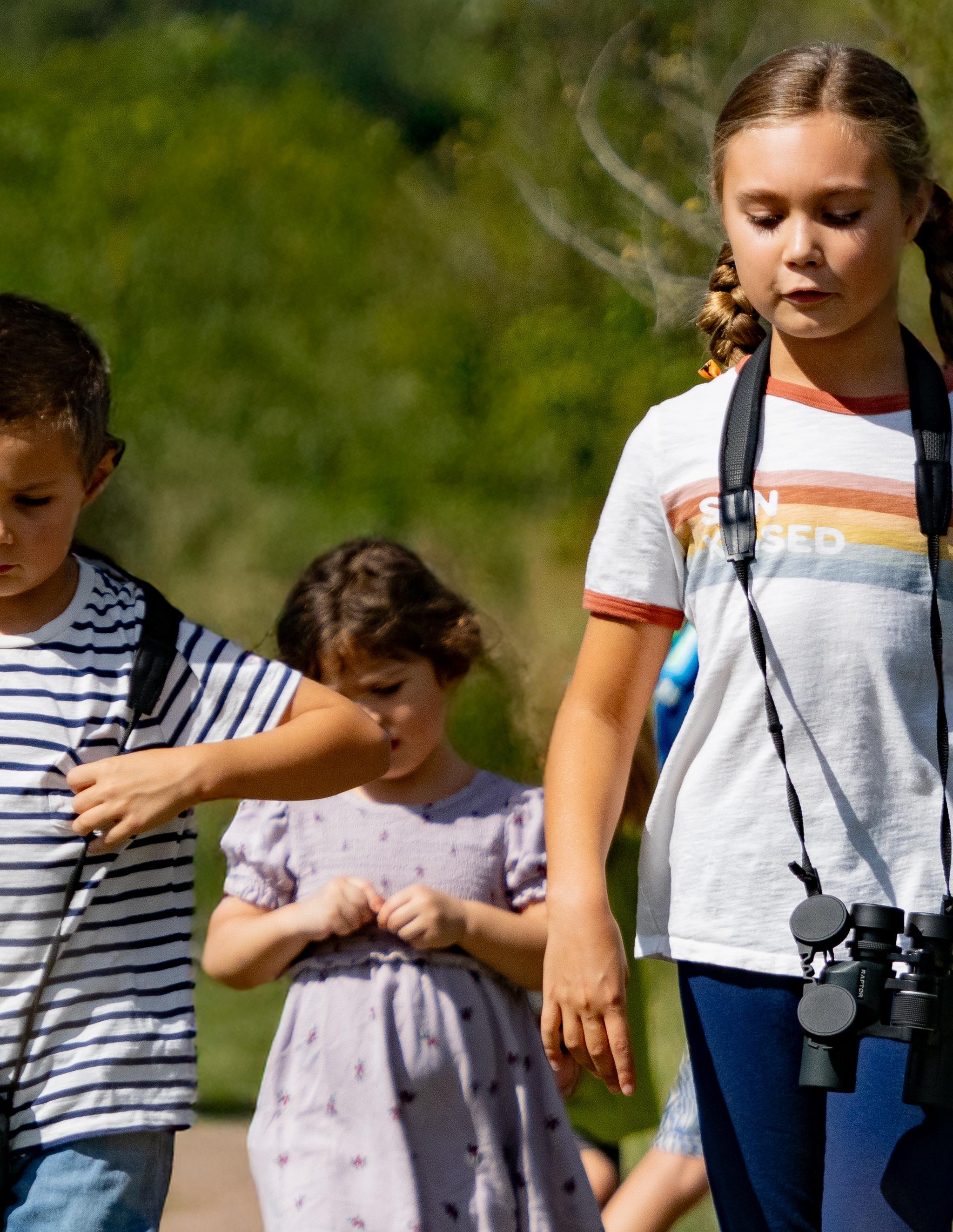
My first experiences at The Cibolo Center for Conservation kicked off last September, and I haven’t stopped learning or smiling since. As the Nature Education Coordinator, I’ve had adventures like hunting for insects under rocks in the garden and “archeological digs” in the sand pit with the preschool kids at The Nest, to trail hikes during field trips and summer camp. All of these add up to a year full of fun stories and sweet new memories.
The opportunity to spend time with four and five-year-olds from The Nest after school was a golden one. They really looked forward to visiting and feeding the chickens in the Teaching Garden. Collecting the eggs was THE highlight of our time there, as they carefully cradled them close for the trip to the refrigerator. Of course,
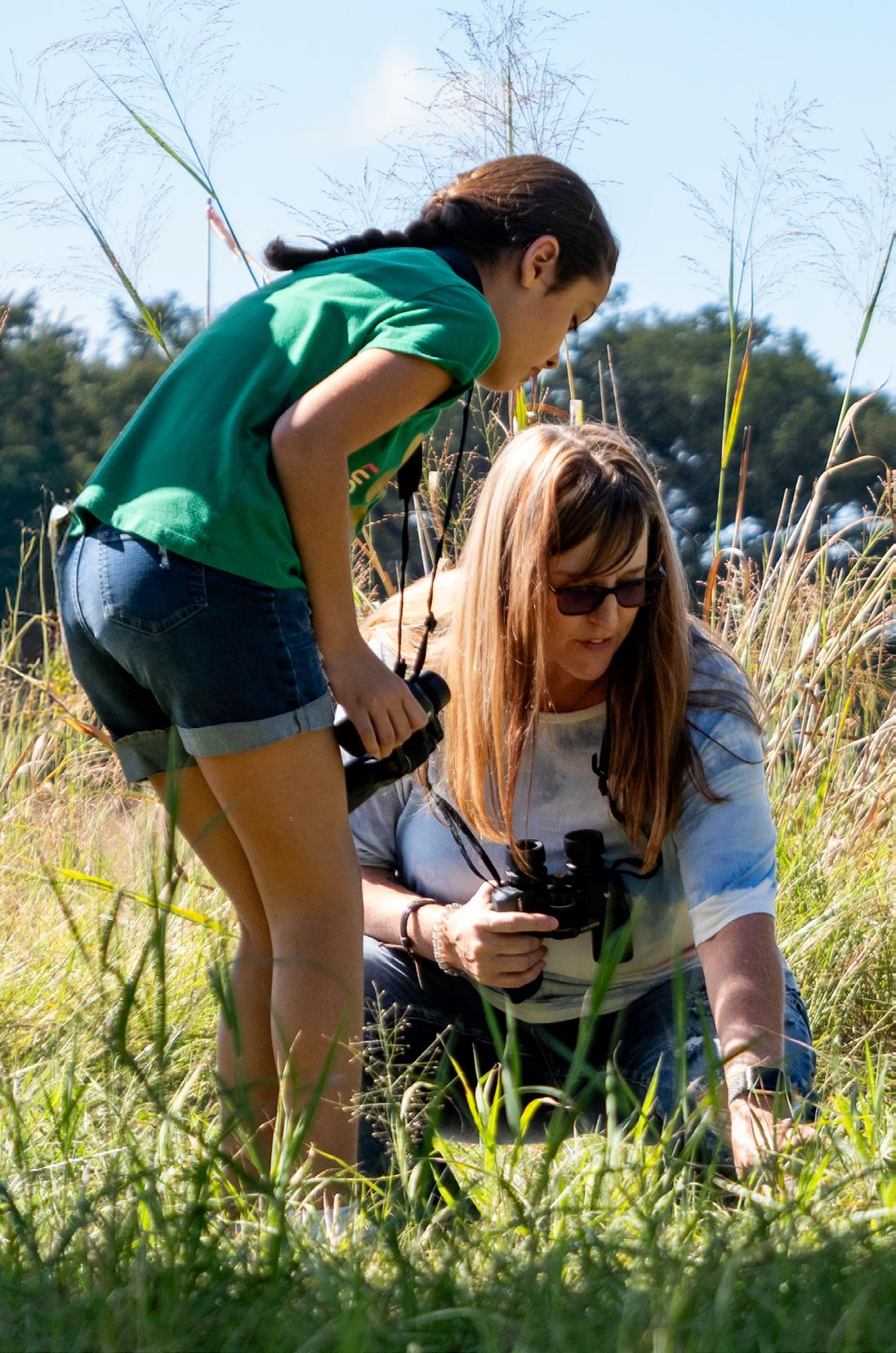
Kathleen Hoover Nature Education Coordinator
the chickens were equally enthusiastic about the bread and mealworms and were happy to make the exchange. I remember sitting in the cool metal chair, watching the children interact with the chickens, and thinking how sweet the unforgettable moment was.
And, let me tell you about the enthusiastic reactions of inner-city children on field trips (and parents) when they catch their first butterfly with a net. There are shouts and laughter followed by the sound of running feet as others rush to see. And, of course, the bittersweet thrill of giving them back their freedom when they are released in the end. It was as if the clock stopped turning so that time could revere the purity of what nature had to offer.
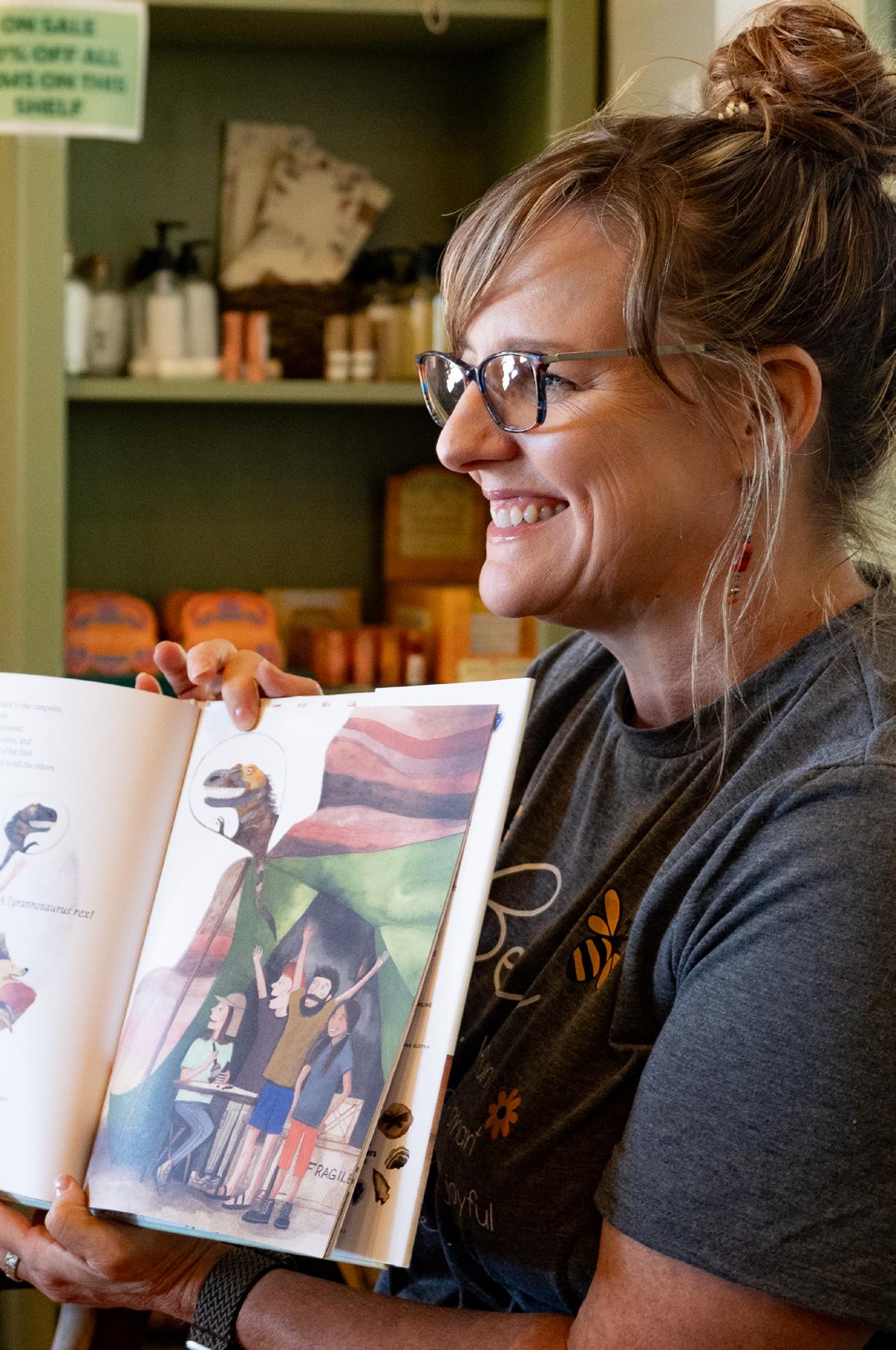
When I think back to some of the field trips I went on as a child, there was always something that stood out for me. So, it is very heartwarming to hear a second grader say that this was the “best day ever” or a fourth-grade student announce that this was their “most favorite field trip!” The questions asked and the discussions that came from them were often so entertaining, as well as endearing. They range from “Are there spiders out here?” to “Do monkeys live in these trees?”
Summer camp was dynamic. The days were full of silly songs, fun insect discoveries, a plethora of exciting activities, and making new friends. One of my personal favorites was getting to witness so much raw talent and creativity from the kids in art camp. This was held in the afternoons after nature camp and was an environment of prolific imagination. Some of the campers would ask about the project of the day as soon as they stepped out of their cars! And their favorite activity? Well, that would be the chance to create
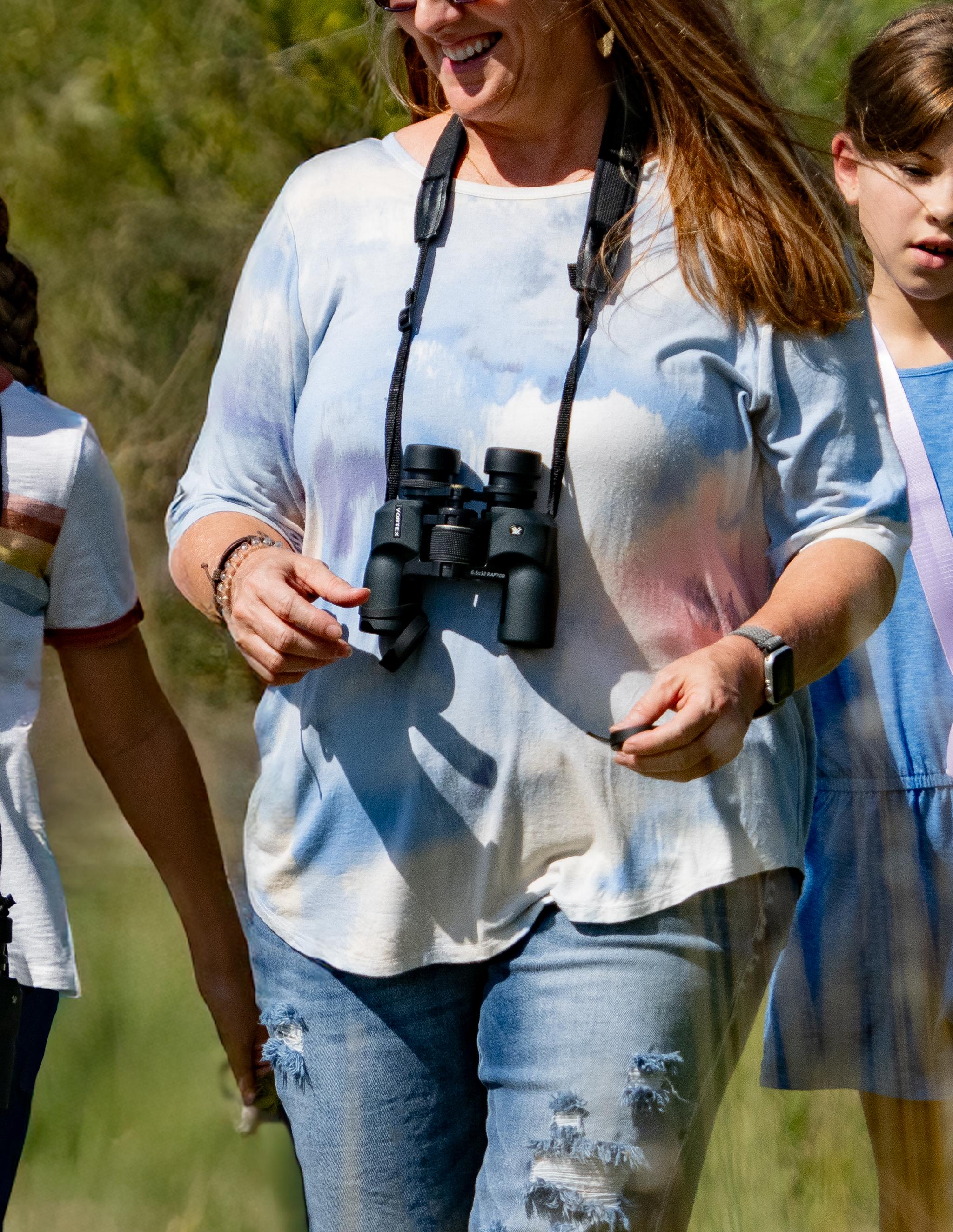
whatever they wanted in “free choice” at the end of class. The amount of pride and self-confidence that resulted more than outweighed the hot glue and recycled items used!
Before being employed here, I’d walk the trails and wonder what went on in the buildings at the trailheads. Not once could I have imagined the heart and soul that resides here. The many programs that are organized by passionate and caring individuals. Not once did I consider all the time and effort that went into activities such as bird surveys, night hikes, volunteer work, garden education, and water and land conservation, just to name a few. It is truly an honor to be a part of a movement to restore what’s been misused and to offer such a necessary education on the conservation of our natural resources. I am genuinely thrilled to have found the treasure that is The Cibolo Center for Conservation.

So, what is Creekside at The Cibolo? That’s a simple question to answer. Creekside at The Cibolo is a radio show on Boerne Radio 103.9FM, airing on Saturdays at 9am, that will live on as a podcast. But, I guess the better question is—why are we doing this?
For context, let’s head back to 1988 and explore how we got here in the first place. A young Boerne family, not unlike mine and maybe yours, was faced with a decision. You see Laurel was about to turn seven. Although quite understated and often overlooked, a seventh birthday is a big deal to a six-year-old. You have to remember that a sixyear-old has probably only had four birthdays, at most, that they remember. When you’re little and the whole world is a big, new, sometimes scary and often exciting place, everything is a big deal. Especially an upcoming birthday. My son Forest is turning seven in October and my wife and I are actually in this exact situation today. The situation that Carolyn and Brent Evans were in 36 years ago. They had to decide what to do to celebrate a six-year-old’s upcoming, and much anticipated, seventh birthday. What they landed on was a visit to the Cibolo Creek. A place that Carolyn had a majestic, even magical, memory of from her own childhood. You see, her family had a ranch in
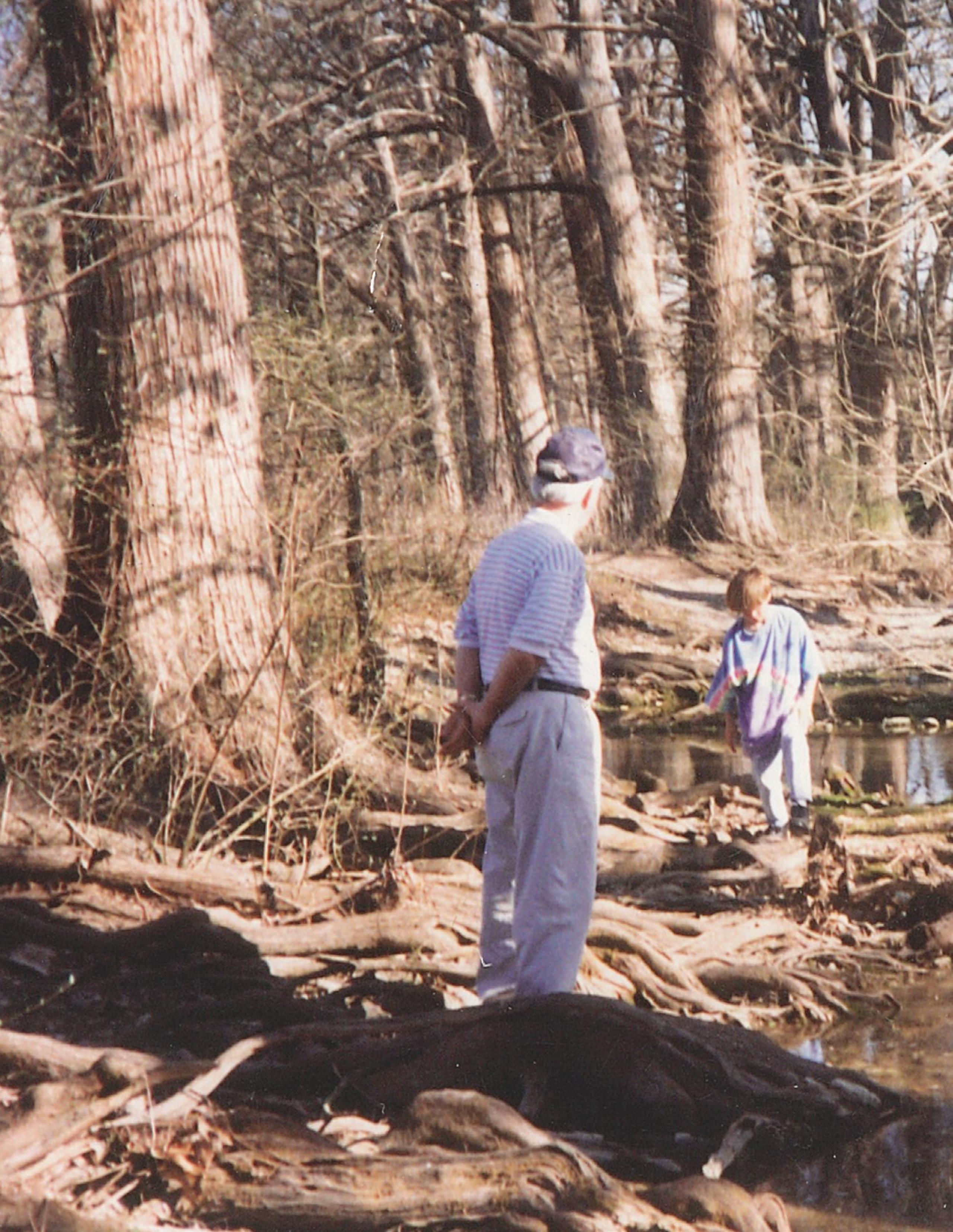
Brian Davenport Communications Director
Boerne, and as a girl, she would come to the Hill Country to experience what was understood to be, even into the mid-20th century, a place of healing. With a dry temperate climate, clean air, and spring-fed creeks of crystal clear water Boerne was advertised as a place of healing and solitude. And that’s what Carolyn envisioned for Laurel’s seventh birthday celebration, what she knew from her childhood—a beautiful, calm, flowing creek running through the heart of Boerne where they would gather with friends and celebrate the simplicity of turning seven.
But, what she found when they got there was something surprising. The strong bald cypress trees were there and the creek was flowing, but the serenity had been disregarded. The respect it was once awarded was no longer apparent. Instead, as with so many things in our lives, the simple beauty of something natural had been overlooked and taken for granted. The community, in its hustle and bustle of growth, had forgotten that this place is sacred. It’s old and wise. Like a teacher with history it won’t forget and will only share in a whisper. If you want to receive her education you must listen, intentionally, and with respect.
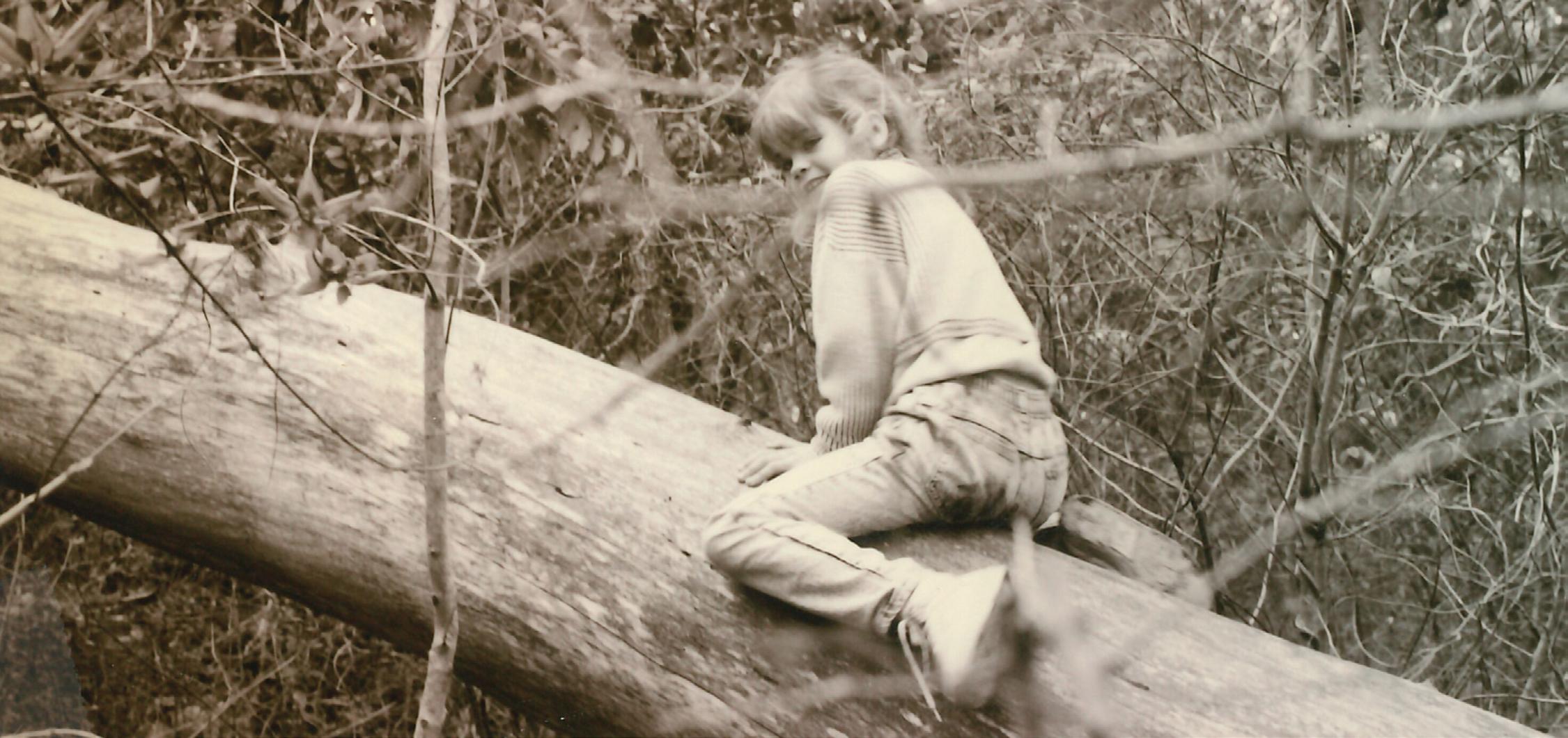
To her dismay that day in 1988, Carolyn witnessed at Cibolo Creek the evidence of a loud and reckless population that was missing the lessons of nature. The healing this ancient teacher held and was willing to share with us, but only with those who would listen for its whisper.
“We should do something,” she shared with her husband. If only someone would stand up and defend this place, if someone would speak for the creek, then the wisdom and healing that only nature can provide will be spared and passed on to six-year-old girls and seven-year-old boys with a whole life ahead of them. And those experiencing the stress and unease of adulthood could unwind and an old man could walk among tall prairie grasses and reflect on the seasons of his own life. And our community, our little corner of the world, Boerne, TX could continue to be a special, albeit, different and changed, place of solitude and healing.
On Saturday, March 12, 1887, the first train pulled into Boerne at 7pm with 600 people. Their train tickets cost .95 cents each and it took them three hours to travel from San Antonio. That was a huge change from the day before when you had to travel a full day from San Antonio if you wanted to visit Boerne, TX. Change has defined
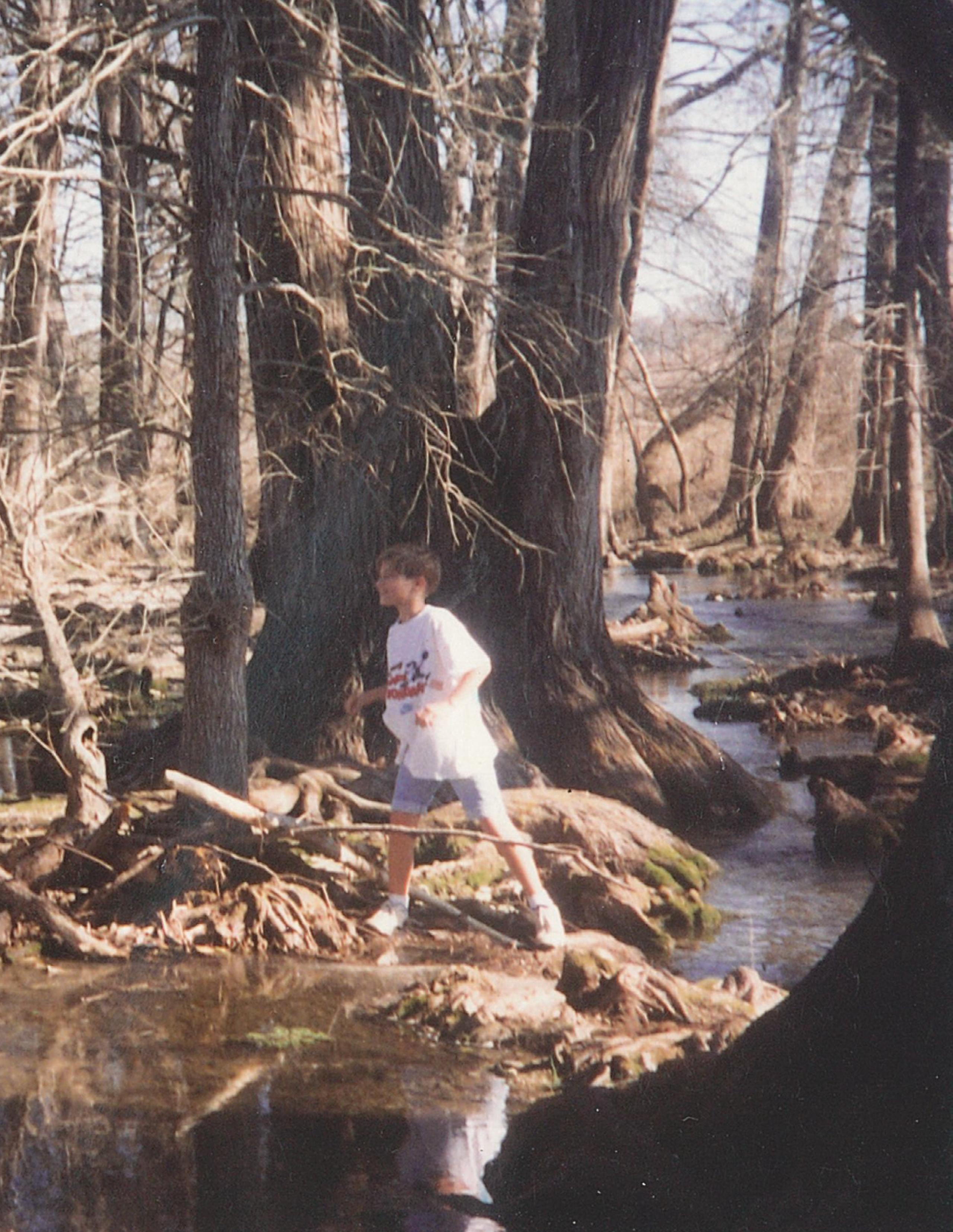
our community since its inception. With so much change and unrest in our own lives, in the world, and even in our hometown, it’s easy to become overwhelmed and lose sight of what you can do. You can do something. You don’t have to try to change the whole world. You can do something here and now. And it will make a difference. You can be the change you want to see in the worldeven if it’s just because you’d like your child’s next birthday to be better than this one.
That’s a long-winded answer to a question I’ve thought a lot about but hadn’t really sat down yet to answer—why Creekside at The Cibolo?
Because we want to explore how we got here and be intentional about where we are headed. To do this, we’ll talk with interesting people about relevant topics to share with you. Because we believe that we all have the ability, power, responsibility, whatever you want to call it, to make the world a better place. You can exchange cynicism with curiosity. The best way to do that is to take the time to be outside where it’s peaceful and quiet. Come down to The Cibolo and stick your toes in the creek, enjoy the shade of the Cypress trees, and listen to the teachings that are stored in the natural healing presence of nature. That’s why we’re doing this—for the love of nature.
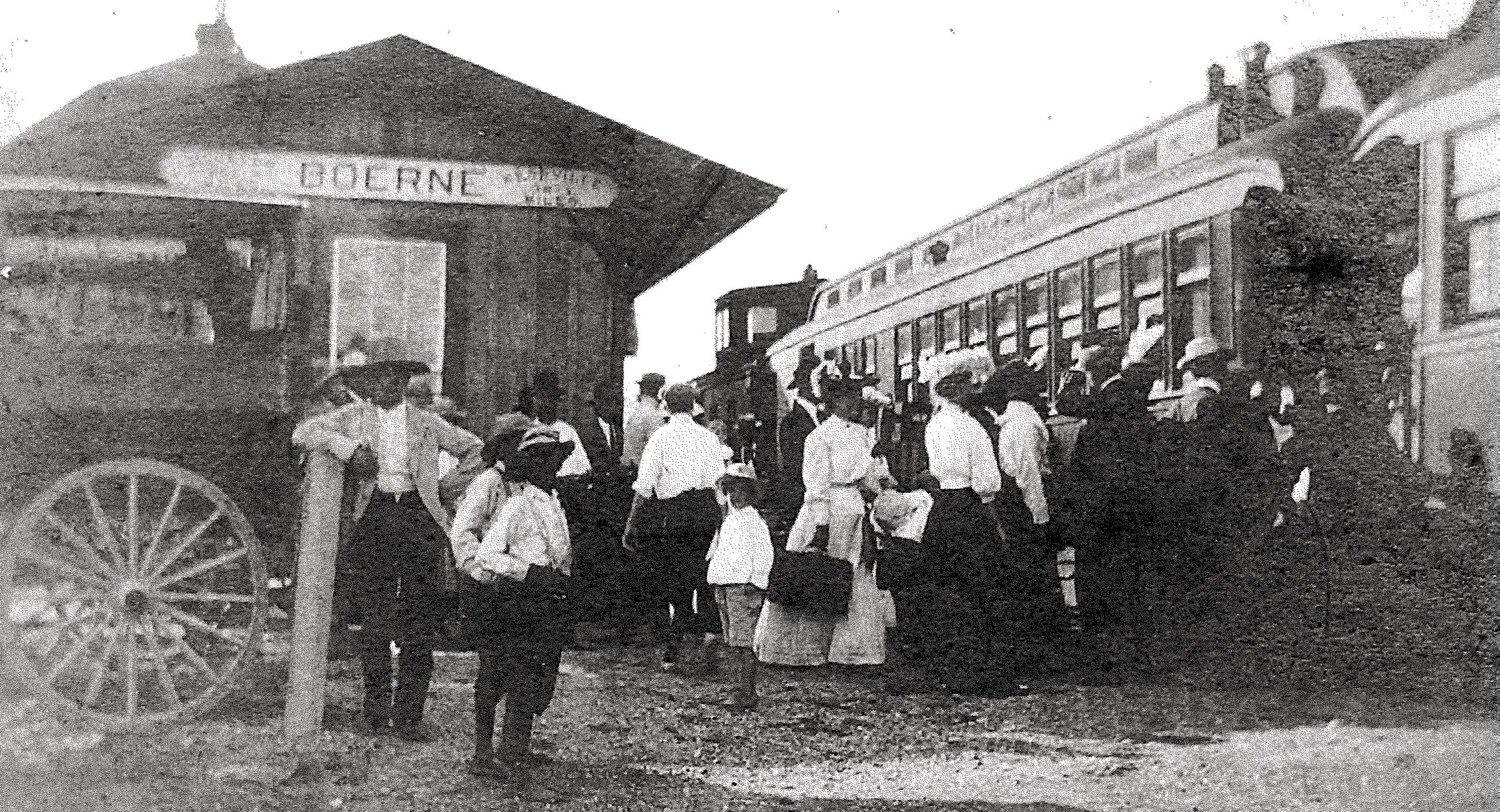
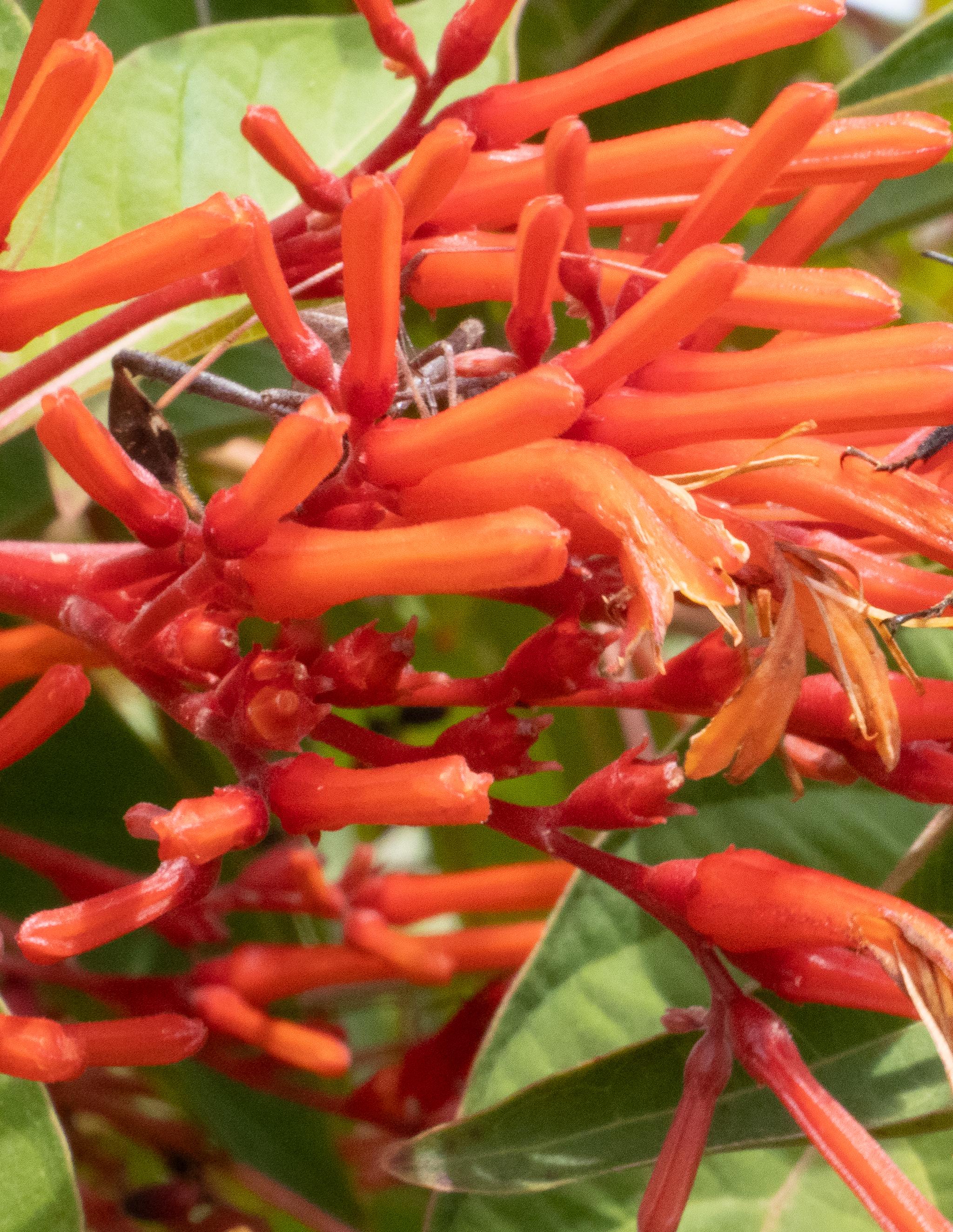
The Herff Farm at The Cibolo Center for Conservation was acquired in 2007, but construction on the Teaching Garden didn’t begin until 2019. This year, we are proud to introduce a newly designed plan for the garden, rooted in three guiding pillars: Community, Education, and Conservation. For the first time, this intentional vision ties the farm directly to the mission of The Cibolo—promoting the conservation of natural resources through education and stewardship.
The Teaching Garden now serves as a space where visitors can not only witness the beauty of organic and permaculture gardening but can also engage in hands-on experiences that align with these pillars.
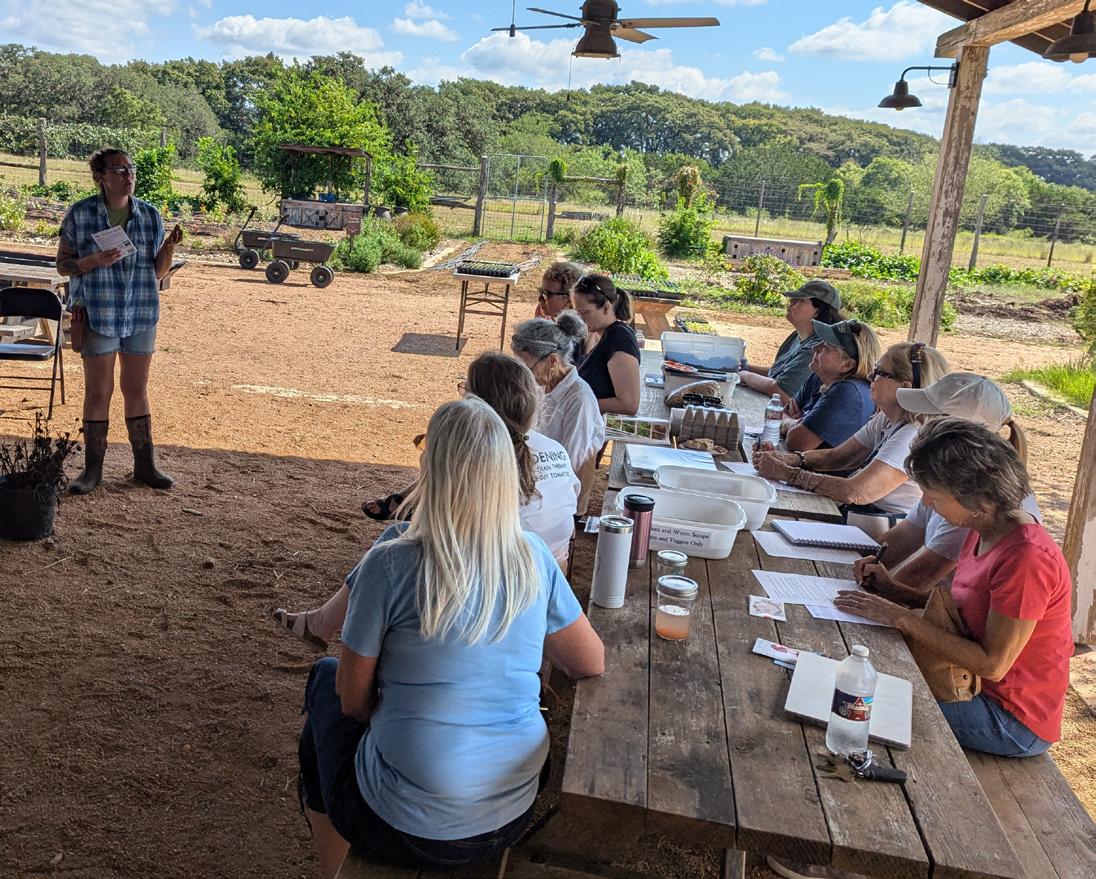
At the heart of the garden lies a commitment to fostering meaningful partnerships that enrich the community. From the Master Gardeners of the Inspiration Garden leading our new eightpart organic gardening series in early 2025 to collaborations with the Central Texas Mycology Association, visitors can learn valuable guidance to implement at home. Additionally, the Texas Hill Country Beekeepers Association shares the importance of pollination through bees, while Boerne ISD students shadow our Garden Educators, gaining firsthand knowledge of permaculture gardening.
Sarah Berringer Farm Education Director
Our Farm to Taste events, led by Lulu Belz, showcase how to use local produce at home. Guests can learn how to cook using goods from the Farmers Market at Herff Farm, bringing the farm-to-table movement to life. These collaborations create a bridge between local experts and the public, ensuring that everyone feels connected to the land and the people who care for it.
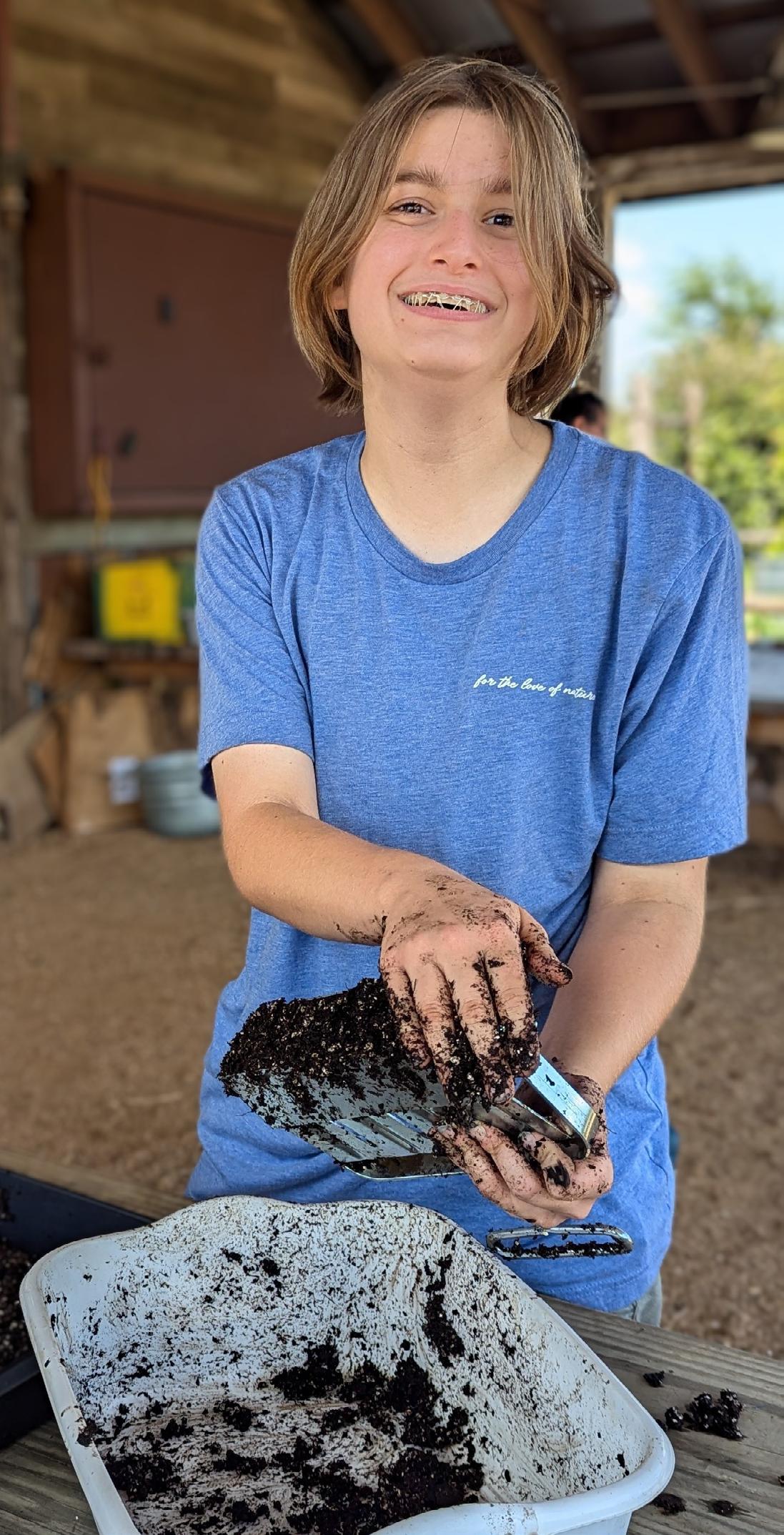
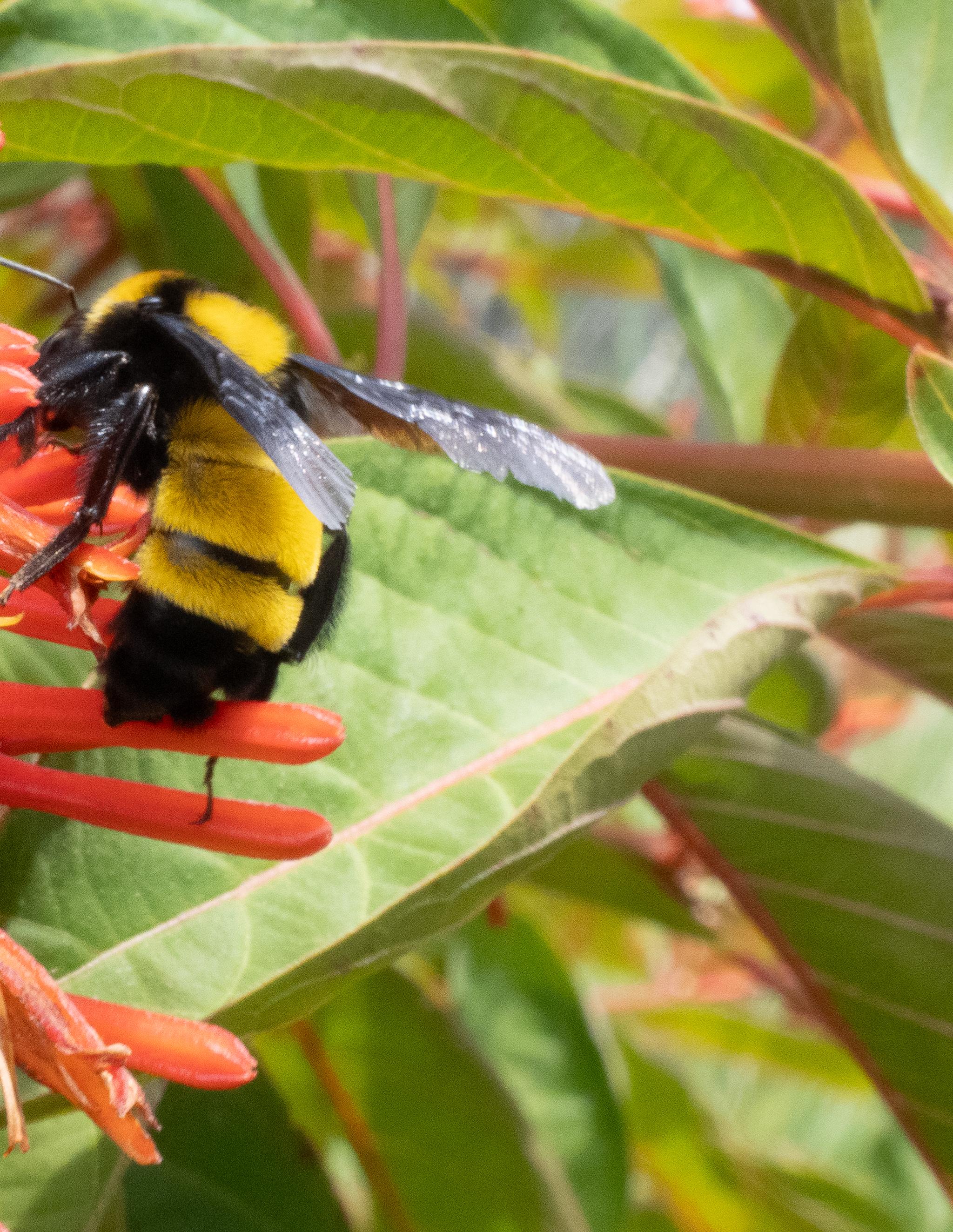
The Teaching Garden is divided into eight distinct sections, each designed to teach specific skills and concepts about organic gardening.
• The Herb Garden offers classes on growing and using Italian herbs for cooking, as well as medicinal herbs for healing.
• The Children’s Garden provides young learners from The Nest Nature School with six weekly classes, where they grow their own vegetables in raised beds.
• The Flower Garden brings beauty and altruism together, teaching children how to create floral bouquets to deliver to hospice patients.
• The Vegetable Garden focuses on growing food in the Texas Hill Country, while the Chicken Coop educates on the benefits of backyard chickens.
• The Compost Station teaches visitors how to compost at home or commercially.
• The Garden of Dreams is a sensory garden for visitors aged 55 and older, featuring raised beds, shade structures, and seating areas for enjoying sights, sounds, smells, tastes, and textures.
• Finally, the Community Education Garden allows groups like Deep Roots and our Homeschool Program to grow food from soil to table in their dedicated garden beds.
These spaces provide diverse opportunities for all ages to learn, grow, and share in the joys of gardening.
The Teaching Garden also stands as a living example of permaculture farming, where human activities work in harmony with natural ecosystems. By promoting no-till gardening, we allow microbial activity to flourish, build healthy soil and draw carbon out of the atmosphere. These practices both heal the earth and demonstrate sustainable gardening that can be implement at home.
Through workshops and demonstrations, visitors gain insight into how permaculture methods conserve resources and restore the land. The goal is to educate the community on how small, thoughtful changes in their gardening habits can contribute to broader environmental conservation efforts.
With this new plan, the Teaching Garden at Herff Farm will continue to grow as a center of learning, community, and environmental stewardship. We invite you to join us as we cultivate a deeper connection with nature, one that fosters knowledge, kindness, and care for generations to come.
Please check our calendar at cibolo.org to view upcoming events and workshops.
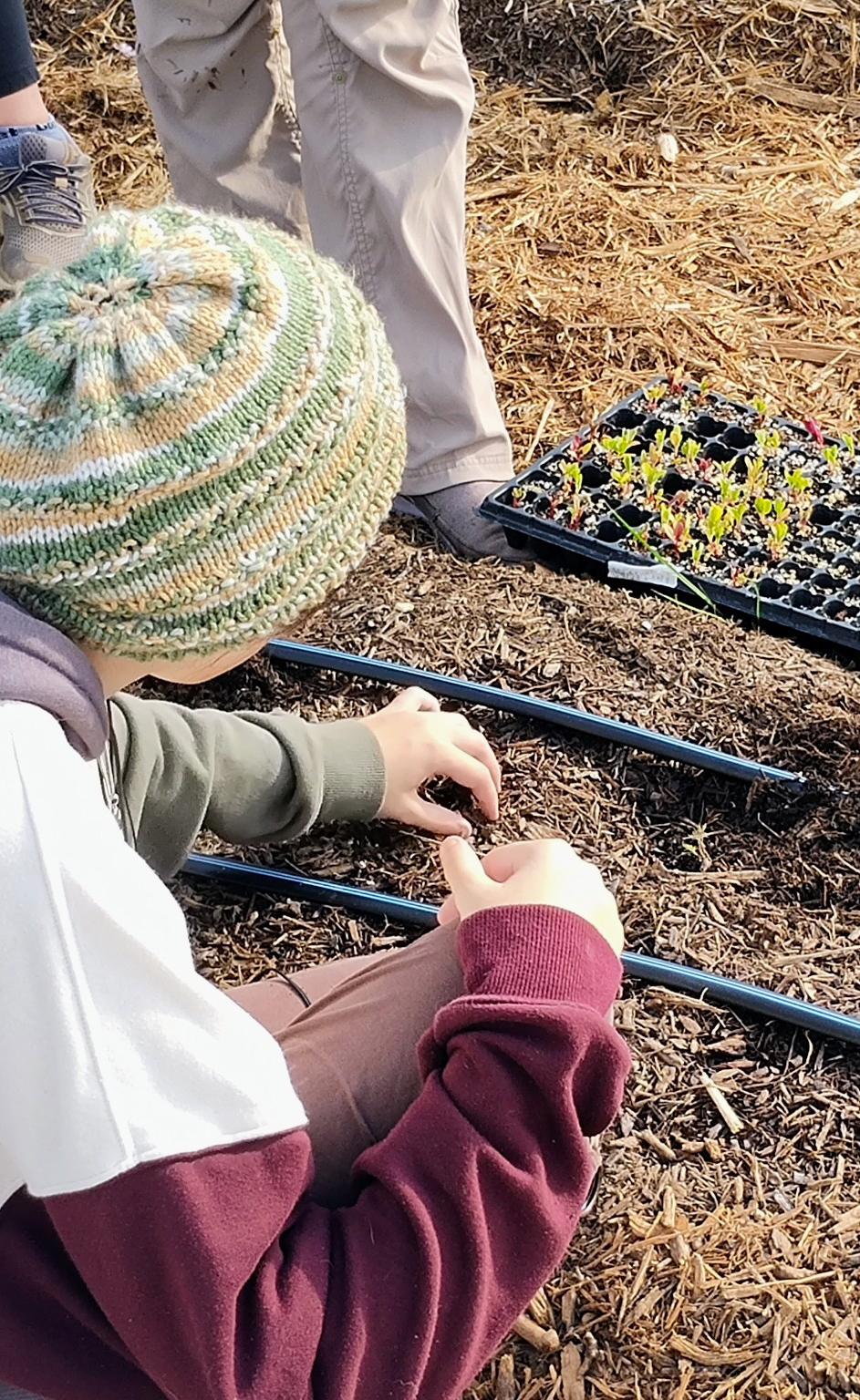
As the transitional period between summer and winter, fall in the garden is our saving grace. The Latin word “autumn” first appeared in English during the late 14th century, gradually displacing the original “harvest” by the 16th century. Hints of fall (a short and sweet modern alternative to both names) are always nicely complemented by the full Harvest Moon, but never fully arrives until the autumnal equinox. The Harvest Moon rises around sunset for several nights in a row, traditionally providing farmers and gardeners with just enough extra light to finish their harvests. At Herff Farm, we embrace this abundant season by inviting our Texas Hill Country community to immerse themselves in the wonders of our Teaching Garden. This time of year offers a unique opportunity to deepen our knowledge and understanding of the natural world.
Through educational workshops we nurture curiosity and wonder, fostering a connection between our community and the land. From basic soil science to seed propagation and deep dives into organic gardening, our expertled classes answer questions from how you can improve soil quality to why it’s important to use
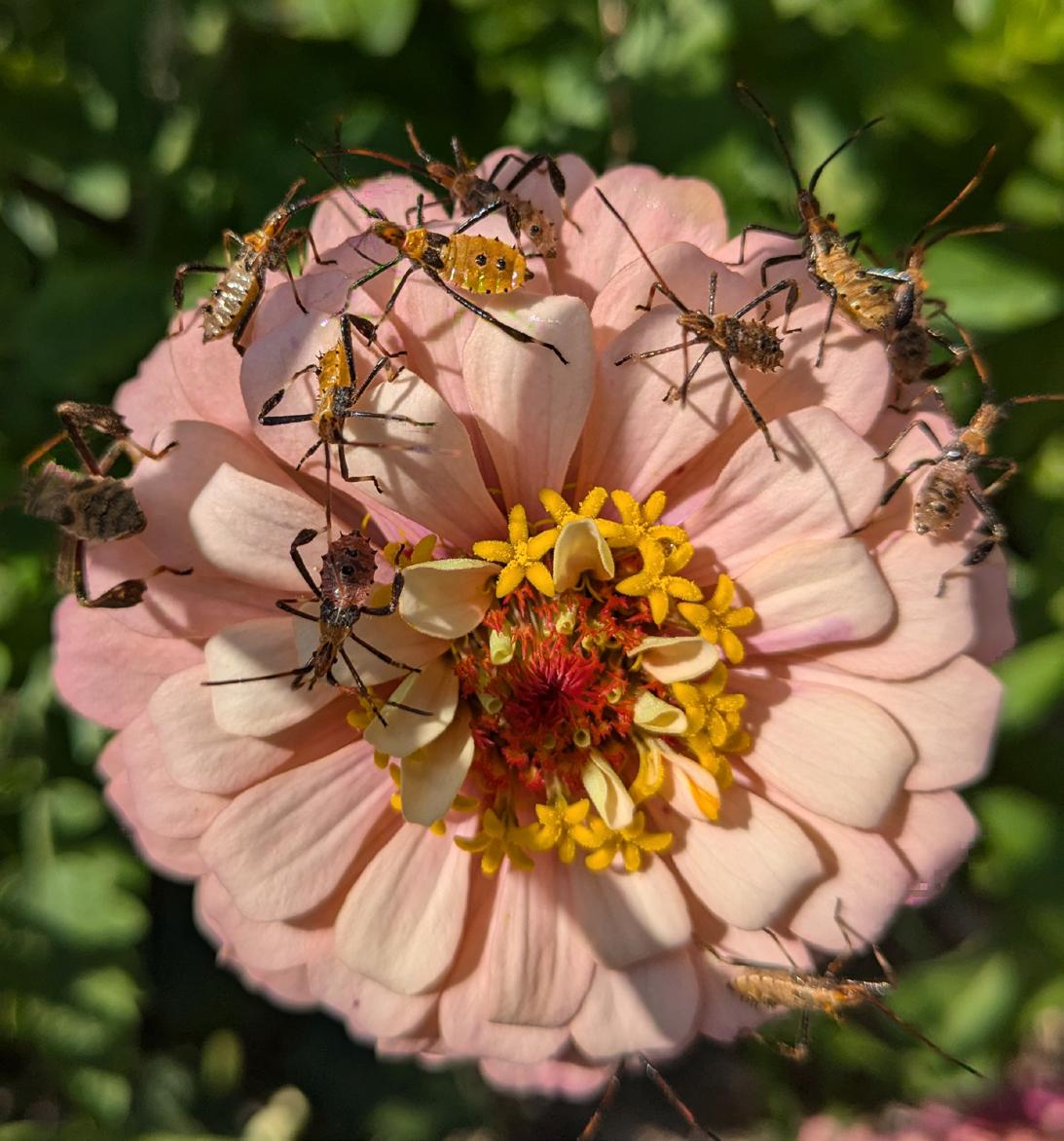
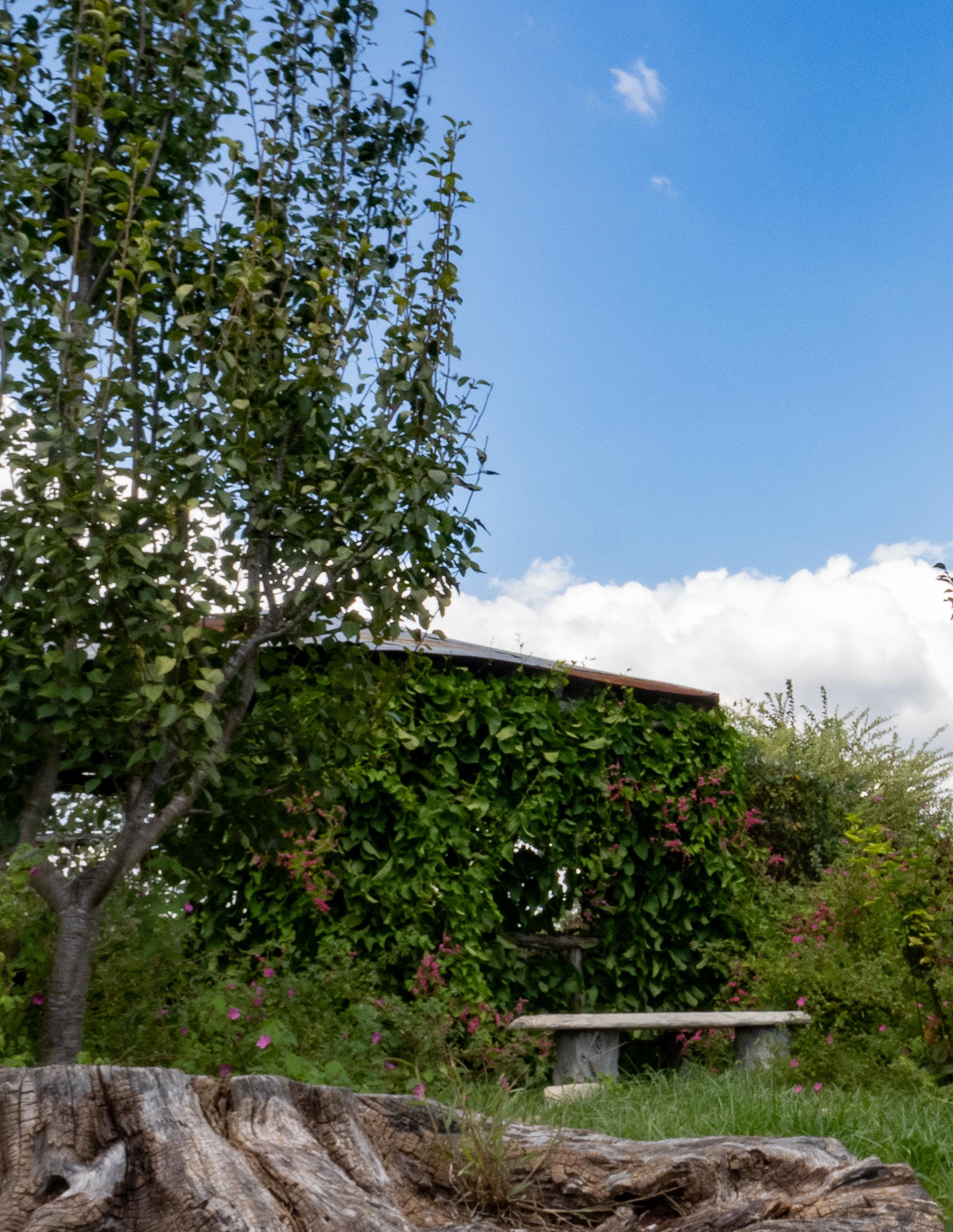
Emily Nickerson Farm Educator
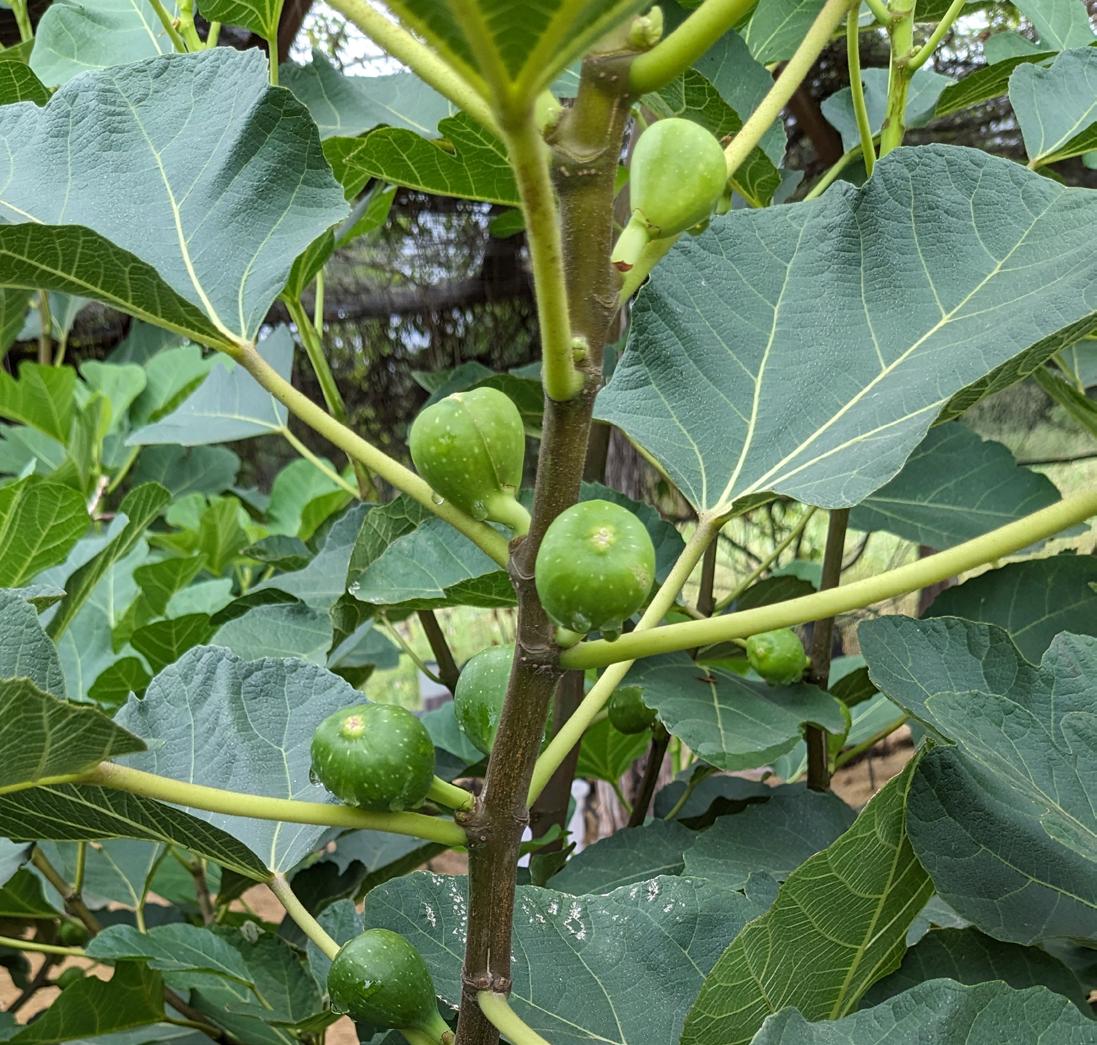
natural resources in organic gardening. These year-round workshops are designed to empower participants with the knowledge and skills needed to appreciate and sustain the beauty and bounty of the garden during autumn and beyond.
We also enjoy inviting local experts from the community to lead specialized workshops, enriching our programs with their unique insights

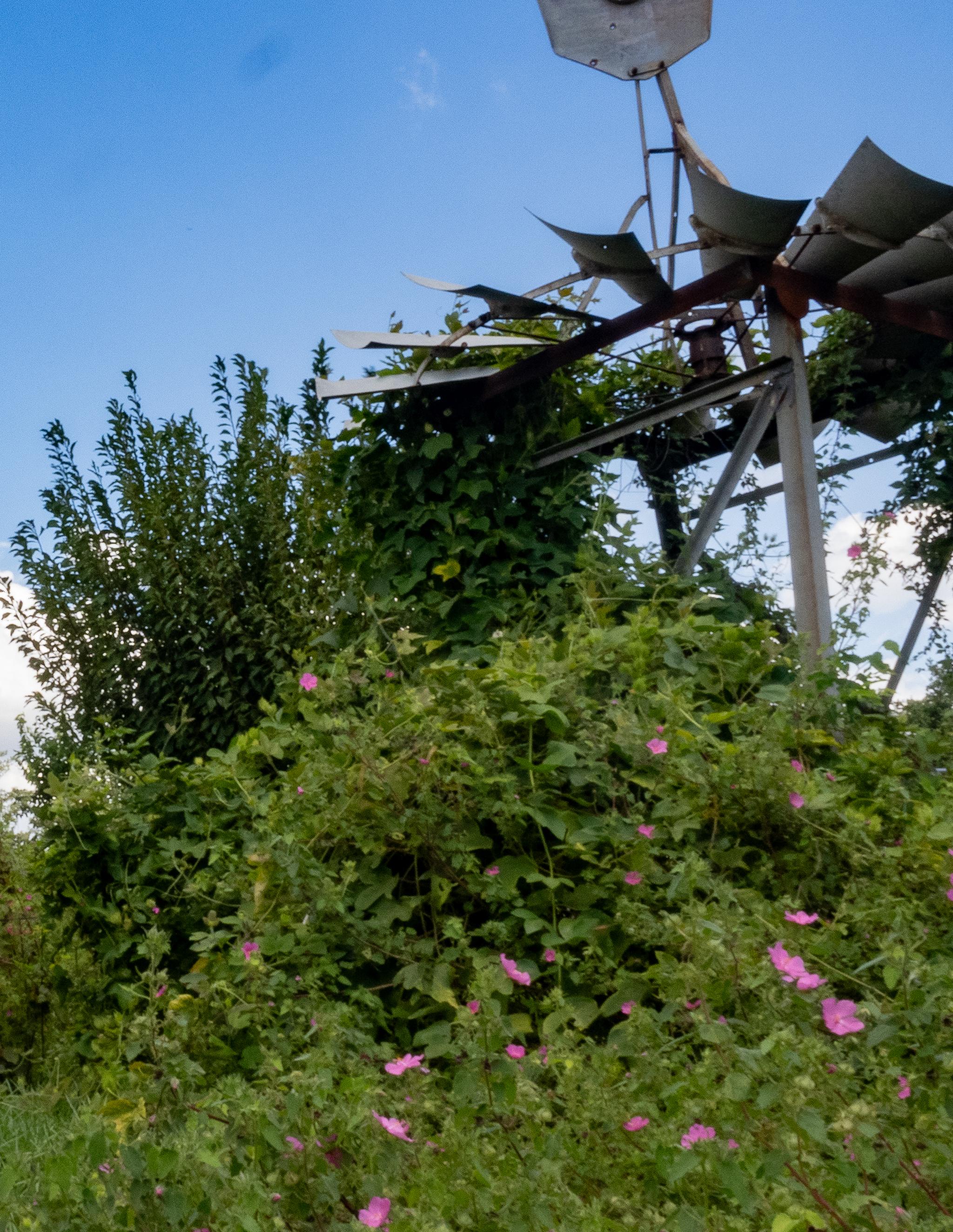
and resources. This summer, we had the pleasure of partnering with Lilly, owner of Pipe Creek Soap Company, to offer goat yoga classes at Herff Farm. Science has shown even the presence of goats helps our bodies release a flood of endorphins, boosting our happiness. Recently, we also partnered with the Central Texas Mycology Society to offer hands-on workshops that discuss the importance of mushrooms and teach participants how to grow them at home.
Soon, Herff Farm will host Farm-to-Table events by working with local chefs from Boerne, TX, using organic produce from the garden. We also intend to feature more cooking classes like our popular Sourdough Workshop with Andrea Bohn, which showcases the art of making sourdough and why it’s beneficial to our microbiome.
From growing your own food to cooking it, and every sustainable practice in between, we strive to offer inspiring workshops throughout the year. Nature always teaches us lessons if we’re paying enough attention to reap the benefits like harvests in the fall. By exploring the rich tapestry of the seasons, where the rhythms of nature and the pursuit of knowledge come together to enrich our lives and our environment, we hope you fall in love with The Cibolo Center for Conservation and Herff Farm.

To sign up for upcoming workshops, please see our events calendar and stay tuned for more coming next year.
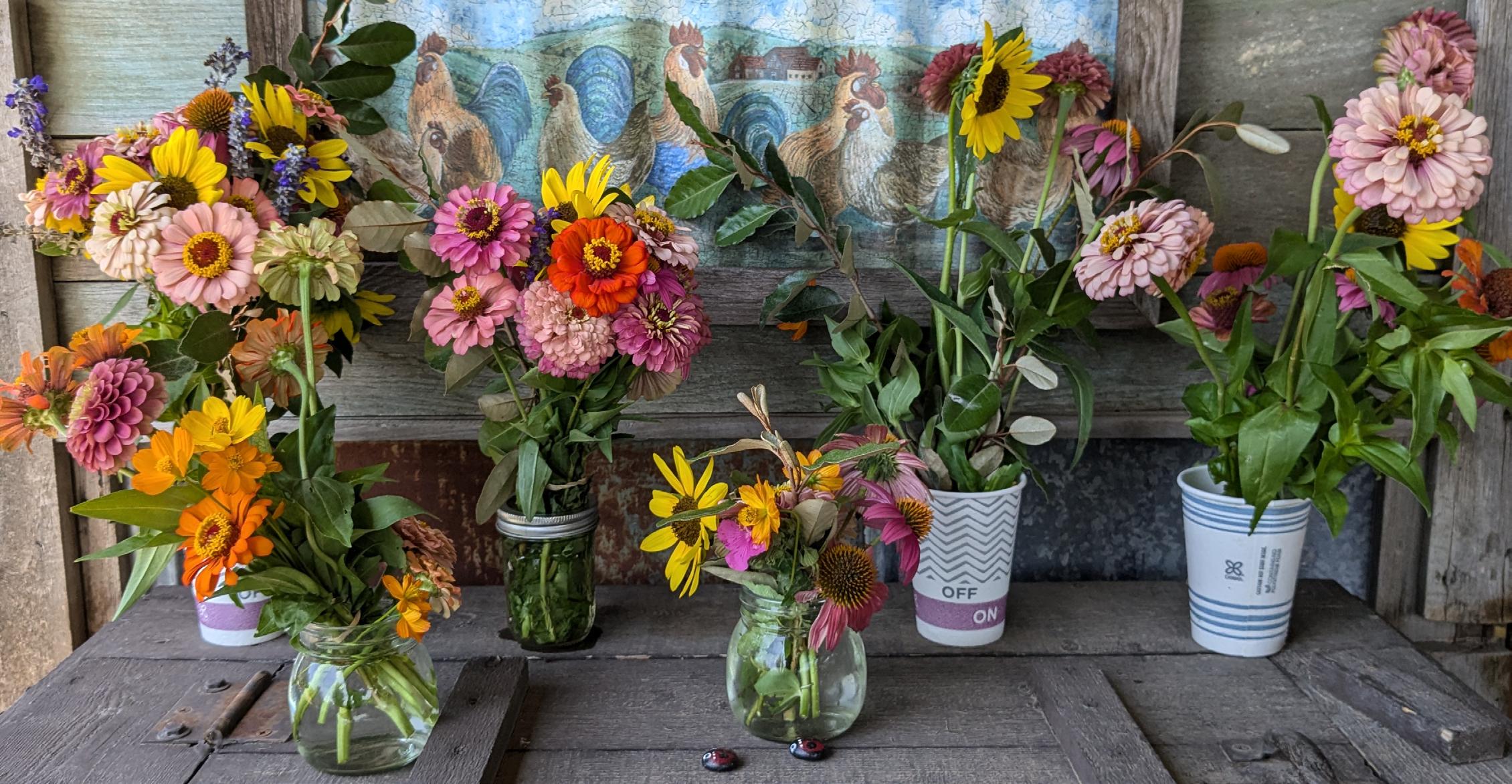
Land Stewardship is alive and well at The Cibolo Center for Conservation! As the Land Manager at The Cibolo, the key to succeeding here is understanding the land you’re looking at before making any changes. I was handed the Wildlife Management Plan on April 15, 2021, and off into the wild I went.
The plan sought to address the areas of greatest conservation need across the five ecosystems at The Cibolo. Over many days of roaming the woodland, prairie, creek, riparian zone, and marsh, I devised my approach to begin “checking the boxes” of many executive action items—but I’m typically not one to stick within a box. By traveling the property daily, I may get scraped, slashed, prodded, and poked, but I become intimately involved with the land by learning where everything is located and how it interacts. During this process of hands-on land stewardship, I also met with key players, from city officials and local naturalists to staff members and guests, to glean insight into a greater mosaic of needs and wants. After all these discussions, I learned there were many layers to address within each
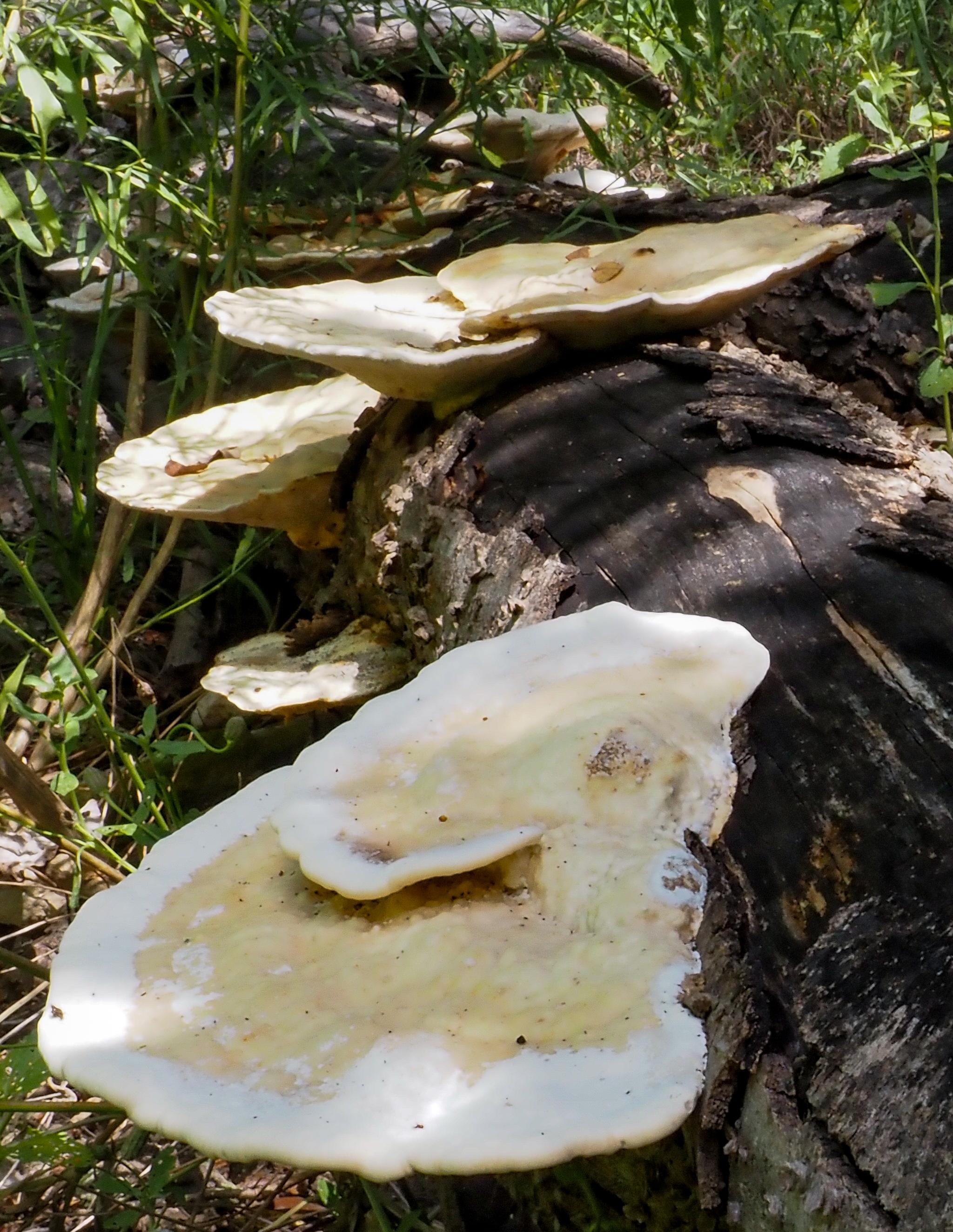
David Touchon Land Manager
category, small strokes of the paintbrush, if you may. Through these interactions, I created a Wildlife Management Plan 2.0 to bring the whole strategy together.
The number one thing I do is “steer” people and plants in the right direction. A nature center is “wooly” by design, but land management must gently nudge and wisely promote a healthy, efficient space for native flora and fauna. A few examples are the restoration of our creekside and prairie, the strategic addition of berms and swales, and collaboration with local groups like the Eagle Scouts to improve our trails.
We expanded the initial creekside restoration area by slightly improving upon the original principles and utilizing slash, fencing, and signage elements. Similarly, we created two prairie restoration areas, once common walk-throughs, that are now situated on the north side of the nature center parking lot and recovering well. To aid in the reclamation of native vegetation, we’ve also taken measures like closing Milkweed Run to allow for restoration of the Antelope Horn and native

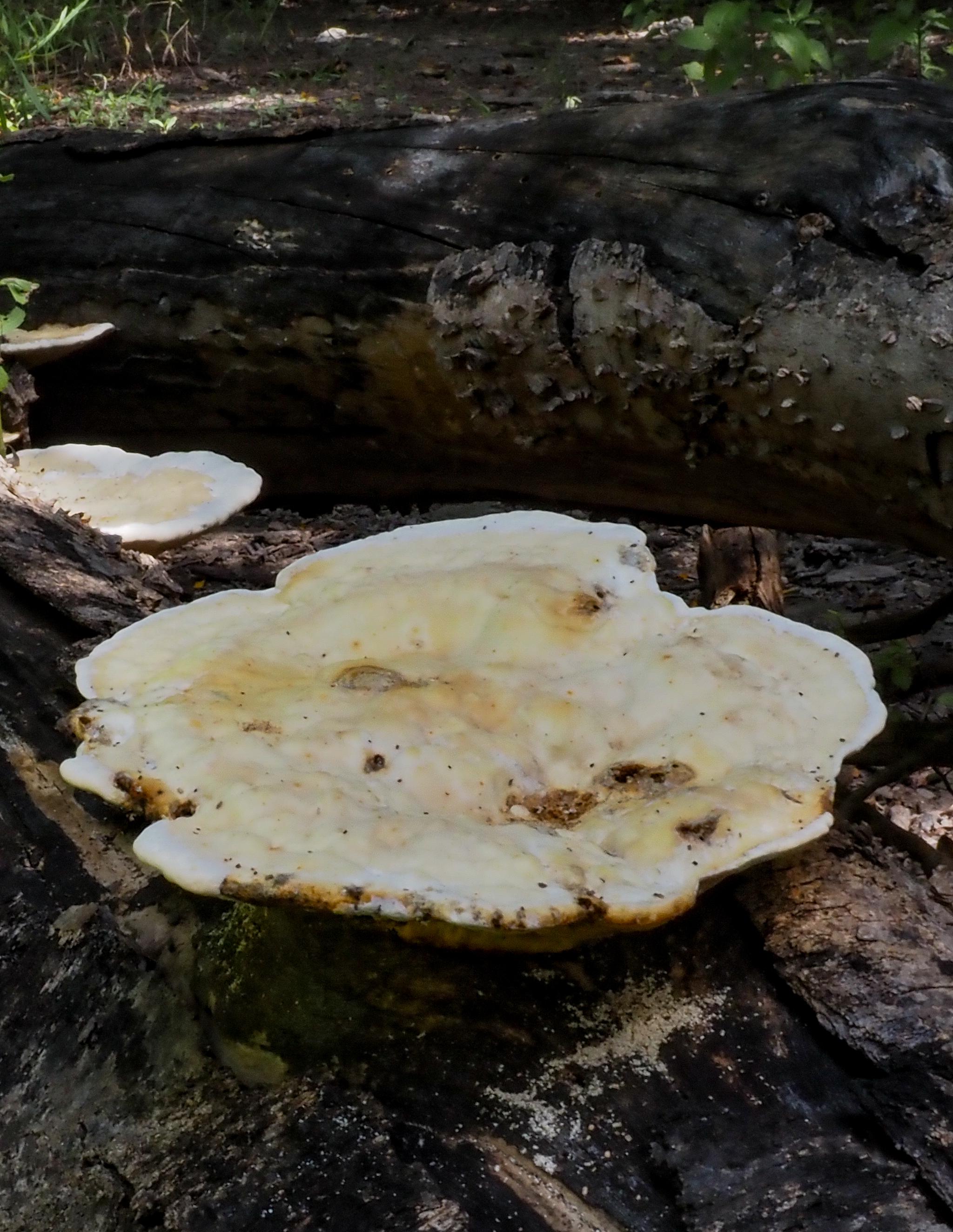
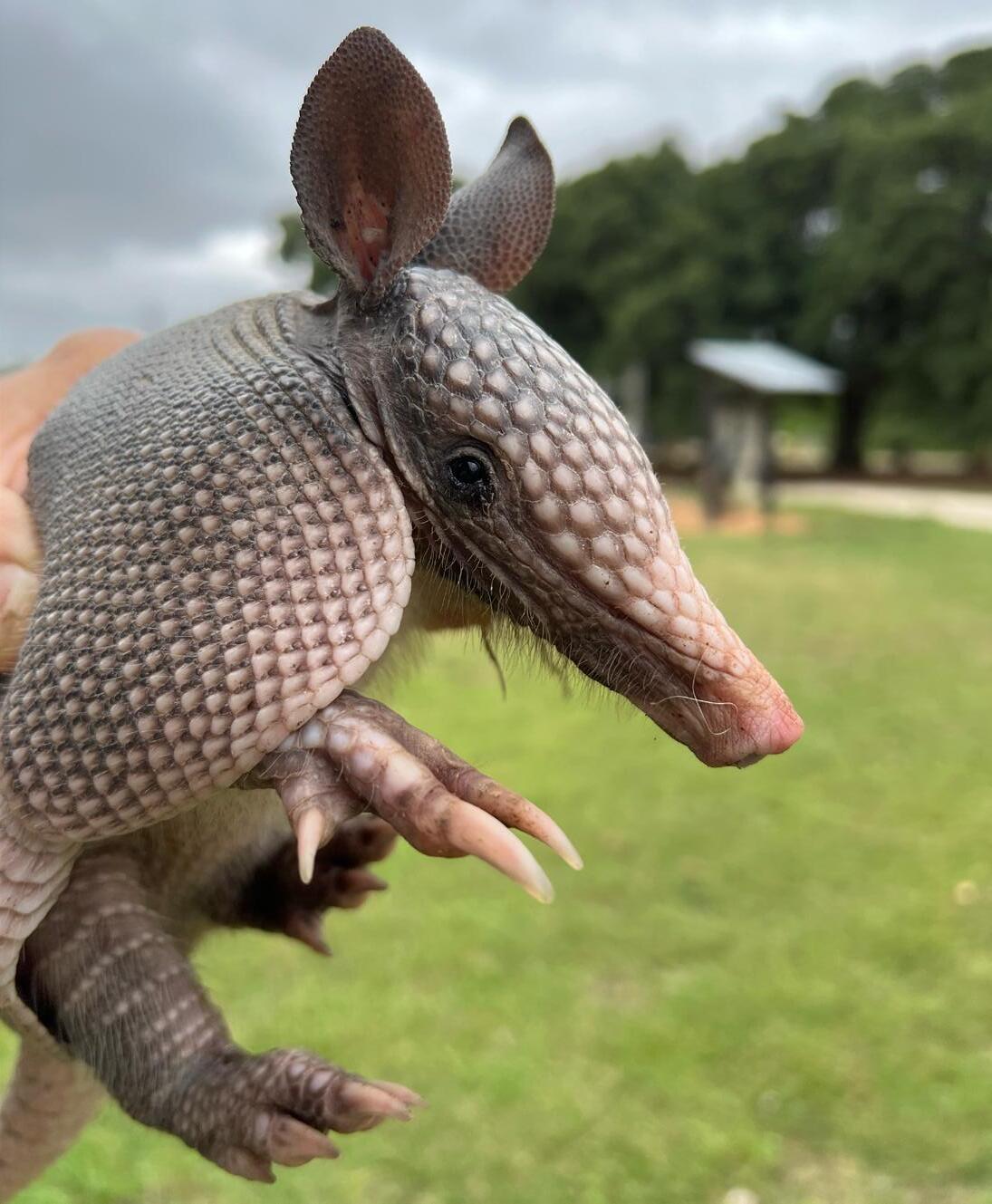
grasses and fostering forb growth at the farm through box ripping, tilling, and surface removal. These combined efforts represent a significant commitment to both expanding and continually refining our restoration projects to benefit the land, water, and wildlife.
Never miss an opportunity to make a berm! These raised earth barriers are crucial for preventing soil erosion and managing water flow. At Herff Farm, berms and swales were strategically constructed using old spoil piles from prior construction efforts. Since everything on the ground wants to end up in the creek, two swale and berm systems were established on the north and south ends of the farm, and Juniper Gabions were installed to direct water flow along the northern boundary properly.
Trails allow access to the wildscape, but this usage creates wear on the land. Many projects have involved the installation of water bars, mulching, and check dams to keep the soil on the land and not in the creek. We are grateful to the various volunteer groups that have added countless tons of mulch and hundreds of water bars to our trails to thwart erosion and improve soil moisture absorption, resulting in restoration.
I’ve particularly enjoyed working with the local Eagle Scouts on projects along the Woodland and Narrows Trails to prioritize conservation efforts that align well with the BSA Distinguished Conservation Service Award, one of the highest honors a scout can receive on a national level. I intentionally redirected these projects towards a conservation ethic to align with the award requirements, emphasizing land repair, soil retention, and earthwork in remote locations. This shift requires careful planning and logistics, given the absence of modern conveniences like power. The scouts took the challenging conditions in stride and significantly improved trail safety, access points, and land health. I spent 28 years in the outdoor education field, and one of my passions is ensuring every volunteer group receives excellent instruction concerning the project while enjoying camaraderie and lasting memories.
I believe everything is a teaching opportunity. Leave it better than you found it! Conservation is the wise and efficient use of a natural resource, and ours is The Cibolo—a gem nestled within the city of Boerne where nature does its thing while being gently governed by intentional stewardship practices. Onward and upward!
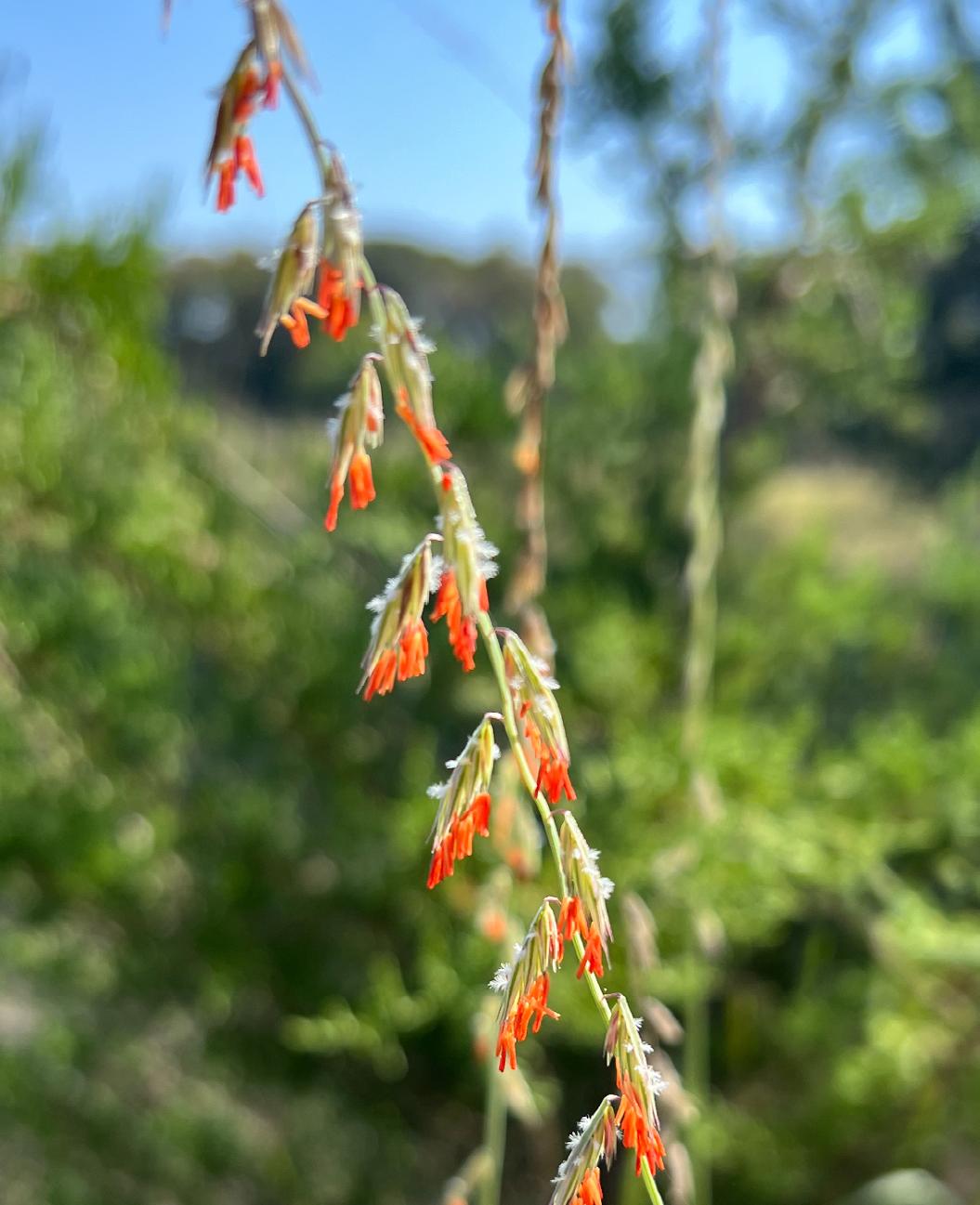
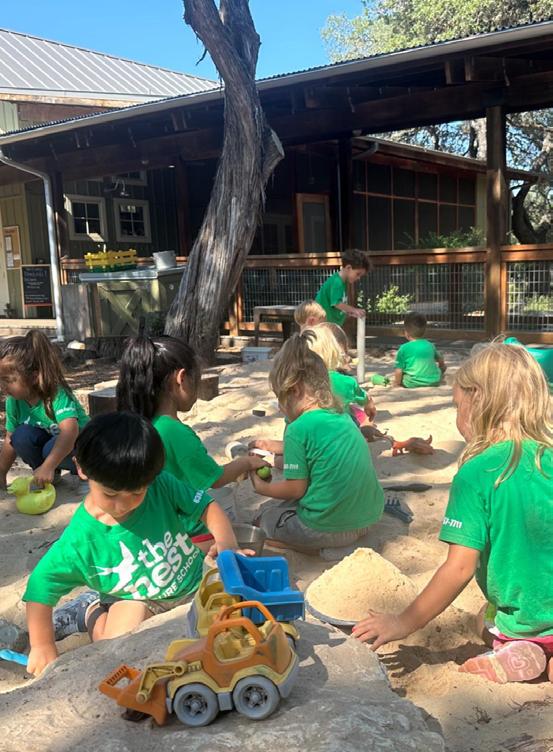
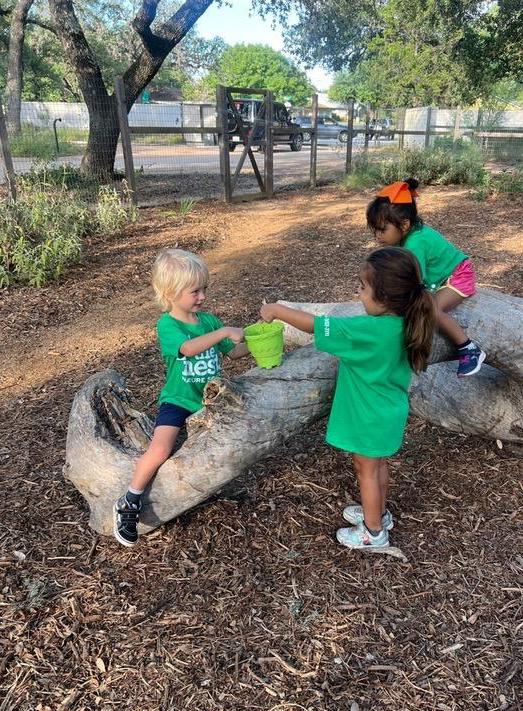
While parents drop off, leaving their child with hugs, kisses, and all of their love, Painted Bunting students head off to the playground. Some wait by the fence to wave and listen for the sound of beeping car horns to bid them farewell, and others run straight to the sandbox or climb trees.
When everyone has arrived, our day begins. We head to Nature Nook (an outdoor space curated to loose parts and unstructured play) for centers and free play. This is where the magic of nature school happens. Students create a stage on the picnic tables to perform The Little Mermaid, building off play from last night when they got together at Dog and Pony for an evening of activities with other Nest families. Others spend this time creating potions or covering themselves in paint.
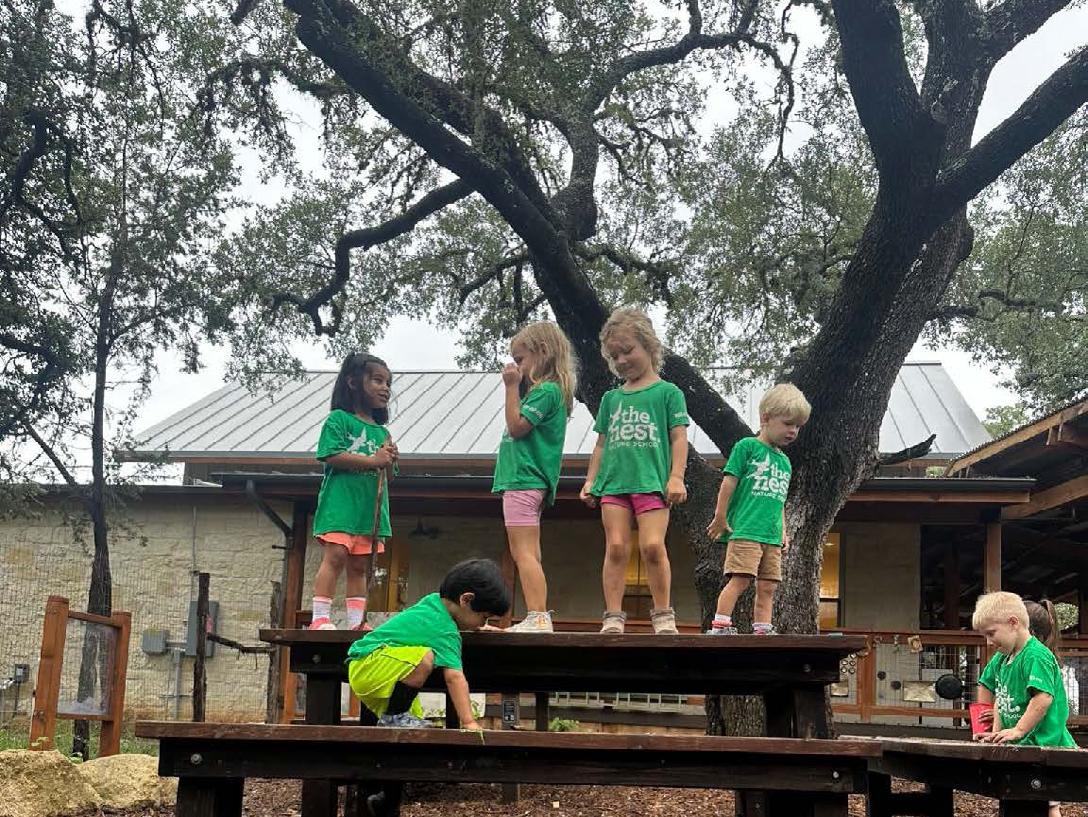
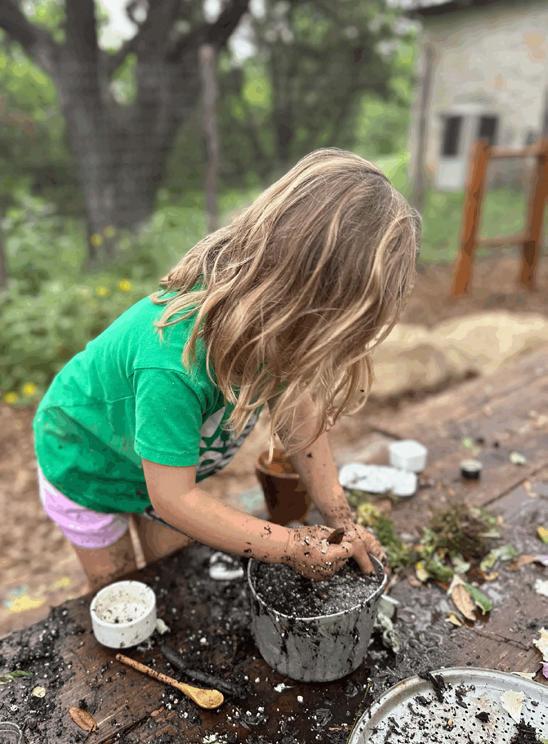
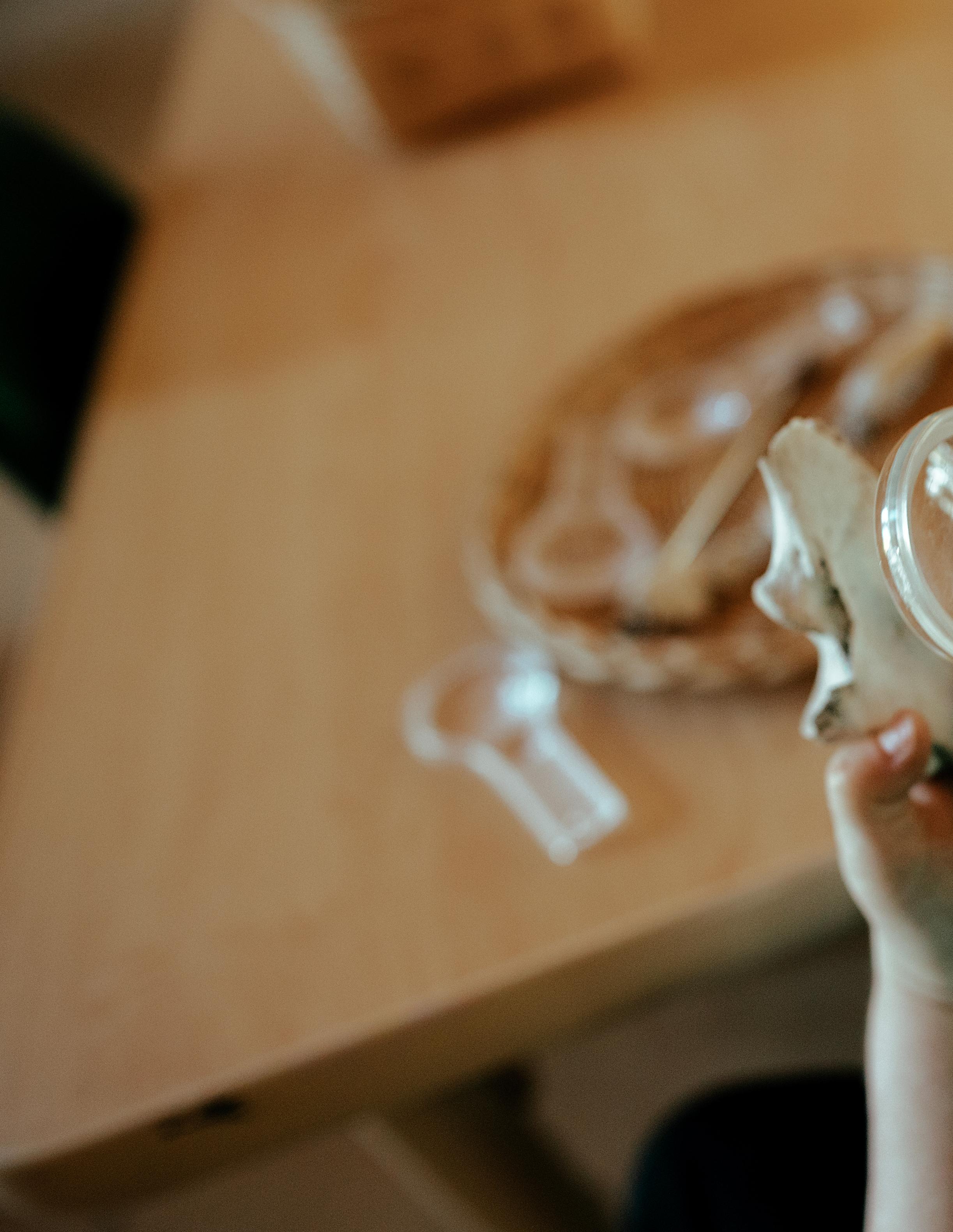
Emily Smith Lead Teacher
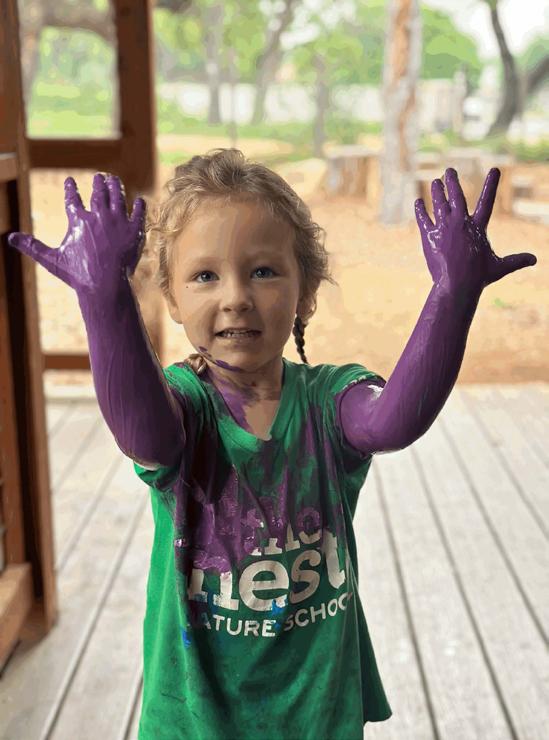
At centers, students have the opportunity to engage in a variety of activities. These centers are curated to meet the needs and interests of the students. Right now, the students have shown a
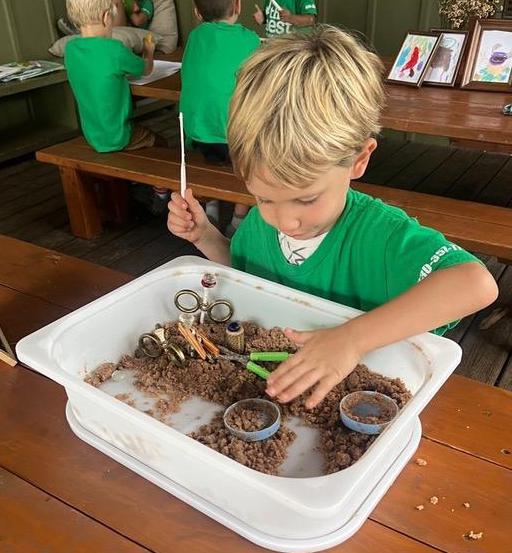
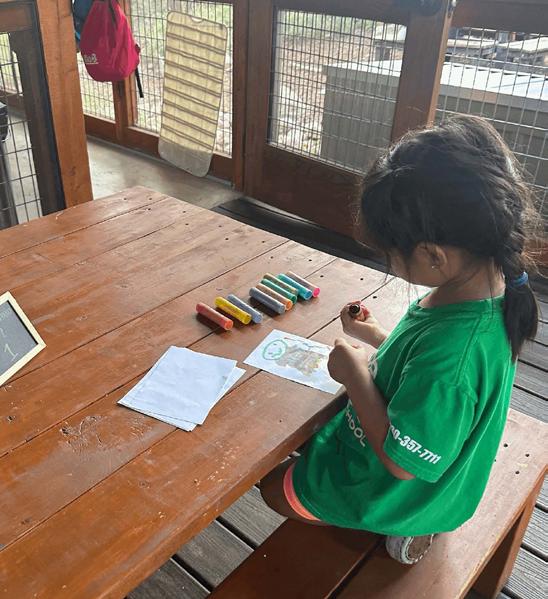
deep interest in art and sensory-seeking activities. To meet these needs, they can explore free art, portrait painting of themselves, painting with feathers, a sensory bin of flour and oil, and a cozy spot for reading.
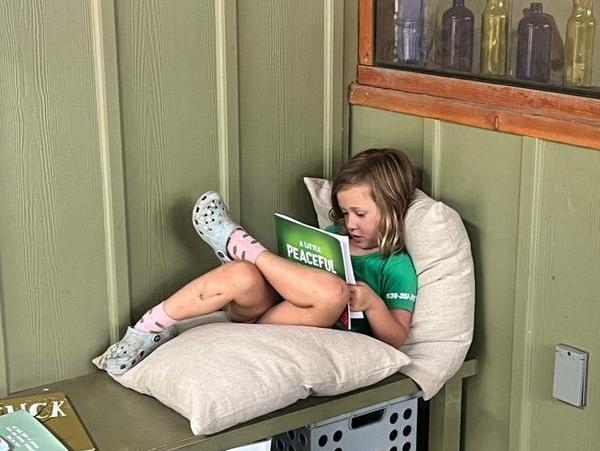
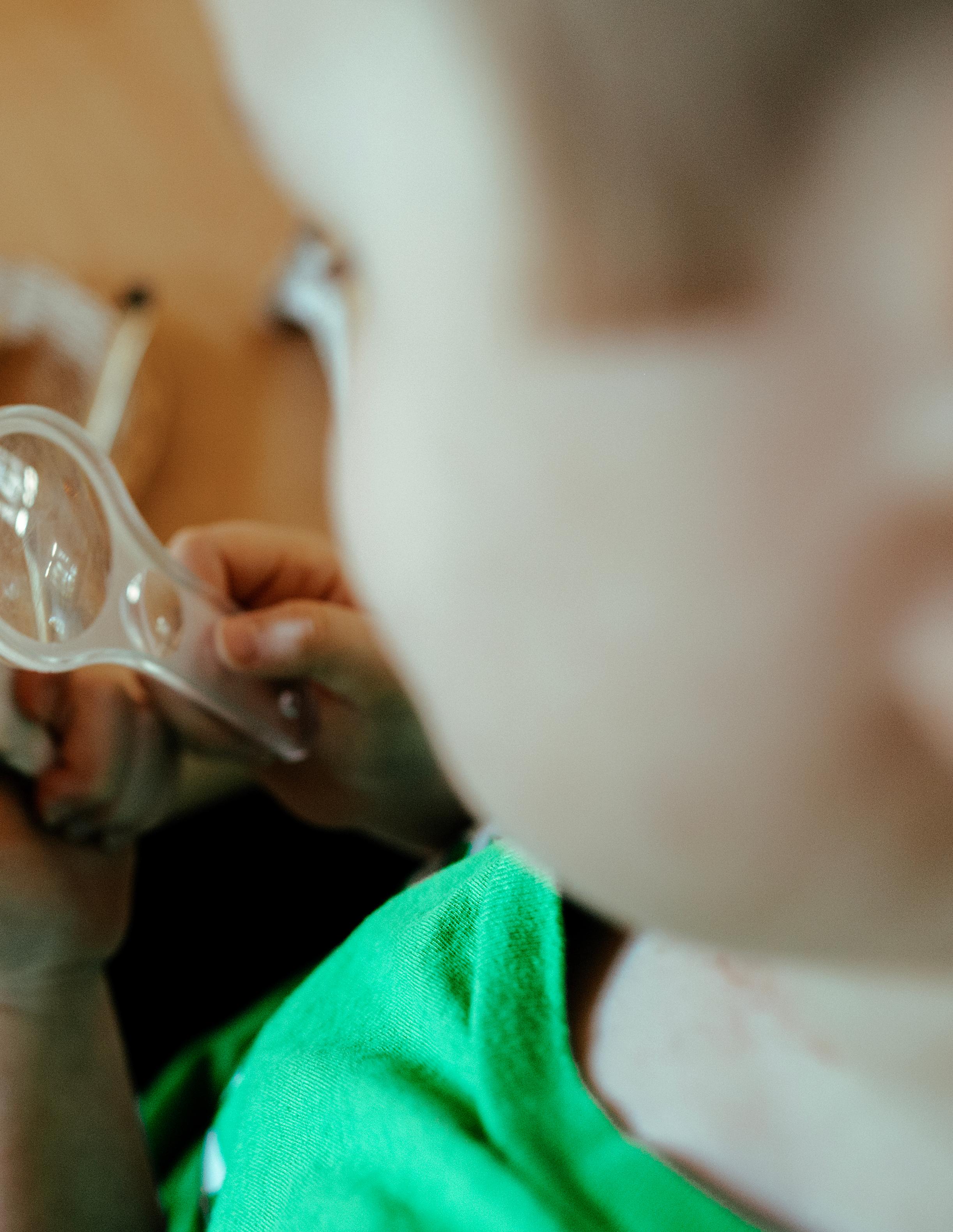

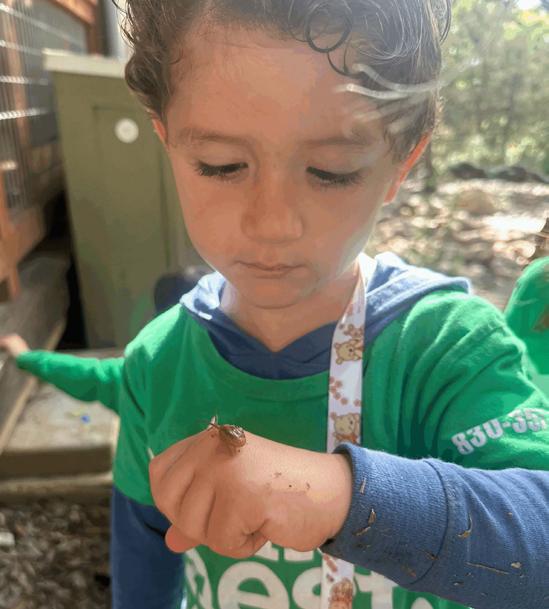
Then, it is circle time. We sing good morning, vote on our hike for the day, and the meteorologist checks the weather. This week we have focused on our senses and learning about our cottage bird, the Painted Bunting. Walking in our Peace Garden was the perfect way to introduce all five senses, taking time to stop and observe our surroundings.
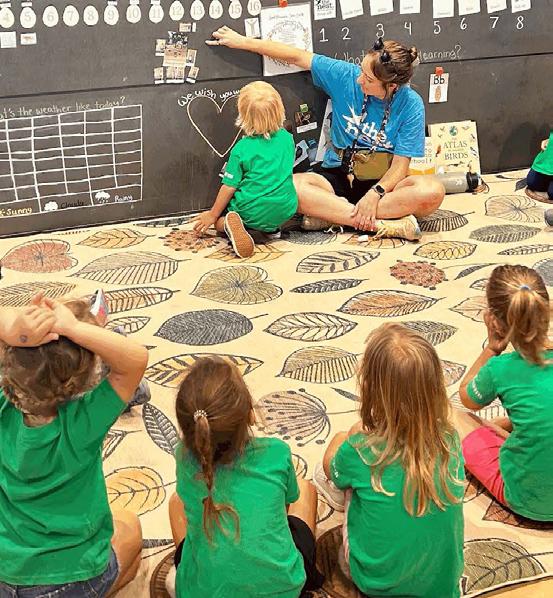
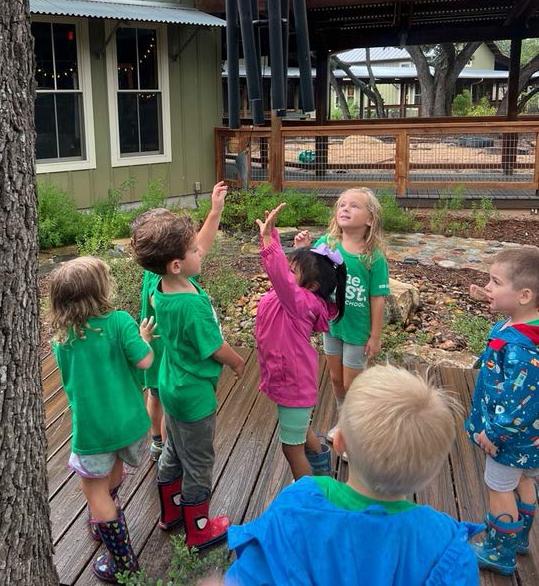
Then it is time for lunch and a hike. We sit together at picnic tables and develop valuable life and social skills. On our hike, we climb trees, play games, and search for rolly pollies. Immersed in our imagination, snails are collected, homes are constructed for the precious rolly pollies, the creek becomes our classroom, and the world is whatever we make it.

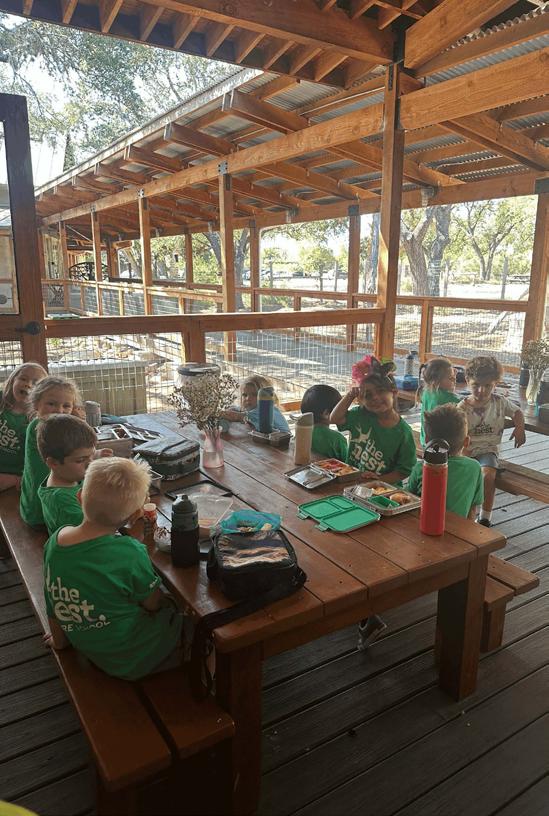
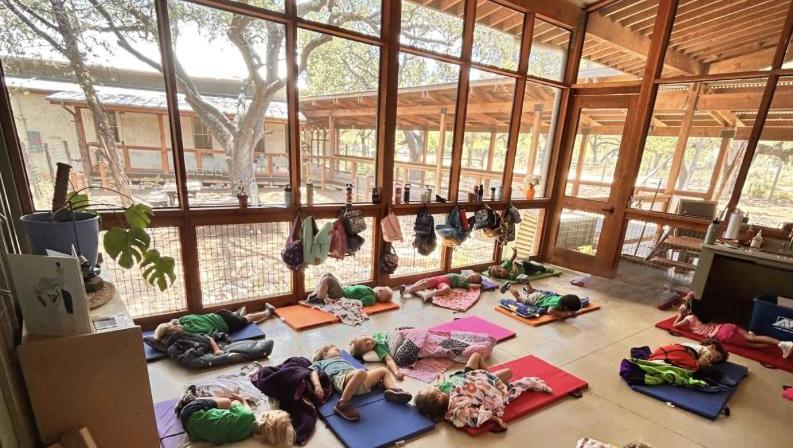
At the end of the day, we meet to sing our goodbye song and reflect on our day. This week, we have been talking about Peaceful Spot—a fun little stuffy that helps calm our minds and our bodies through mindful breathing. Doing this readies us for rest time.
Rest time is crucial to strengthen our wild hearts, strong bodies, and inquisitive minds. Doing this on our screened-in porch allows us to reap the benefits of fresh air and a connection to nature even in the mundane moments.
Before we go, we enjoy a family-style snack. Sustainability and independence are encouraged here. Students grab their plates and reusable napkins and sit down to serve themselves, passing food to their friends so everyone has a chance to try the snack. Amongst themselves, they giggle about their day, talk about their family, and fill their bellies with healthy food.
Before we know it, grown-ups are back, and students run to embrace them with hugs and all the memories of their day. And in the morning, it all begins again.

Nature-based education is a quickly growing philosophy across the country and flourishing right here in the state of Texas. A 2022 survey showed approximately 800 nature-based preschools in the country; there were less than ten reported in 2010. The Nest Nature School is at the forefront of this new movement into the outdoors, and we aim to be an example of what can be accomplished when schools break out of their four walls.
Since our start in 2016, the main focus of The Nest has been to embrace nature around us and allow it to spark the students’ curiosity and desire to learn. Following national trends, The Nest Nature School opened to a full capacity of 90 students in the fall of 2022 and has been gaining steady traction ever since.
At The Nest, nature is the heart of our curriculum. We believe in creating a sense of child-nature reciprocity. Our work is about more than just getting kids outside—we want to nurture their relationship with the world. When children learn while immersed in nature, it sparks a passion in them and grows their connection to and love of the world around them. Hands-on experiences promote a deeper understanding and lead to a lifelong desire to learn more.
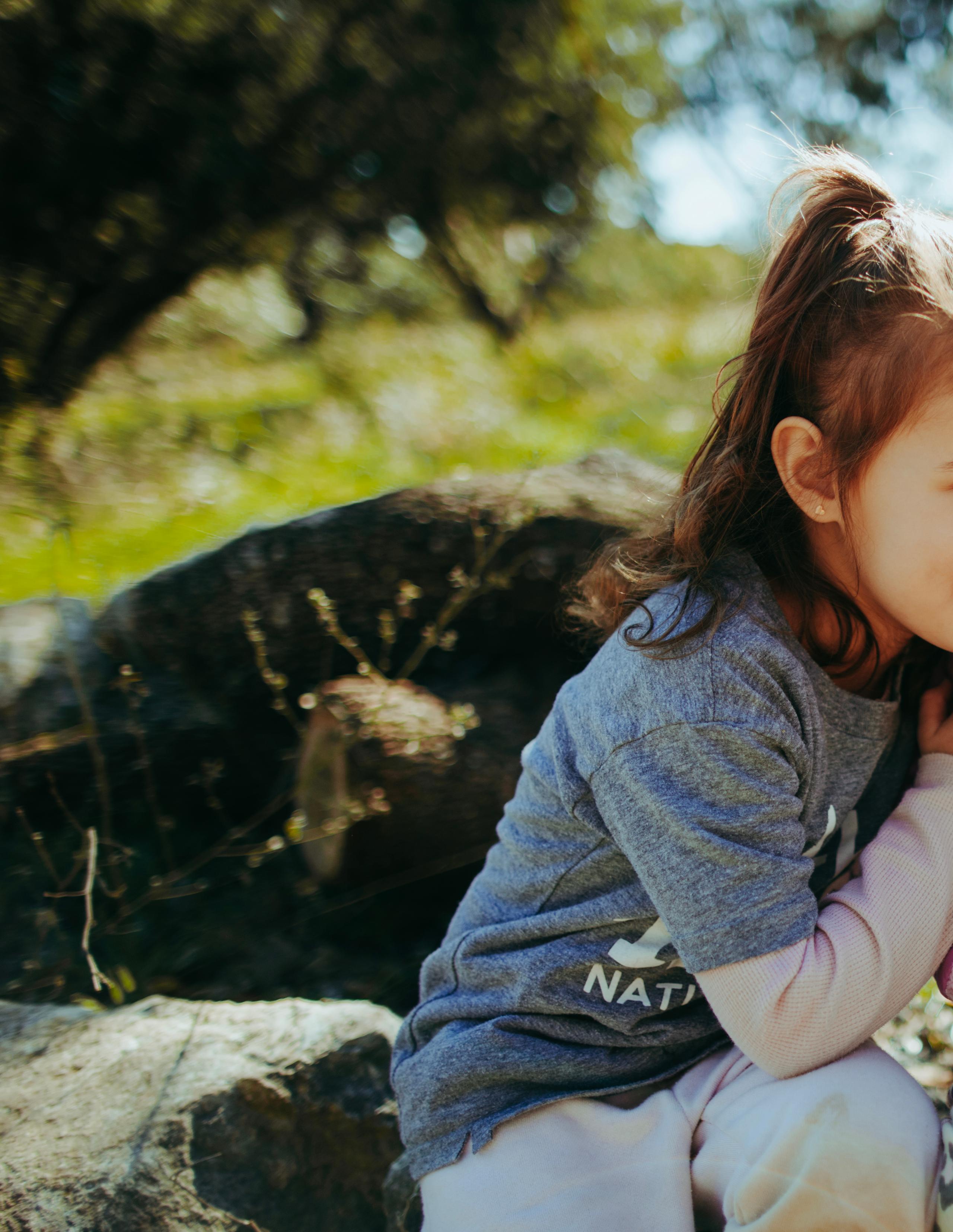
Alysa Meeks
The Nest Director
Before diving into all the many benefits of this approach, we need to define the term “naturebased education.” We describe it as spending over 70% of the school day outdoors and embracing nature inside, outside, and beyond. When students need to be indoors for safety, our school focuses on a seamless transition to continue our philosophy by bringing elements of nature inside. We pride ourselves on not simply being outside but truly embracing nature as a third teacher. Focusing on lessons from nature instills a passion in not only our students but their families, as well.
Allowing children to spend the majority of their time outside has benefits far beyond academics. Nature-based learning has been proven to benefit brain development, communication, socialemotional development, emotional resilience, self-regulation, and executive function, while also reducing stress levels and promoting physical activity and a healthy lifestyle. At The Nest, we understand that academics will come as children are ready, focusing instead on preparing them to interact with peers, regulate their emotions, and problem-solve. These skills will, in turn, help their academic success as they grow beyond our school.
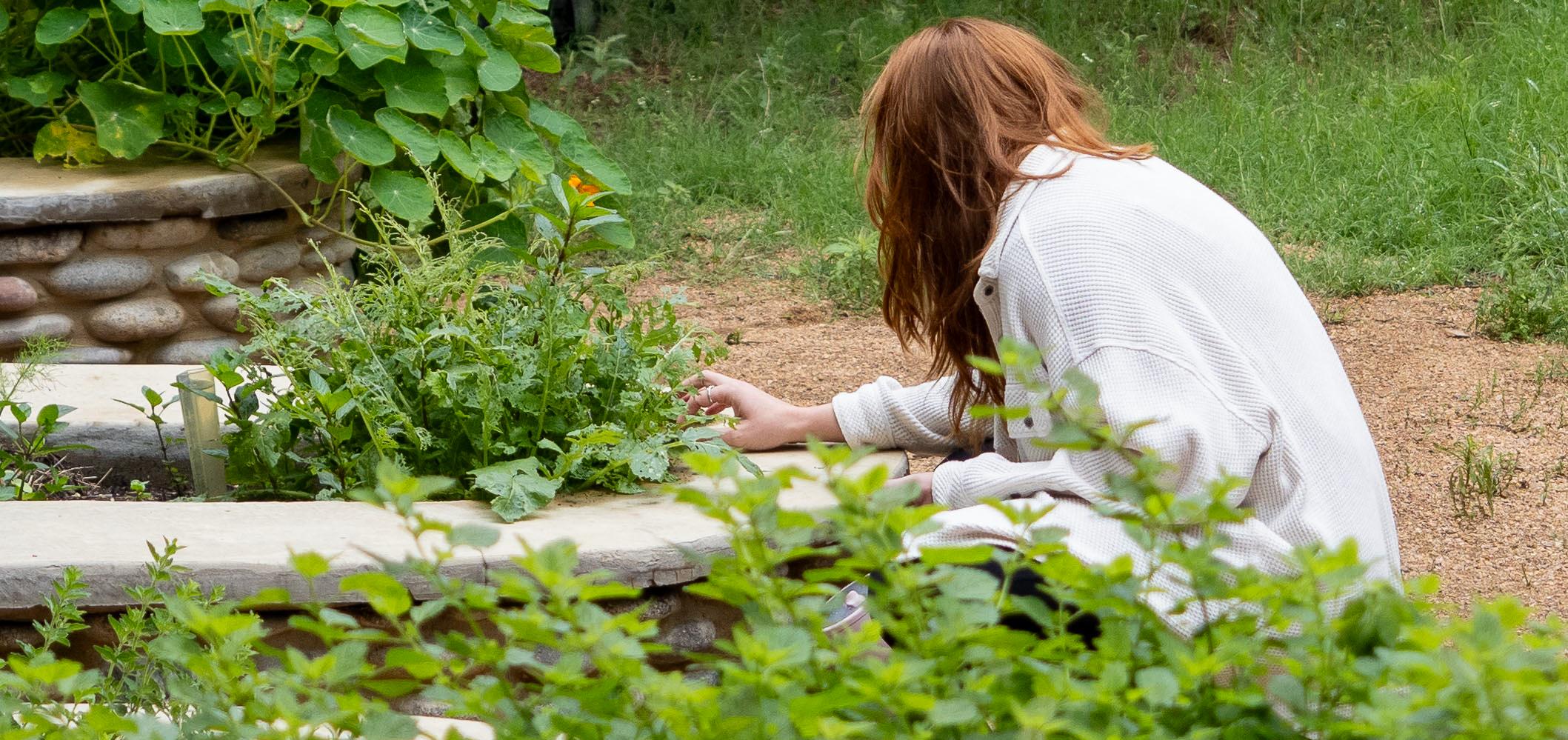
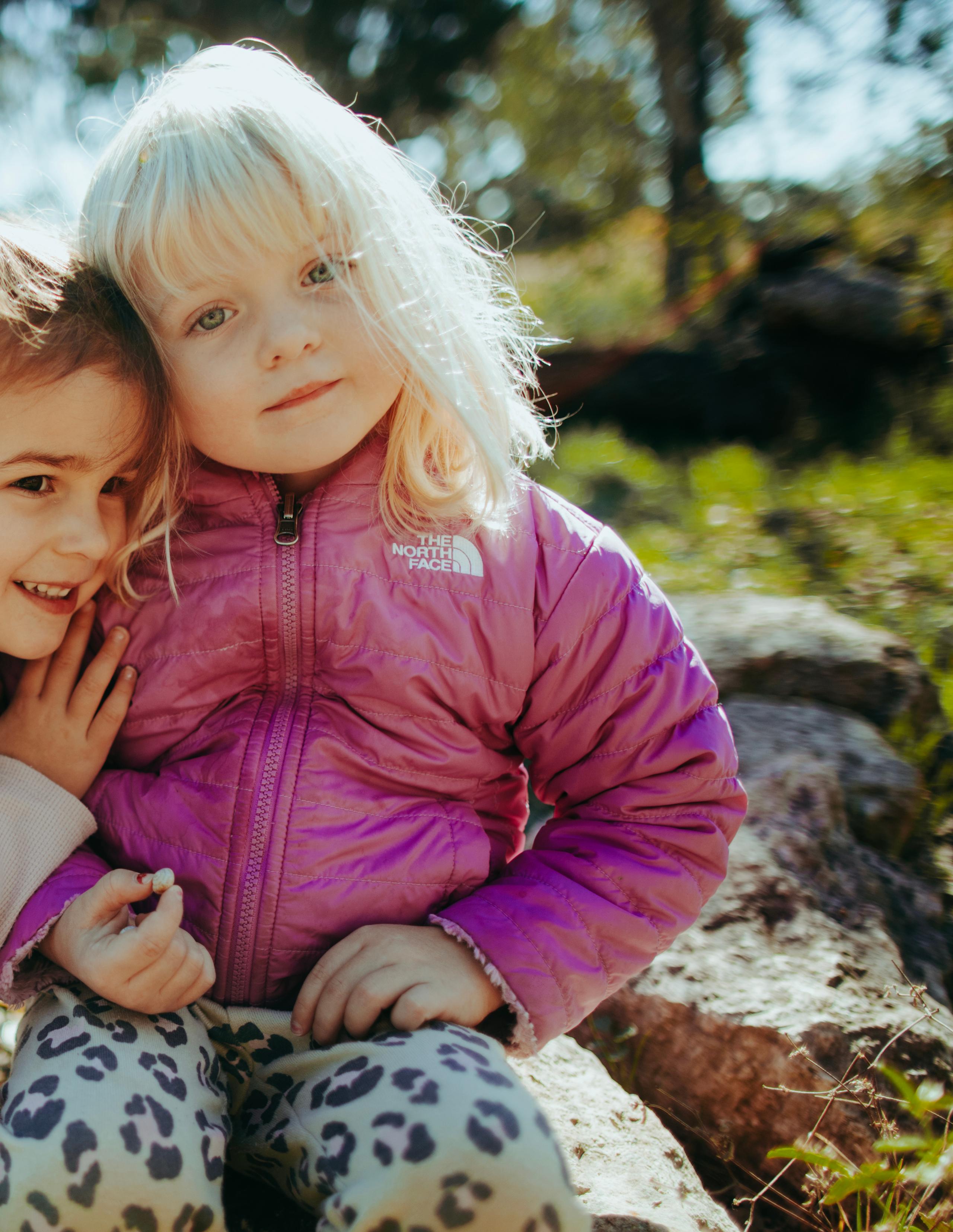
The Nest provides an environment that encourages children to use their imagination and express creativity. When children are given the opportunity to create their own games and ways of play it promotes communication among peers. The development of communication and social skills at a young age will prepare our students for elementary school and handling conflict with classmates, teachers, and families. Communication skills lead to improved problemsolving and critical thinking, giving our students an advantage as they are faced with more rigorous academics in elementary school.
Risky play is a major aspect of nature-based education, and it is fully embedded in our approach as well. This form of play is about allowing children to take calculated risks in a supervised setting. Teachers assess possible hazards and let children move at their own pace and confidence level. Engaging in risky play allows children to develop their critical thinking and problem-solving skills while increasing their self-esteem and confidence. Allowing children to take risks in a controlled environment at a young age will enable them to differentiate between risks and hazards, and work through risky situations they will experience for the rest of their lives.
The Nest continues to stay on top of the most recent data and studies regarding nature-based learning to remain one of the premiere nature-
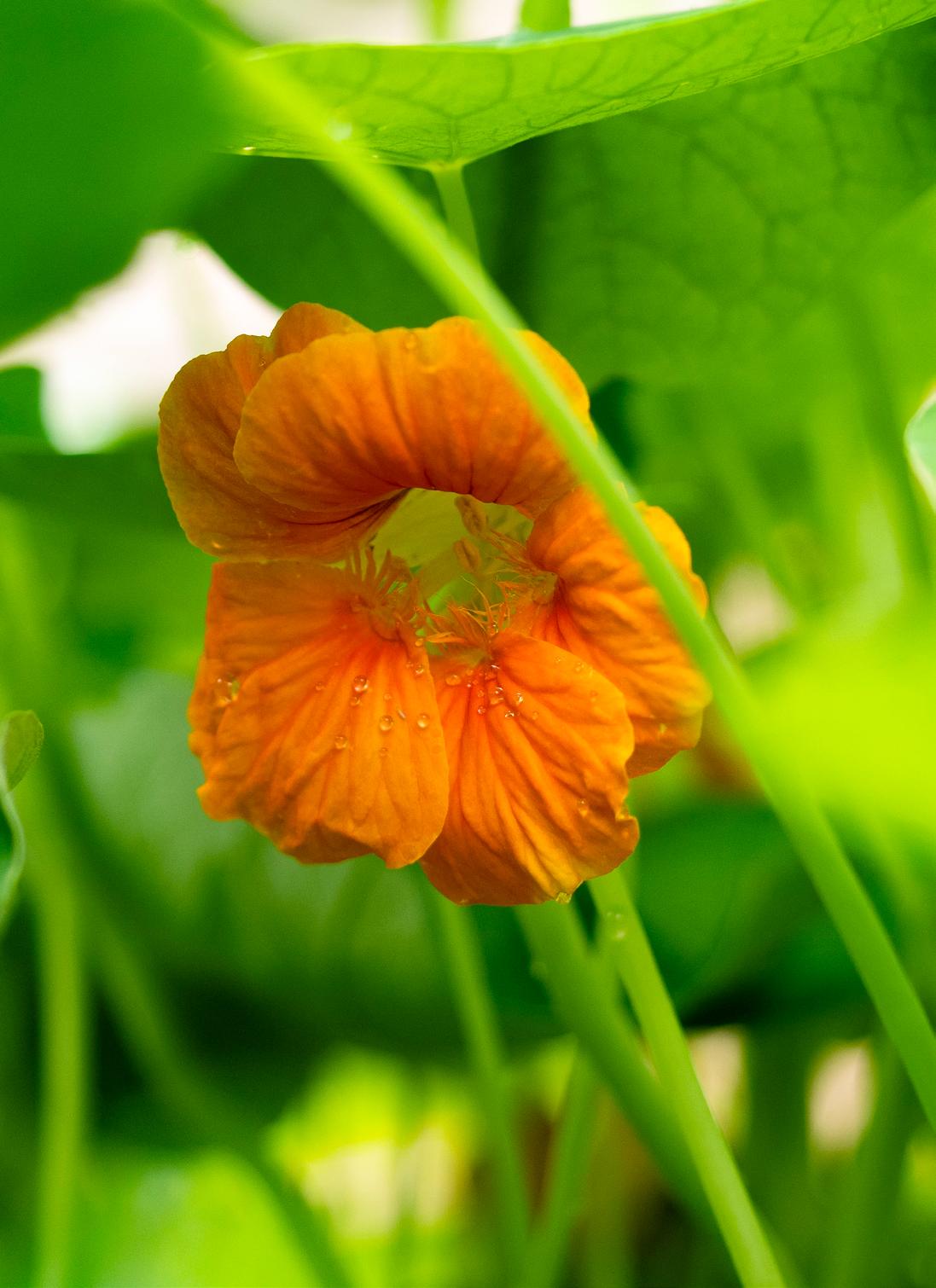
based preschools in the state. We believe that this philosophy is the most developmentally appropriate for children and the passion for outdoor education shines through in our staff. The Nest is extremely active in the nature-based education world and hopes to be a beacon for others looking to move towards this path.
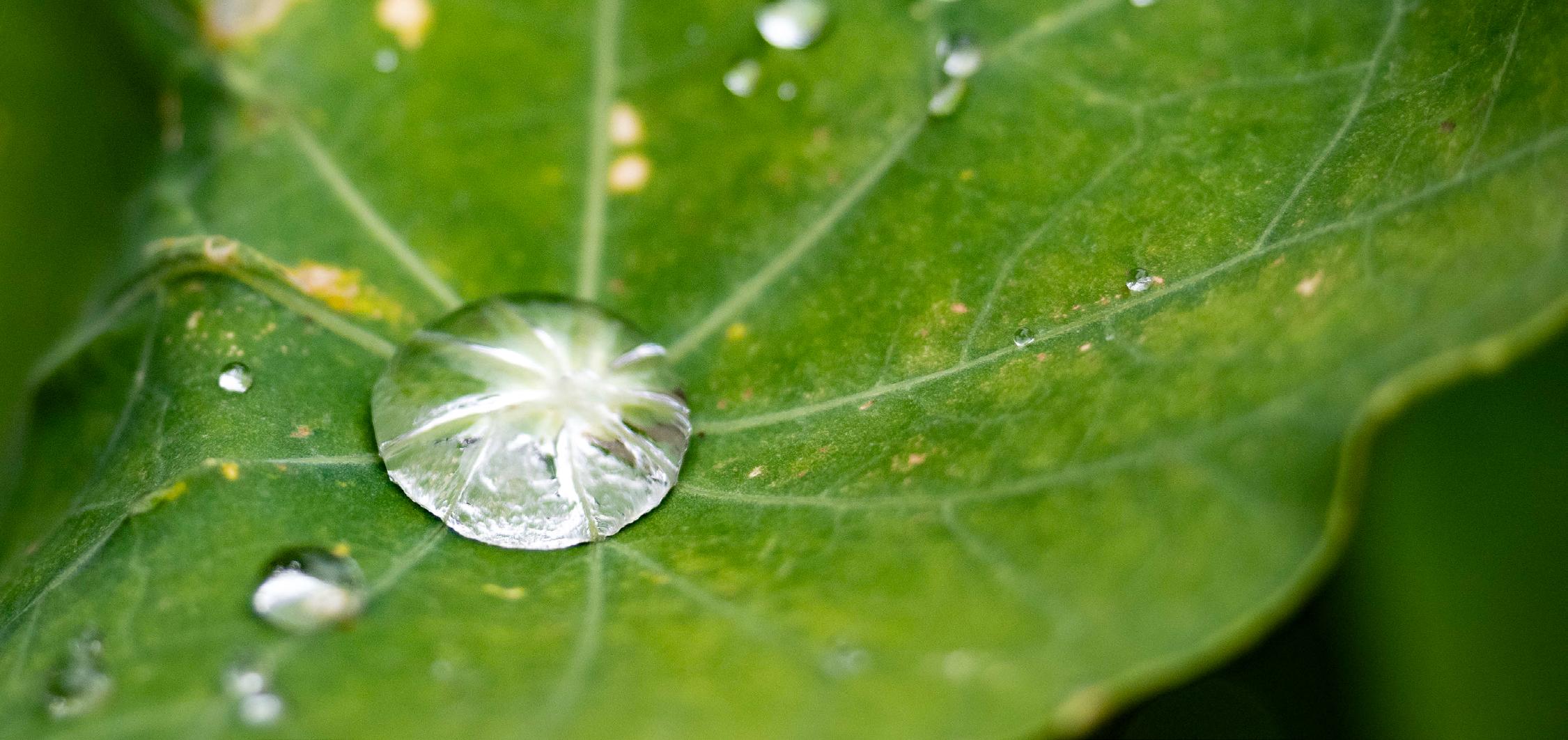
Many of us who enjoy the trails at The Cibolo Center for Conservation have found ourselves marveling at the beautiful sights and sounds of birds hopping, chirping, and singing while out on a walk with family, friends, or other volunteers surveying various habitats throughout the nature center and Herff Farm. But many would be surprised to learn about the once destructive tradition inflicted upon birds in the late 1800s. Instead of admiring and counting birds, people would partake in the “side hunt,” where they would shoot as many birds and small mammals as they could find for sport on Christmas Day. This competition led to sharp declines in bird populations throughout North America, spurring an effort led by Ornithologist Frank Chapman to get citizens to trade their rifles for binoculars and record bird species instead of killing them. This Christmas bird census, now known as the Audubon Society’s Christmas Bird Count, is the longest-running citizen science project in the
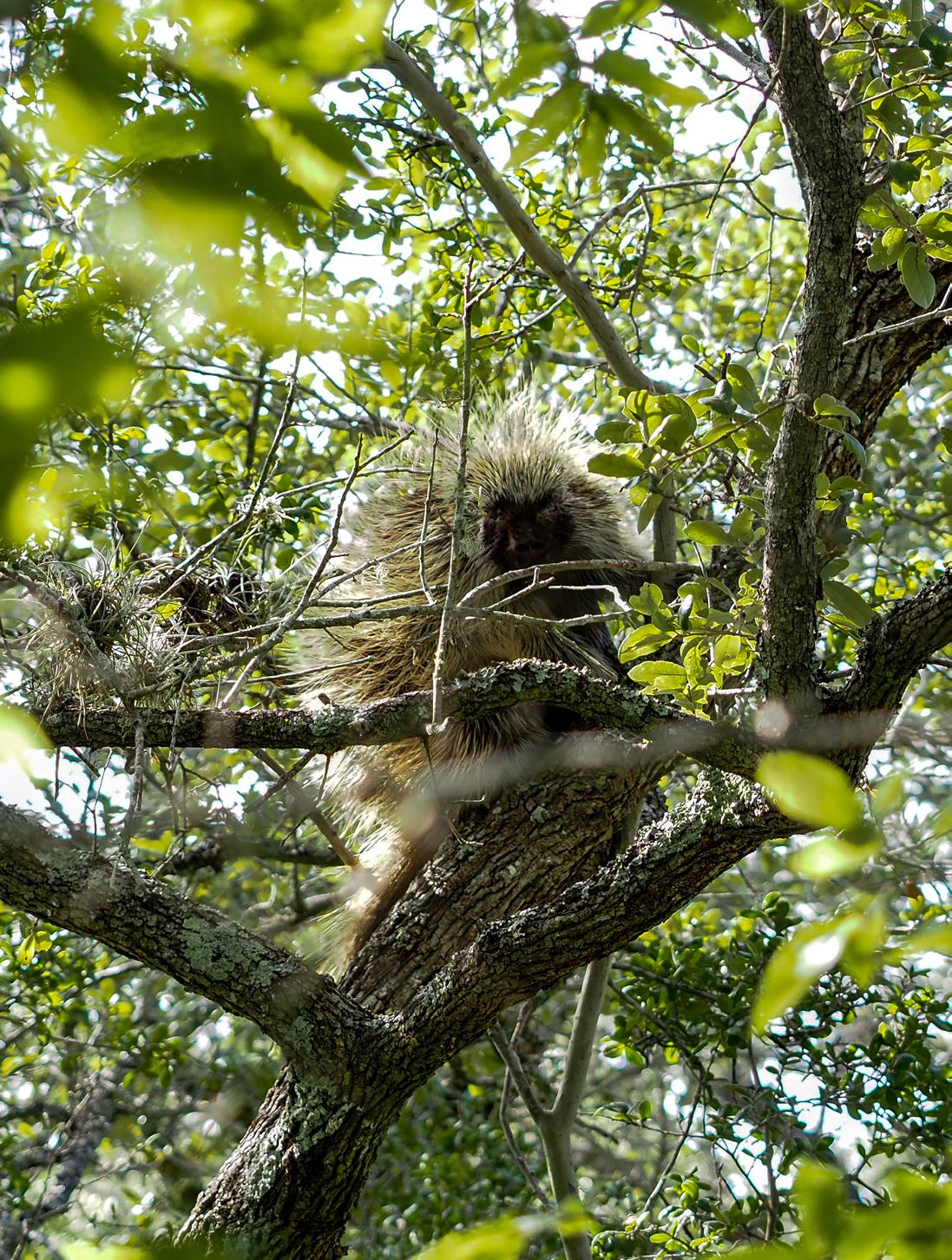
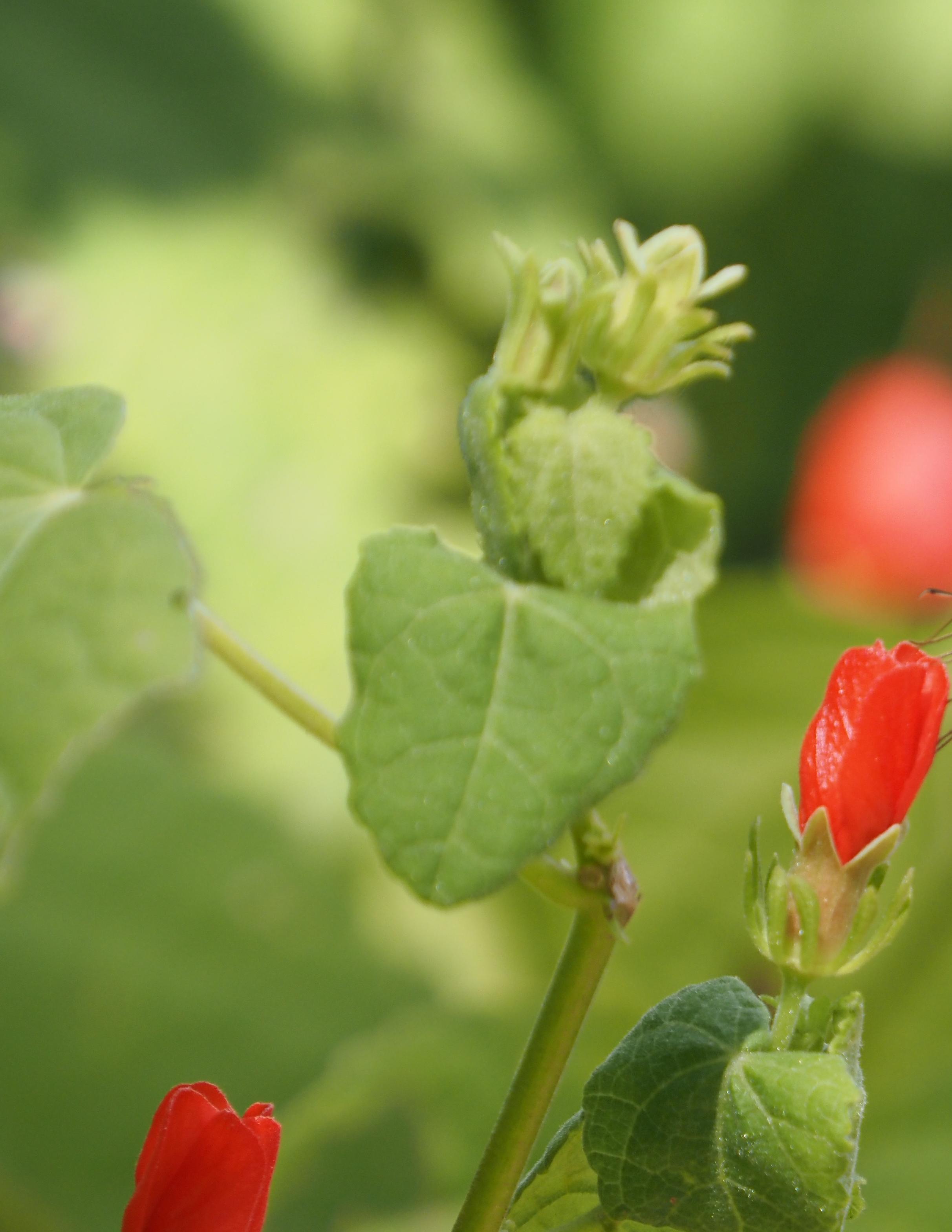
Sarah Vergara Research Scientist
world. Over 64 million birds are counted each year across the US and internationally.
Another success story involves Frank and Norah Urquhart, who studied the migration of monarch butterflies. Fred was a Canadian zoologist deeply interested in studying monarch migratory pathways. Together with his wife Norah, they reared monarchs and developed a tagging method that involved a pressure-sensitive adhesive label with a unique identification number to track the monarchs from north to south. Norah wrote to various magazines in US cities and Mexico, calling for volunteers to help tag and report sightings. With the help of an amateur naturalist and locals in Mexico, they found the monarchs blanketing the ground and trees at their overwintering site in the Neovolcanic Plateau, where millions reached their destination. During their exploration of the site, they even located one of the eastern migrants displaying a tag that fluttered all the way down from Minnesota to Mexico. From Project Feeder Watch, where you can observe and record the number of bird species outside, to river and weather monitoring, there are numerous inspiring community science efforts across the world.
For over 20 years, The Cibolo has engaged with local citizens in community science efforts. These projects range from monitoring milkweed and water quality to surveying birds, plants, wildlife, and aquatic life along Cibolo Creek. Many of our volunteers have been community scientists since the late 90s and early 2000s, contributing to our monthly bird surveys, seasonal Bluebird Nest Box and Great Heron Rookery monitoring, and the bi-annual Wildlife Field Research Week. During one week every fall and spring, The Cibolo relies on nearly 200 community scientists to conduct surveys ranging from prairie vegetation, small mammals, reptiles and amphibians, fish, flow, and macroinvertebrates.
Community scientists have been vital in helping us understand the ecological state of The Cibolo since its inception in 1988 and help inform our
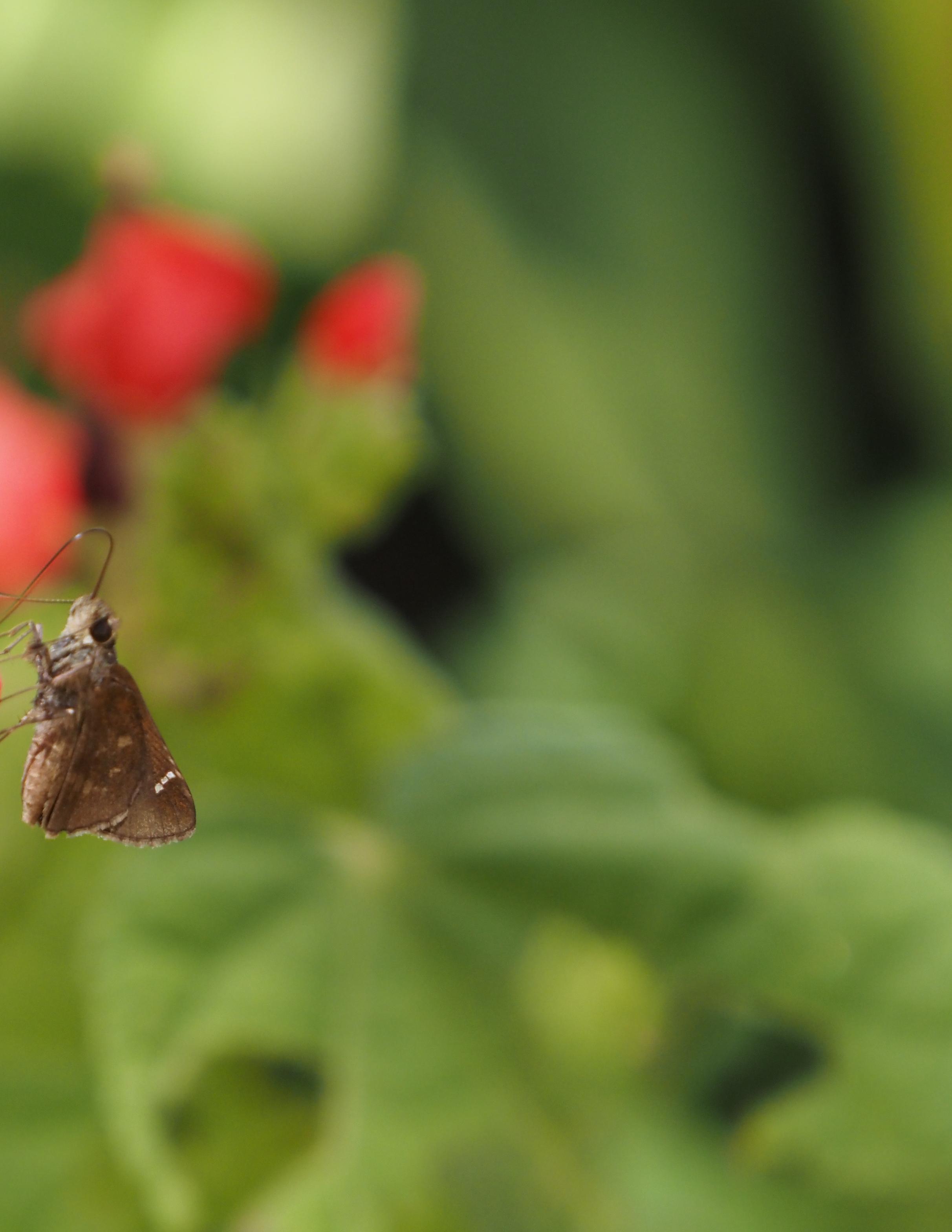

land management practices. For example, the riparian woody plant survey gives us an idea of how many invasive species in the riparian area of the creek need to be removed. Similarly, the prairie vegetation survey can show the presence or absence of woody plant encroachment in the prairie and inform us if our prescribed fire methods are working.
Community science can bring diverse groups of people together for a common purpose to tackle local, regional, and national environmental issues. Many volunteers mention their desires to explore their hobbies, improve their health, and contribute to scientific research as reasons to engage in this work. The benefits of community science are not limited to participants but also extends to researchers. It expands our quality data collection, helping improve critical thinking skills and understanding of the scientific method. Plus, it draws people outside to explore their natural surroundings, engaging their scientific curiosity and creating a sense of purpose and place.
For example, people can record rain gauge data and upload it to the Community Collaborative Rain, Hail, and Snow Network (CoCoRaHS). Precipitation data is important and highly variable since data sources are few and rain gauges can
be far apart. For example, one location in a city or county may record little precipitation while another gets several inches. The data has been used by organizations such as the National Weather Service to improve weather modeling. NOAA’s River Network has also used the data to fill in gaps and ensure the accuracy of river forecasts. It has also been used in National Hurricane Center Tropical system post-storm analyses to describe the overall impacts of an event.
iNaturalist bioblitzes are another great way to fill in the gaps of species data collection. They can inform scientists about species distributions or allow researchers and students to study species of interest that you located at a local park or green space. With some training, practice, and passion you too can become a community scientist! Please consider joining us for our Fall 2024 Wildlife Field Research Week from Oct.6th-12th. Teams of community scientists will gather once again for a week filled with fun, learning, and science.
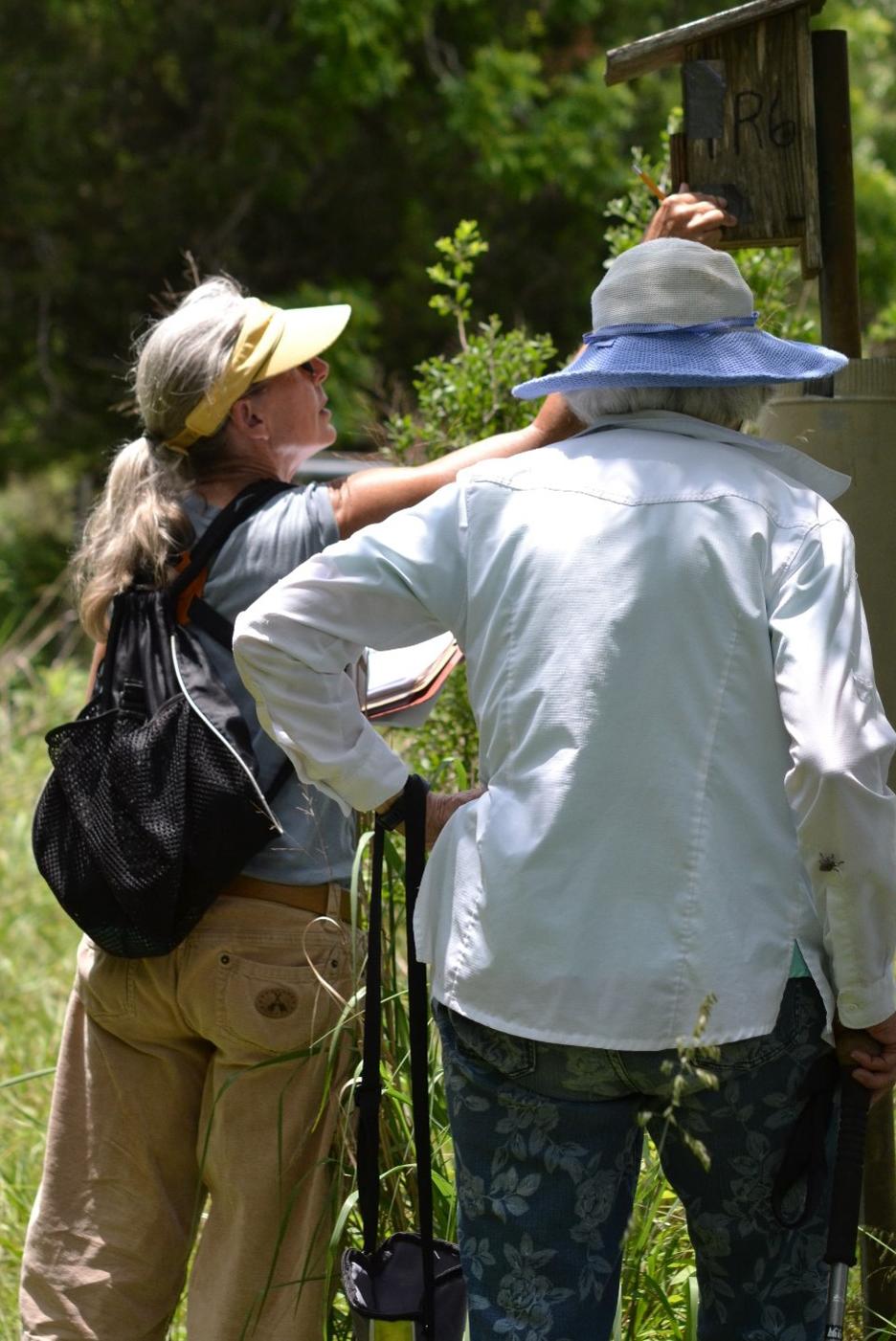
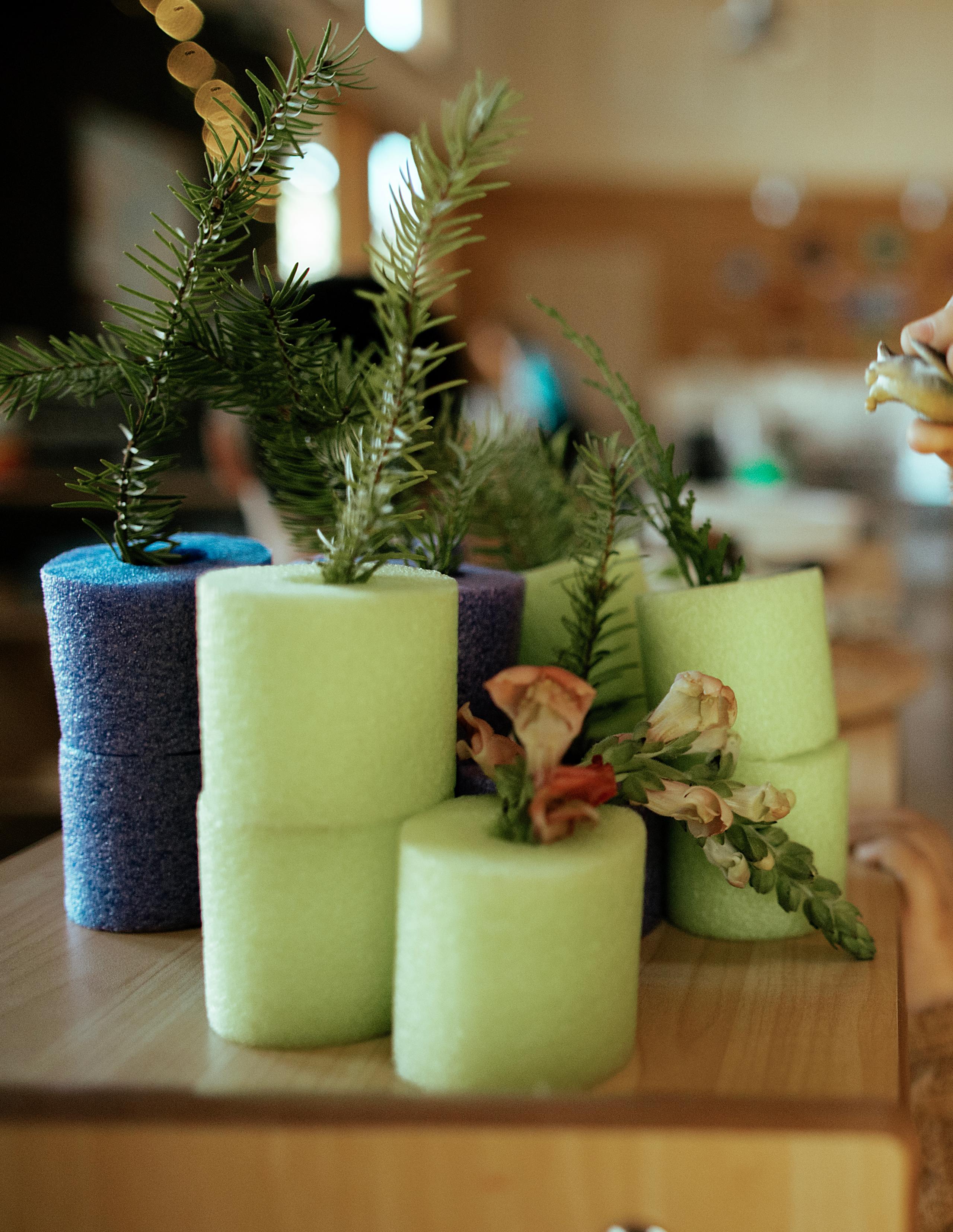
Dianna Hopkins Chief Development Officer
When we care for the land, the land cares for us.
This season, we call on community members to invest in tomorrow’s green spaces and bright minds. As the year draws to a close, we’re reflecting on what truly matters—our connection to nature, our responsibility to the environment, and the future we are building together. At The Cibolo, this work is more than a mission; it’s a promise to our community and the land we call home.
By contributing, you help protect over 160 acres of precious Hill Country land. Your support ensures that vital habitats thrive, our local wildlife finds sanctuary, and future generations inherit a world where nature remains abundant.
“The Cibolo is now protecting hundreds of acres of precious watershed, instilling in tomorrow’s leaders a deep appreciation for the environment, and providing access to nature and the unique healing only it can provide.” - Brian Davenport
Your donation fosters environmental education for thousands of students, from elementary field trips to hands-on science research for teens. Each dollar sows the seeds of curiosity, responsibility, and leadership in our young people, shaping the next generation of environmental stewards.
“Being outside is the most beneficial thing for these kids. It’s truly a third teacher.” - Alysa Meeks
We’ve seen how the magic of nature can transform lives. Whether it’s families enjoying time together at the farmers market, children finding their place in the world through our camps, or individuals discovering peace on our trails—your support makes these moments possible for all.
“It is one person after another, shaking the next person’s hand and showing them the beauty of The Cibolo.” - Kathryn Gregory
This year, we’re asking you to be part of something bigger. Your gift doesn’t just sustain us—it multiplies the impact on the people, the land, and the future we all share.
Give today by visiting cibolo.org/donate or mail a check to our offices at: 140 City Park Road, Boerne, Texas 78006.
Let’s promise a healthier, more connected tomorrow. Let’s grow a future that matters.
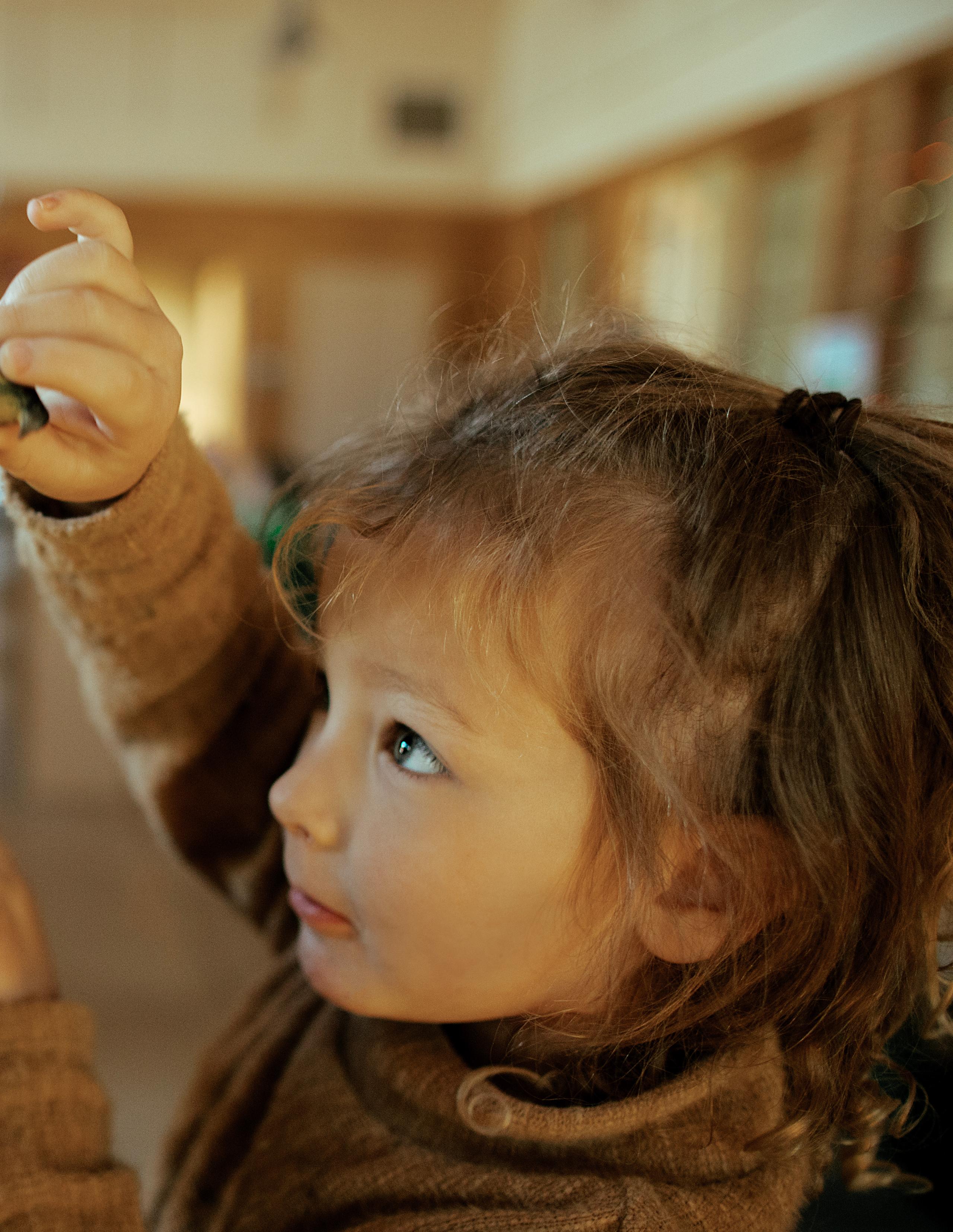
Purchasing items from The Cibolo’s Amazon Wish List is a direct and impactful way to benefit our work. Items listed are needed for our nature education programs, The Nest Nature School, and research science: cibolo.link/wishlist
Have any unwanted tools or hardware laying around? We appreciate any donated shovels, drills, chainsaws, saws, lathes, rakes, sanders, hammers, sledge hammers, 5 gallon buckets, water tanks, and welders to support the everyday operation of land stewardship at The Cibolo.
Our new project with Boerne Radio is going to be exciting! It is also a lot of work and there is an associated, not insignificant, cost. We believe this endeavour is a huge step forward in presenting ourselves and our mission to the community in an updated and thought provoking way. We are looking for a sponsor who is willing to join us in addressing the community each week with content that is interesting to a wide audience and relevant to the work we are doing at The Cibolo. Our partner will be recognized in every episode of the show which will air on Boerne Radio at 9am every Saturday and will live on as a podcast available on-demand worldwide. If you might be interested in partnering with us, and in turn promoting your business, family foundation, etc. we would love to discuss the possibilities with you. If you love Boerne, Boerne Radio, The Cibolo and the community we are a part of, this is a terrific opportunity to be part of something new at the ground level that will influence and inspire well into the future. To discuss this opportunity in detail please contact coms@cibolo.org.
John Freud
President
Desiree Whitney
Vice President
Mark McCurley
Secretary
Jeremiah Leibowitz
Treasurer
Leslie Brown
Corbett Christie
Nancye Druckker
Michelle Ernst
John Leonard
Jonathan Piper
Marilyn Tremper
Joanne WIlliams

Emeritus
John Brazil in memoriam
Guy Chipman in memoriam
Juanita Chipman
Brent Evans co-founder
Carolyn Chipman Evans co-founder
Tom Frost, Jr. in memoriam
Roger Hemminghaus
Tim Hixon in memoriam
Joan Kelleher in memoriam
The Cibolo Center for Conservation exists to promote the conservation of natural resources through education and stewardship. We are transforming lives through the love of nature resulting in gratitude, love and a community of belonging in the heart of the Texas Hill Country. To get involved or more information visit cibolo.org or come by the nature center at 140 City Park Rd Boerne, TX